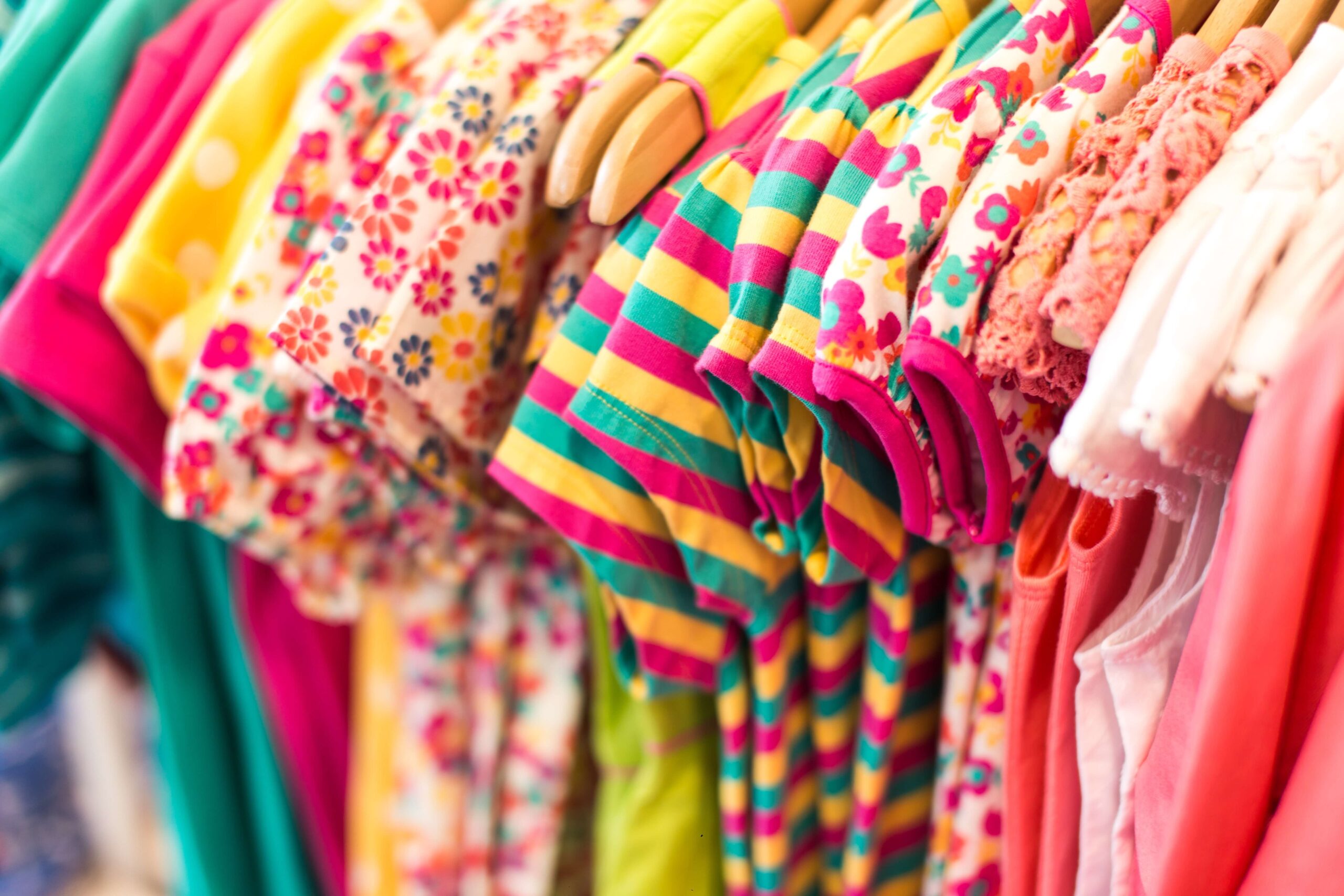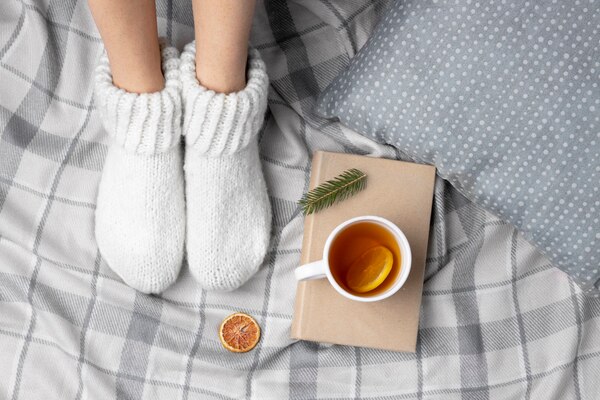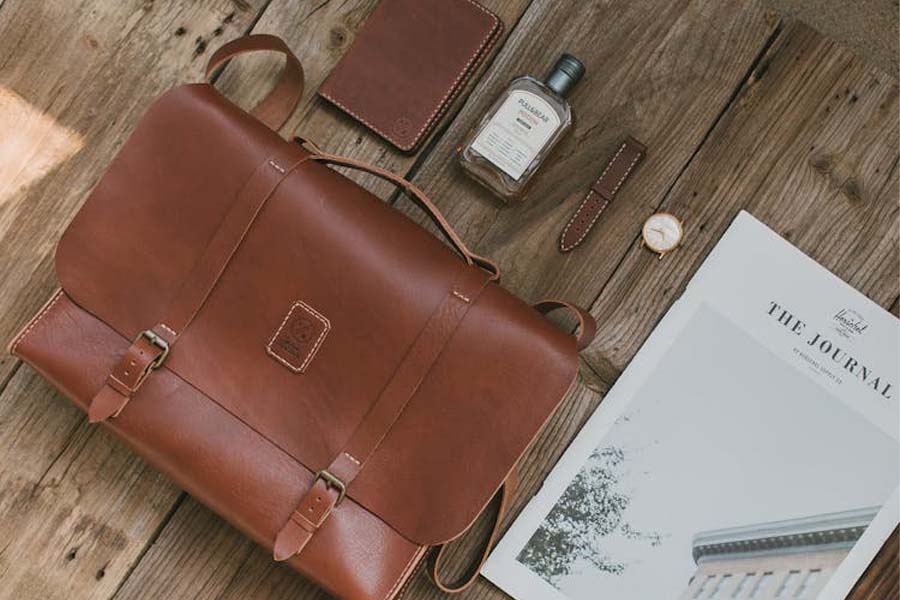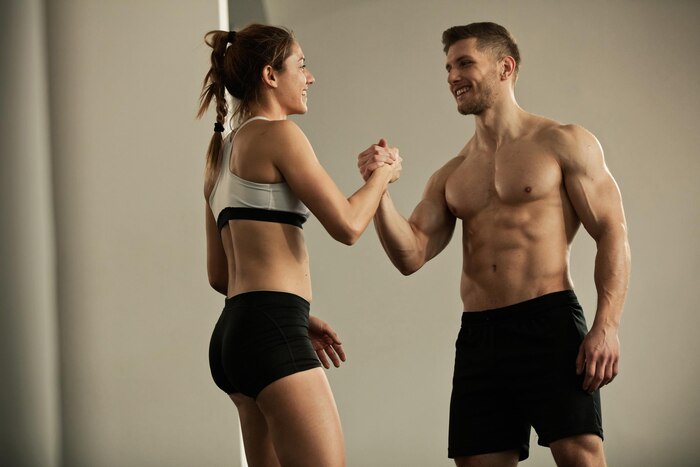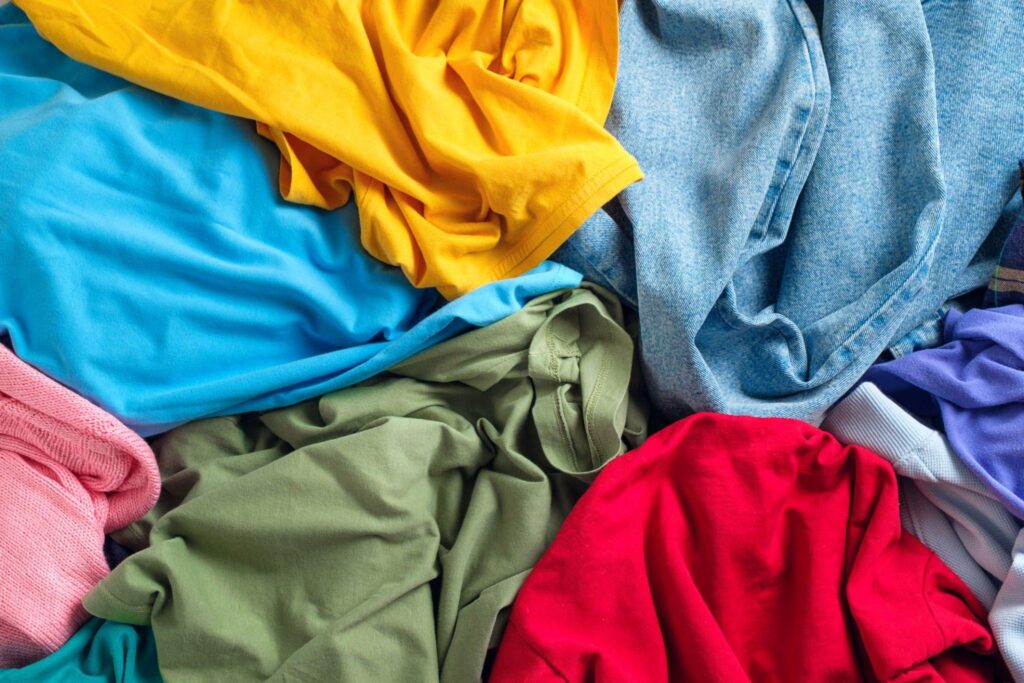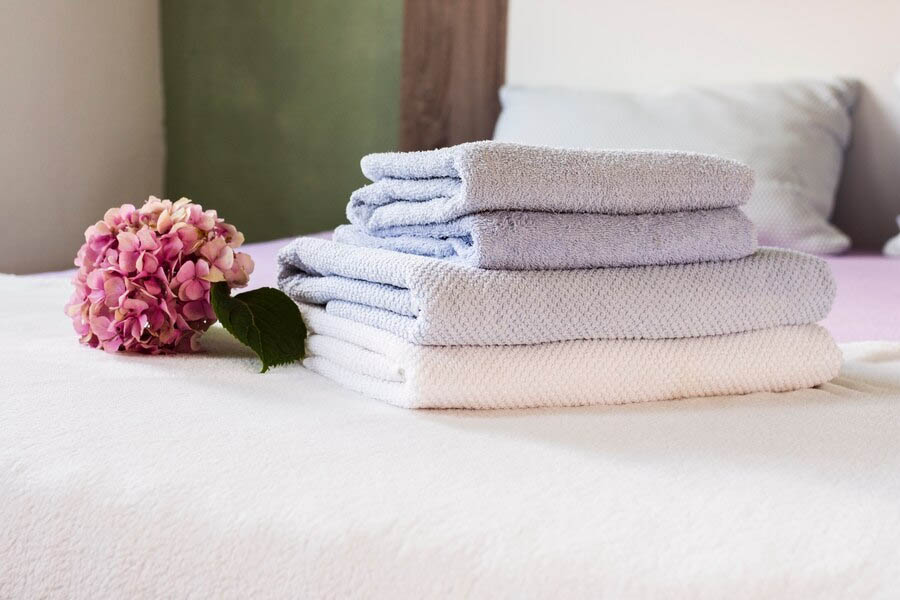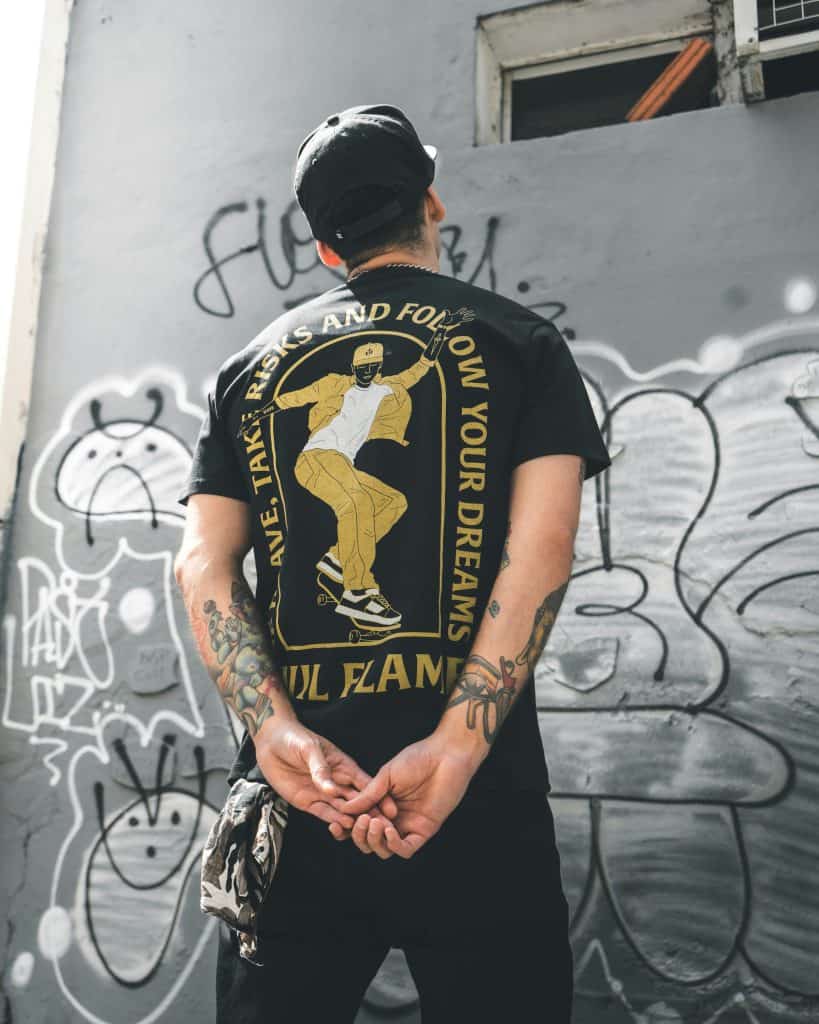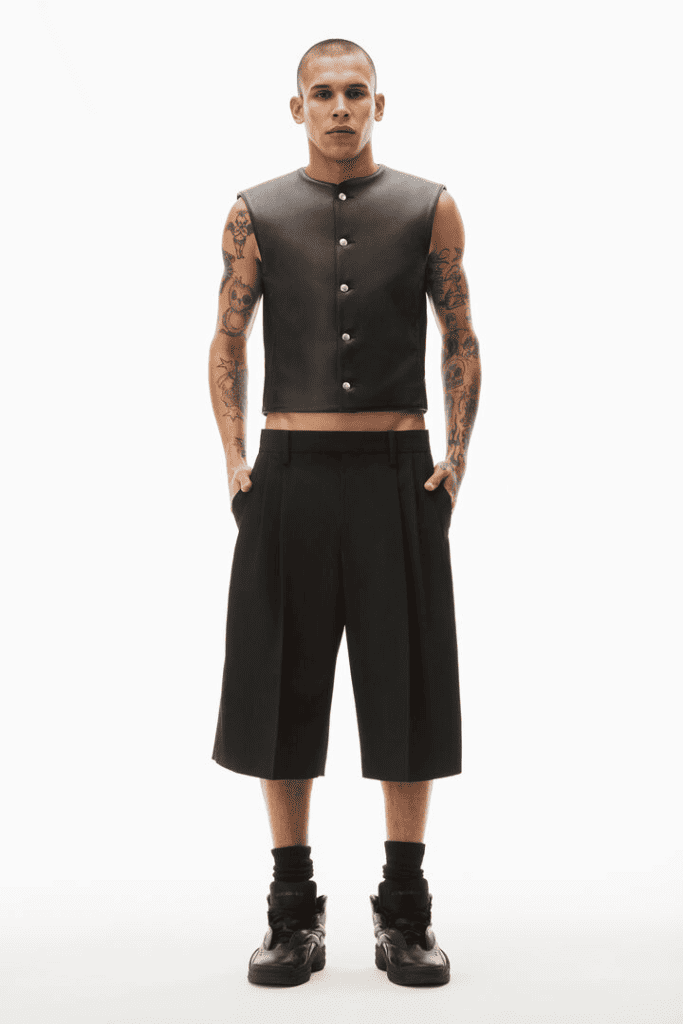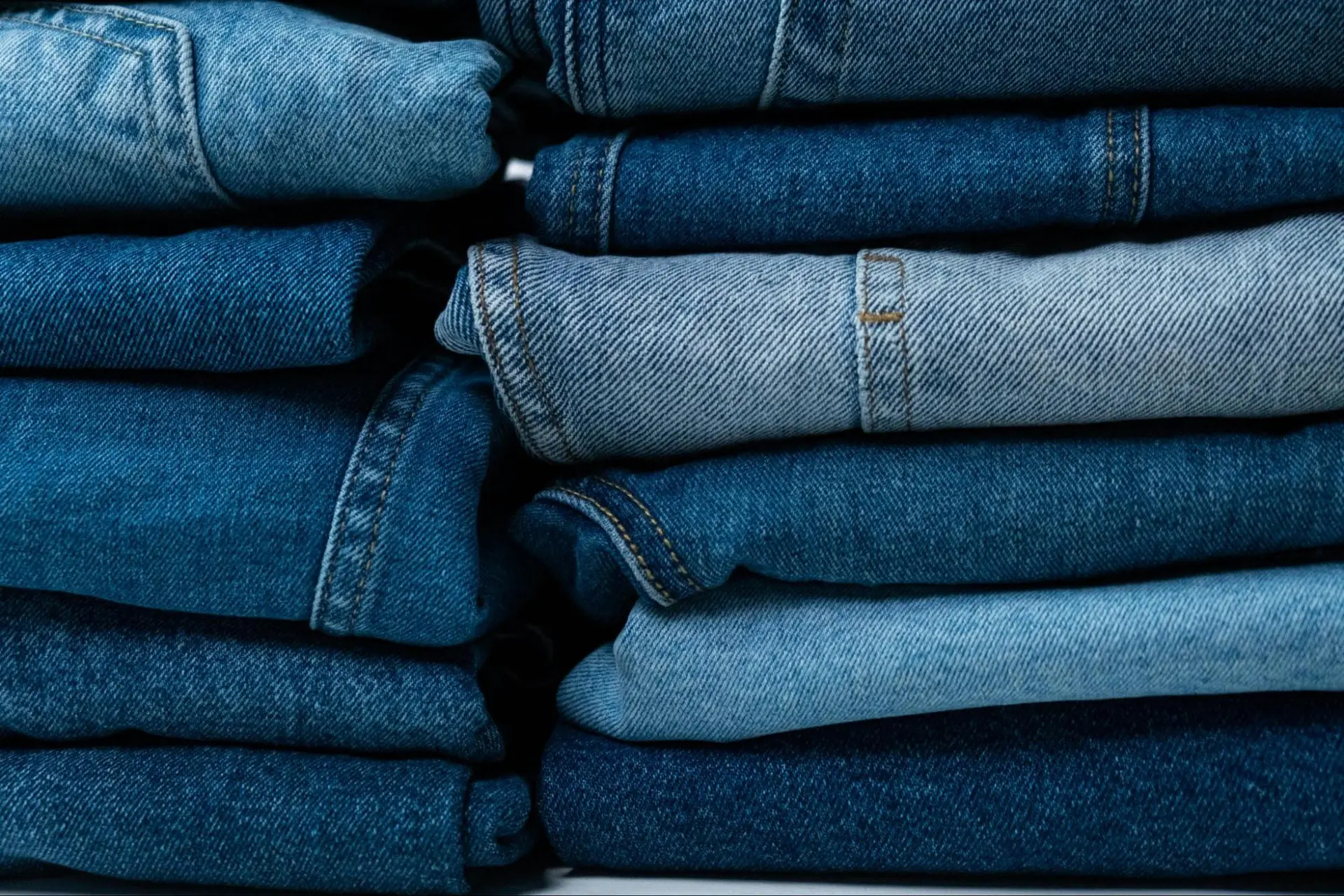
Jeans, loved for their durability and timeless appeal, blend practicality with fashion. Perfect for both casual days and professional settings.
While various pants offer different materials and designs, jeans shine with their unique denim fabric and construction. Unique characteristics, like their specific weave, reinforced stitching, and signature rivets, give jeans their edge, boosting both durability and style.
Dive into the jeans manufacturing process with this article. Each step, from selecting the perfect fabric to adding finishing touches, plays a vital role. Discover what makes these iconic garments special and how they come to life.
Understanding jeans manufacturing
Picture a world where rugged denim is not just a fashion statement but a crucial element of survival. That’s the story behind jeans. In 1873, Jacob Davis and Levi Strauss revolutionized workwear with their invention of jeans during the Gold Rush.
Initially designed for miners, jeans have evolved into a global fashion icon. For nearly 150 years, they’ve adapted to reflect changing times.
Let’s journey from raw cotton to the stylish final product:
-
The cotton-to-yarn transformation
Cotton fibers spin into yarn, forming denim’s foundation. Dyeing the yarn with indigo creates that classic blue color. Warp yarns receive the deep indigo color, while the weft yarns stay lighter or undyed.
-
The weave of wonders
Following dyeing, looms weave the yarns into denim fabric. Weaving the yarns interlaces warp and weft, crafting the signature twill weave and diagonal pattern. After weaving, washing, brushing, and sanding refine the fabric’s texture and appearance.
-
The art of shaping
The finished denim is then cut into various pieces based on detailed patterns. These pieces are meticulously sewn together to form the jeans, incorporating features such as pockets, zippers, and seams. Every stitch is carefully placed to ensure both durability and style.
-
The distressing craft
This stage involves techniques like sanding and chemical treatments to achieve unique textures and a worn-in look. These methods give each pair of jeans its distinctive appearance.
-
The Finishing touches
Buttons, rivets, and labels are added, followed by a rigorous quality check to ensure the jeans meet high standards. Each step in this process is crucial in crafting the durable, stylish jeans we wear today.
Designing the perfect jeans
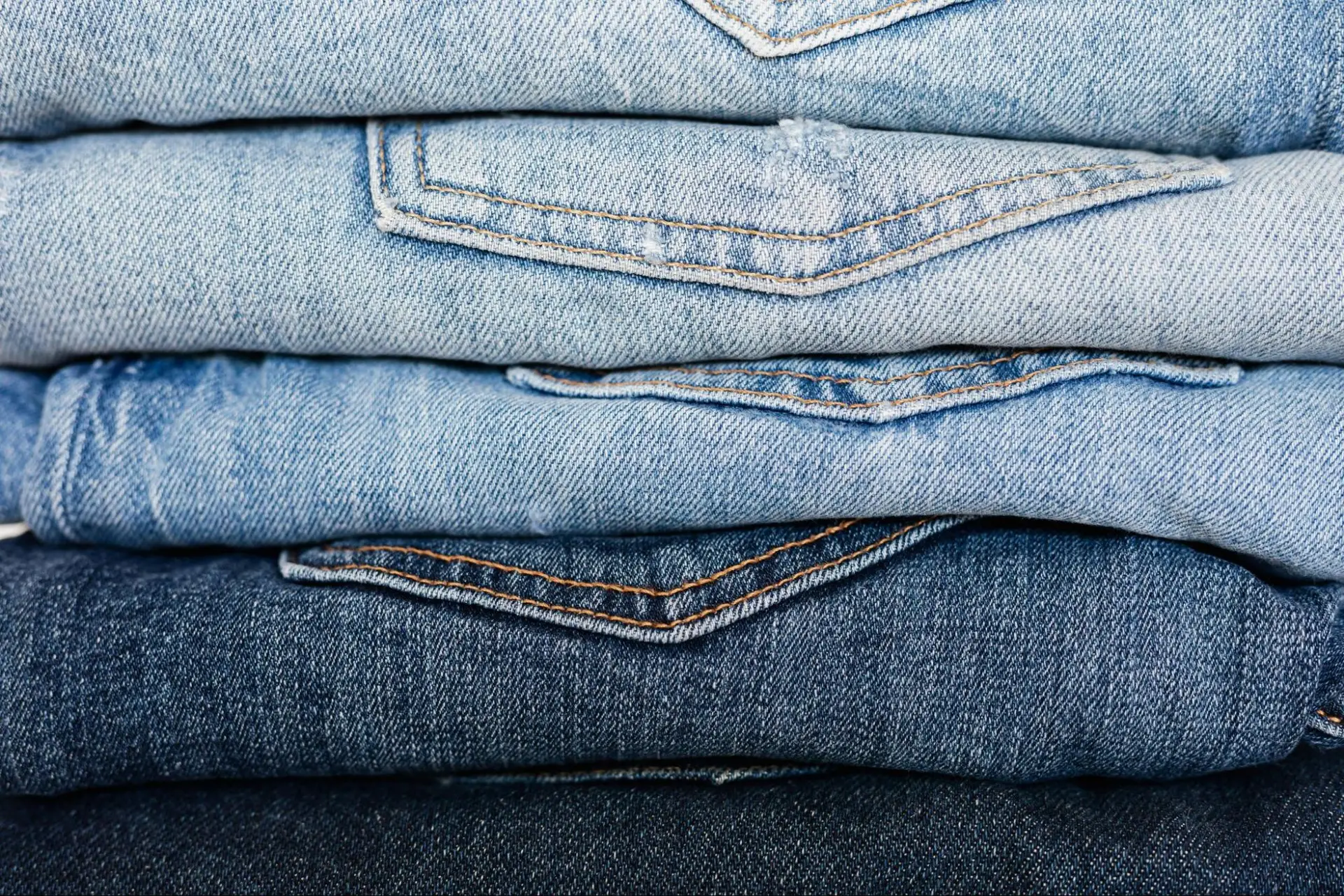
Creating the perfect pair of jeans demands a mix of creativity, strategy, and practical expertise. Designing jeans isn’t just about fabric and stitching; it involves numerous considerations.
Steps on designing a jeans
Let’s delve into the essential steps to craft jeans that meet high standards. These jeans should provide style, comfort, and appeal to a diverse audience.
1. Define your vision and audience
Start with a clear vision—whether you’re aiming for trendy, everyday comfort, or eco-friendly designs. Understand your audience, from young professionals to trendsetters, and research market trends to ensure your design stands out. Align your brand’s image with your target market.
2. Imagine your perfect pair
Envision your ideal jeans—consider the fit, color, and unique details like pocket designs and stitching patterns. Visualizing the final product ensures a design that balances style with functionality.
3. Perfect the fit
Aim for a fit that complements every body type. Choose styles like skinny, straight, or bootcut, and ensure precise measurements for waist, hips, and inseam. A perfect fit enhances both comfort and appeal.
4. Add unique touches
Select a wash and color that reflects your style, be it classic indigo, edgy black, or distressed finishes. Add unique touches like stitching patterns and hardware details to make your jeans stand out.
5. Prioritize functionality
Incorporate practical features like pockets, closures, and durable stitching. Consider pocket placement, closure type, and overall durability to ensure your jeans are stylish and practical for everyday wear.
6. Prototype, refine, and produce
Create prototypes to test fit and comfort. Adjust based on feedback, then proceed with production, applying quality control at every stage to meet your standards.
Follow these steps to design jeans that are not only stylish and functional but also cater to your target market. Embrace the journey and watch your jeans become a fashion success.
Types of jeans
After creating your jeans design, selecting the style that matches your vision is crucial. Explore some popular types that cater to everyone—men, women, and kids.
1. Straight leg/straight cut jeans
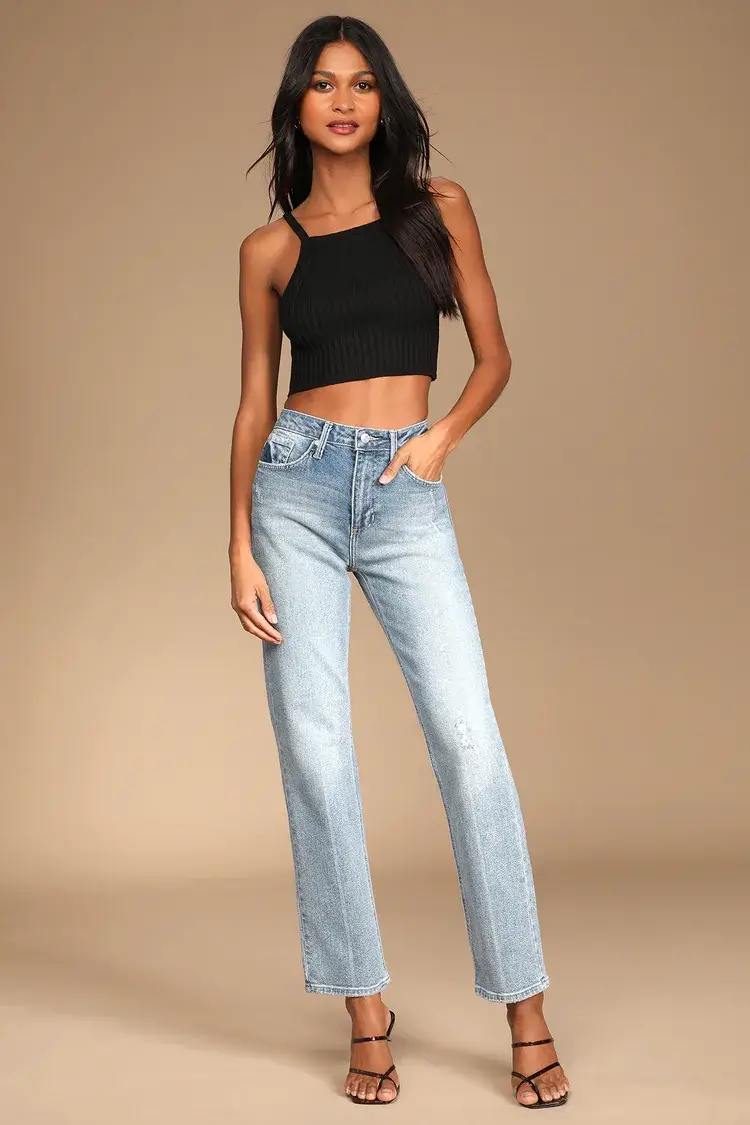
Source: Lulus
For a classic, polished look, try straight-leg jeans. Perfect with loafers or sneakers, these jeans offer a timeless silhouette that adapts to any occasion.
2. Slim fit jeans

Source: Parallel
Slim fit jeans hug the legs and taper at the ankle, offering style and comfort. A blazer or a tee would pair great with this.
3. Skinny cut jeans
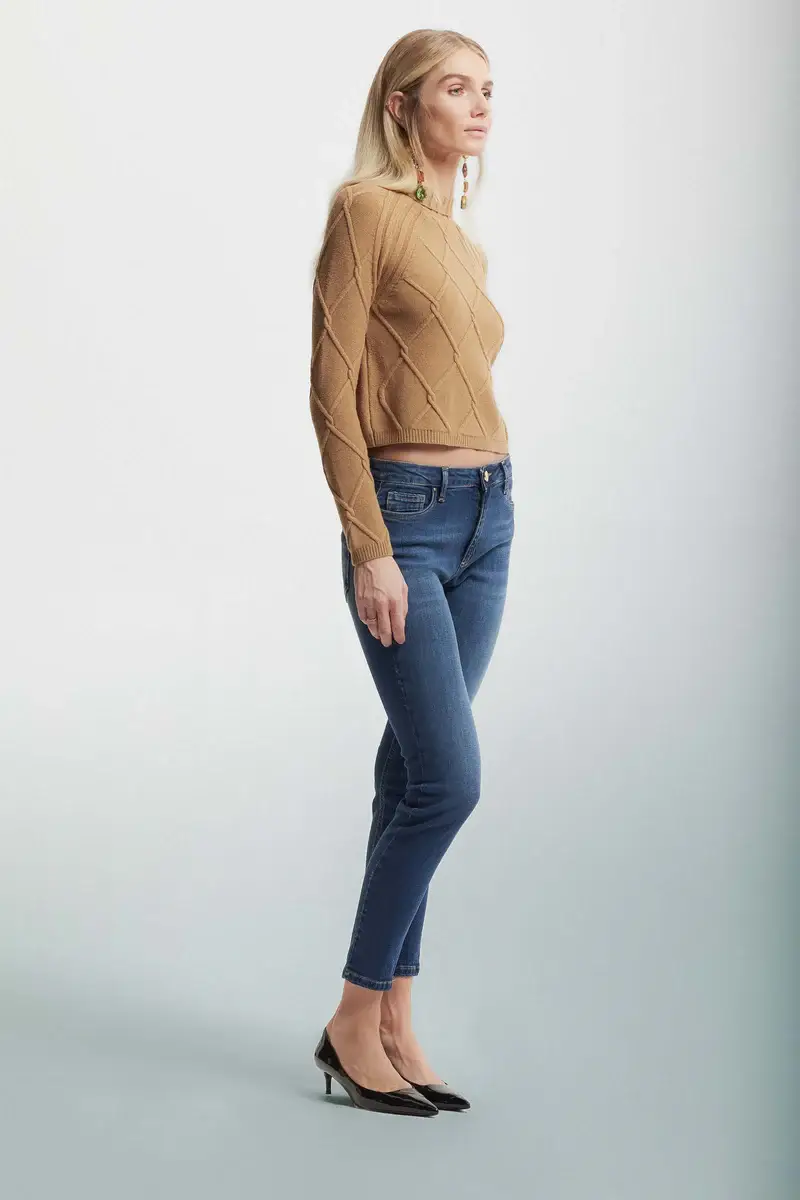
Source: Kocca
Showcase your silhouette with skinny jeans! Contouring every curve, they provide a sleek, modern fit. Pair with oversized tops or fitted ones to highlight your shape.
4. Boyfriend jeans
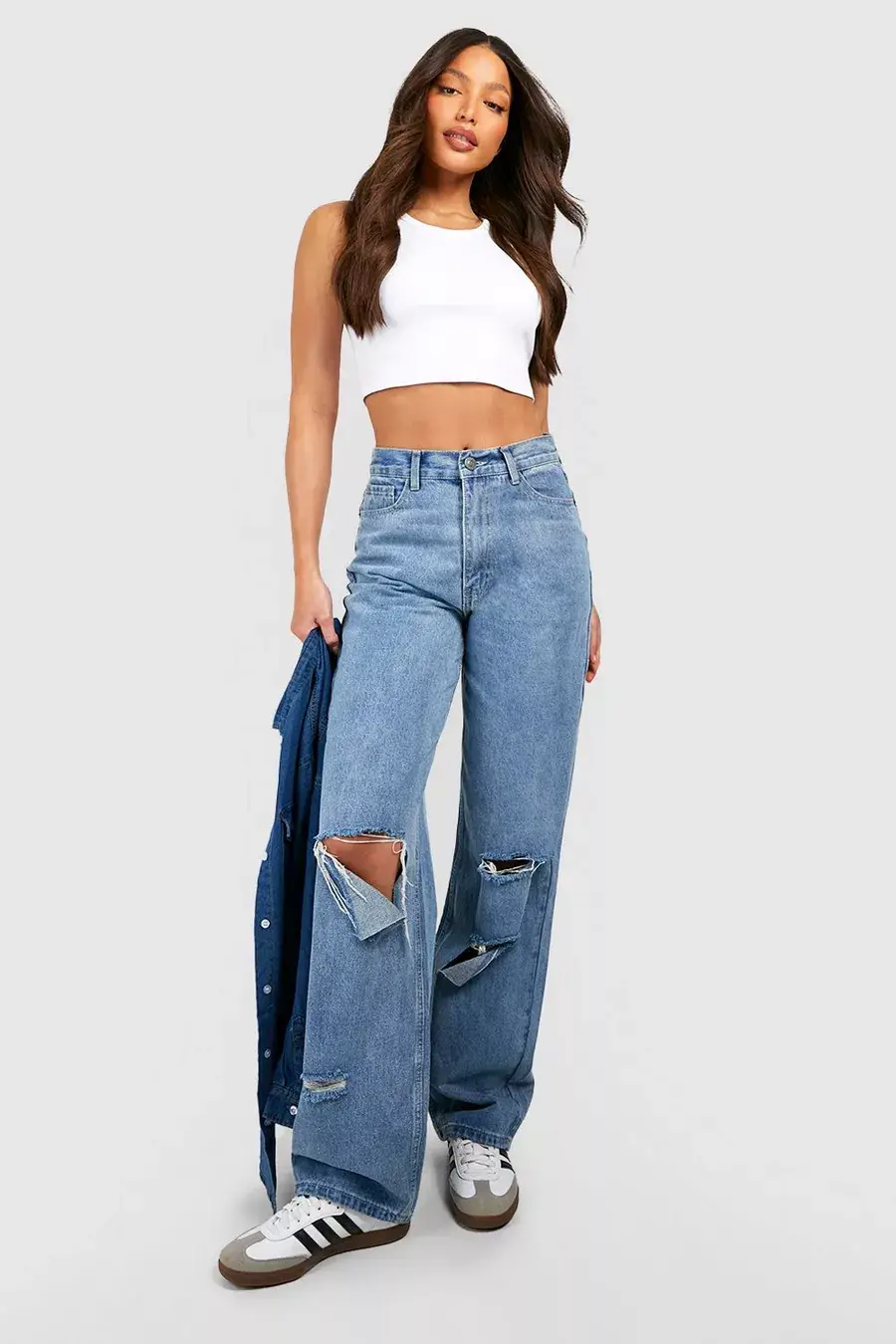
Source: Boohoo
For a laid-back vibe, boyfriend jeans deliver a relaxed fit with rolled hems, exuding a borrowed-from-the-boys charm. Style them with a fitted top and mix heels or sneakers for varied looks.
5. Flared cut jeans
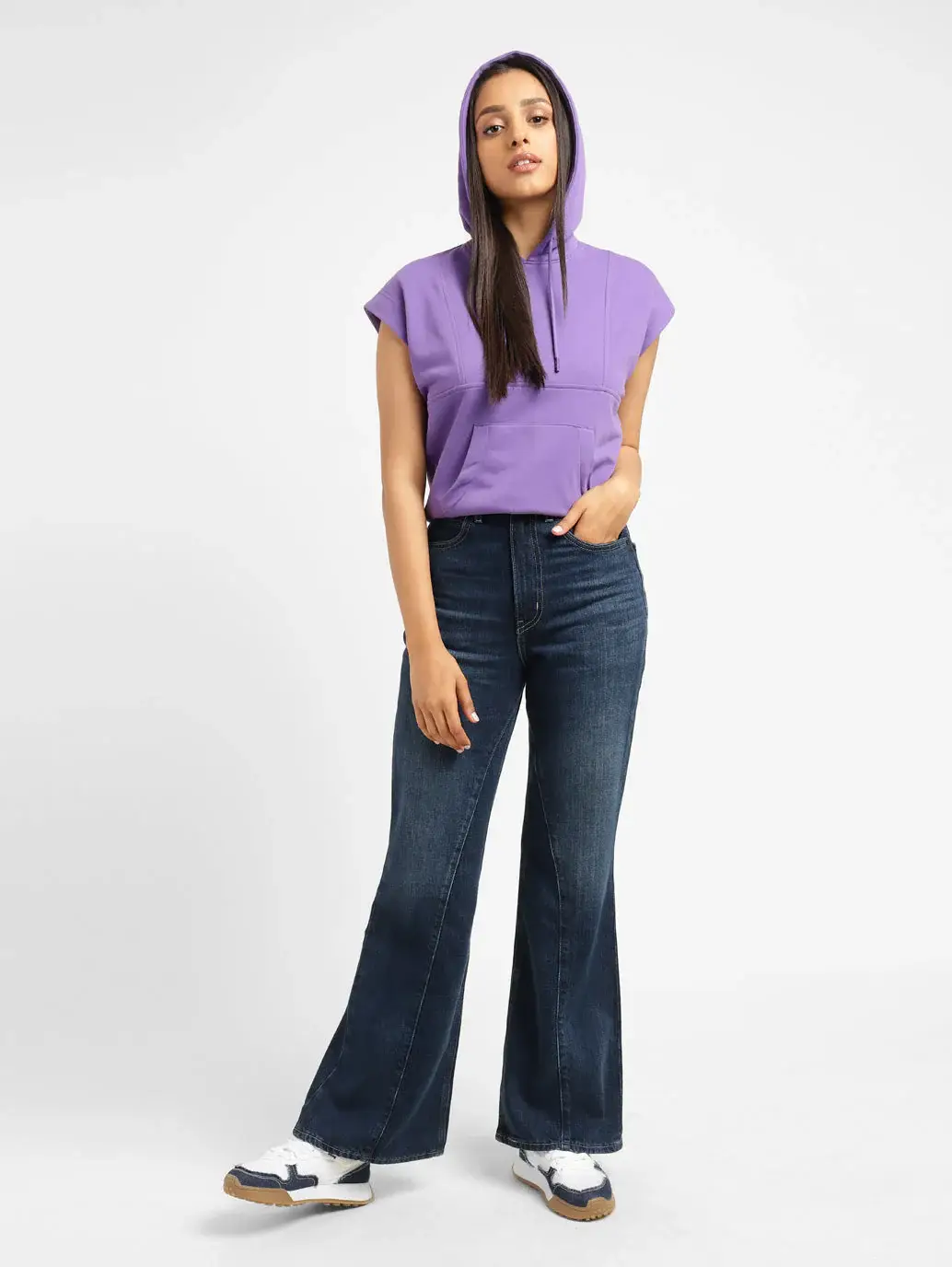
Source: Levi’s
Revisit the ’70s with flared jeans—fitted through the thighs and flaring from the knee. Elevate the retro look with heels or wedges!
6. Bootcut jeans
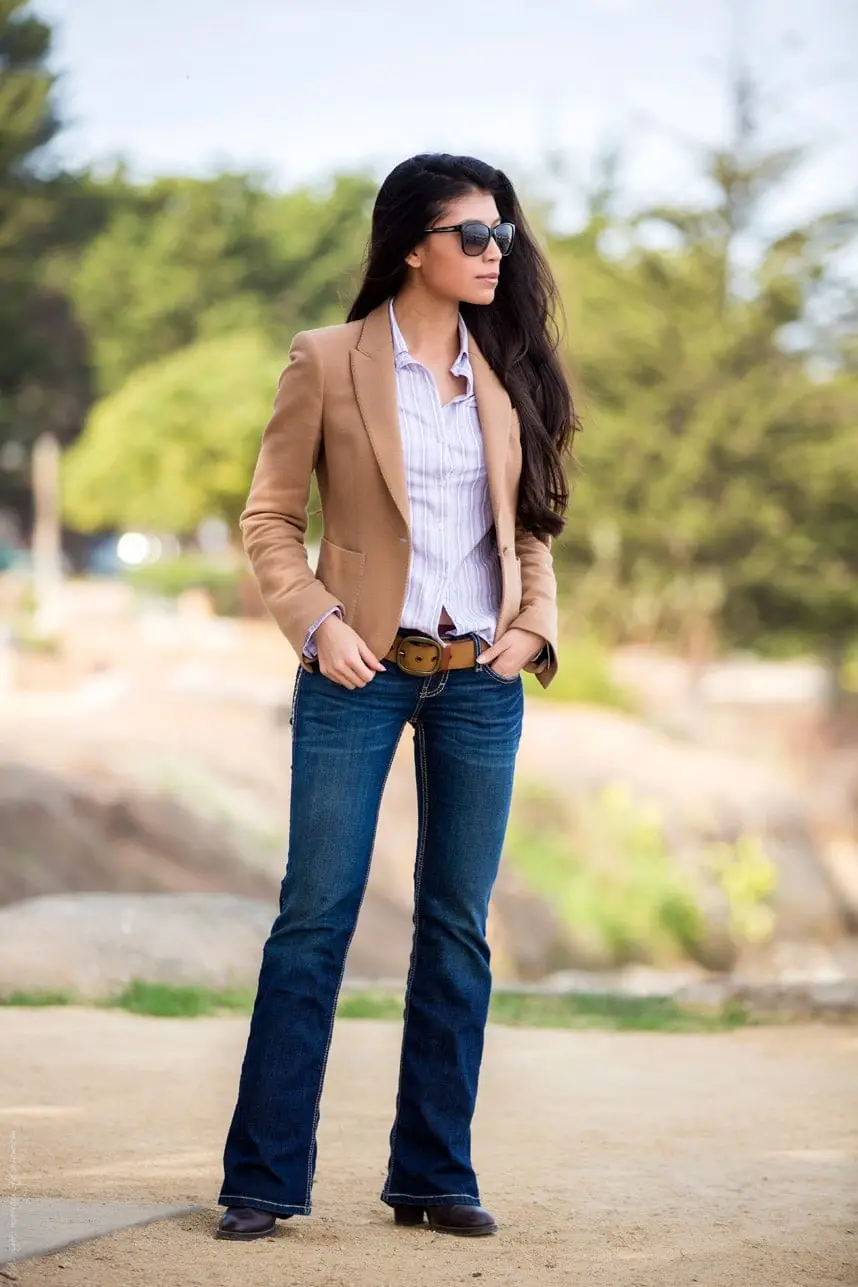
Source: Stylishly Me
With a slight flare to fit over boots, bootcut jeans offer a classic style. Perfect with cowboy boots or casual shoes, they pair well with a button-down or fitted top.
7. Wide leg jeans
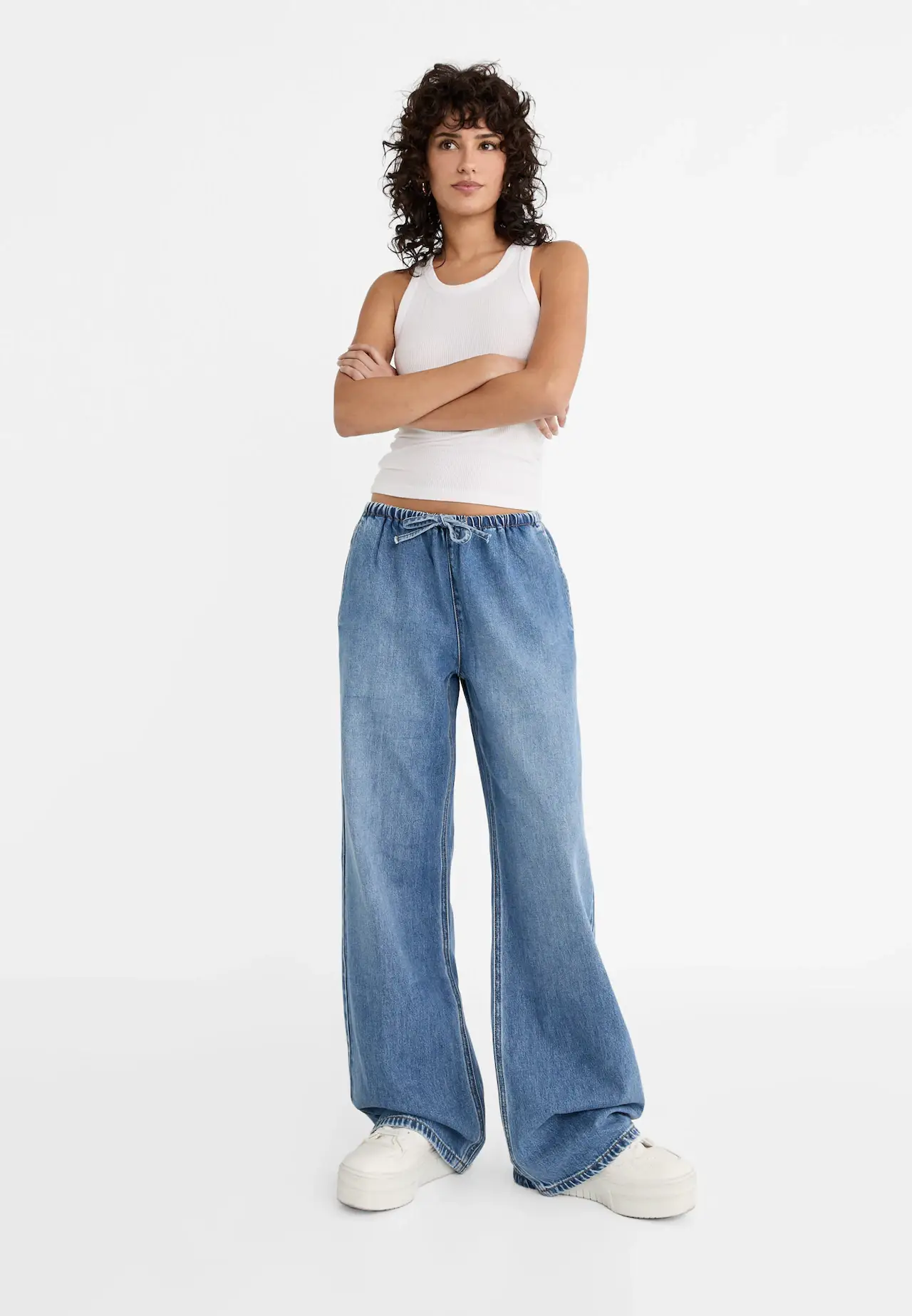
Source: Stradivarius
For maximum comfort and a fashion-forward edge, wide leg jeans are the way to go. Their flowing fit balances beautifully with a fitted top; platform shoes or chunky sneakers complete the look.
8. Tapered fit jeans
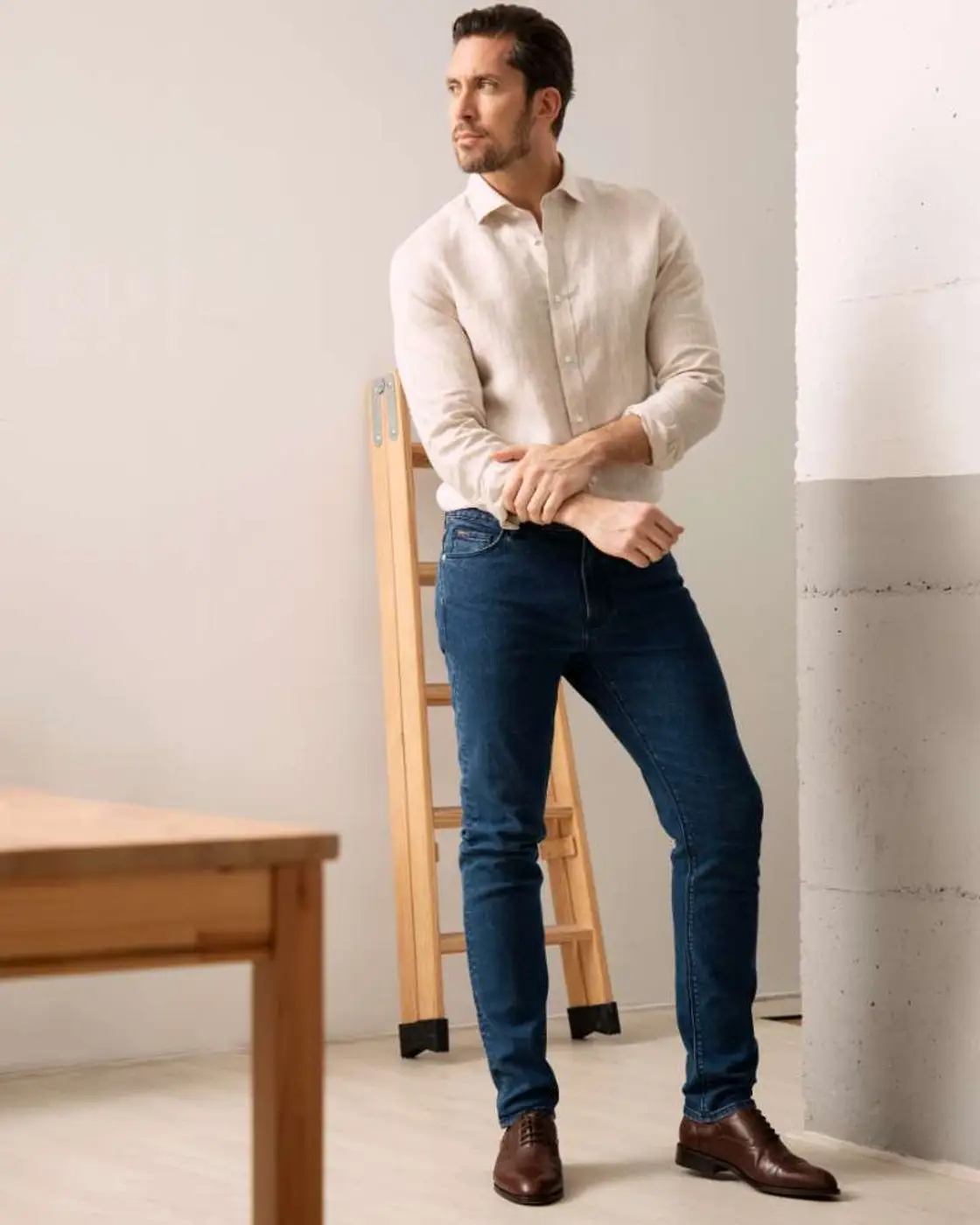
Source: Hockerty
Get a sleek, modern look with tapered fit jeans. Narrowing from hips to ankle, they provide a stylish, comfortable fit—ideal with casual shirts or sweaters.
9. Loose fit jeans
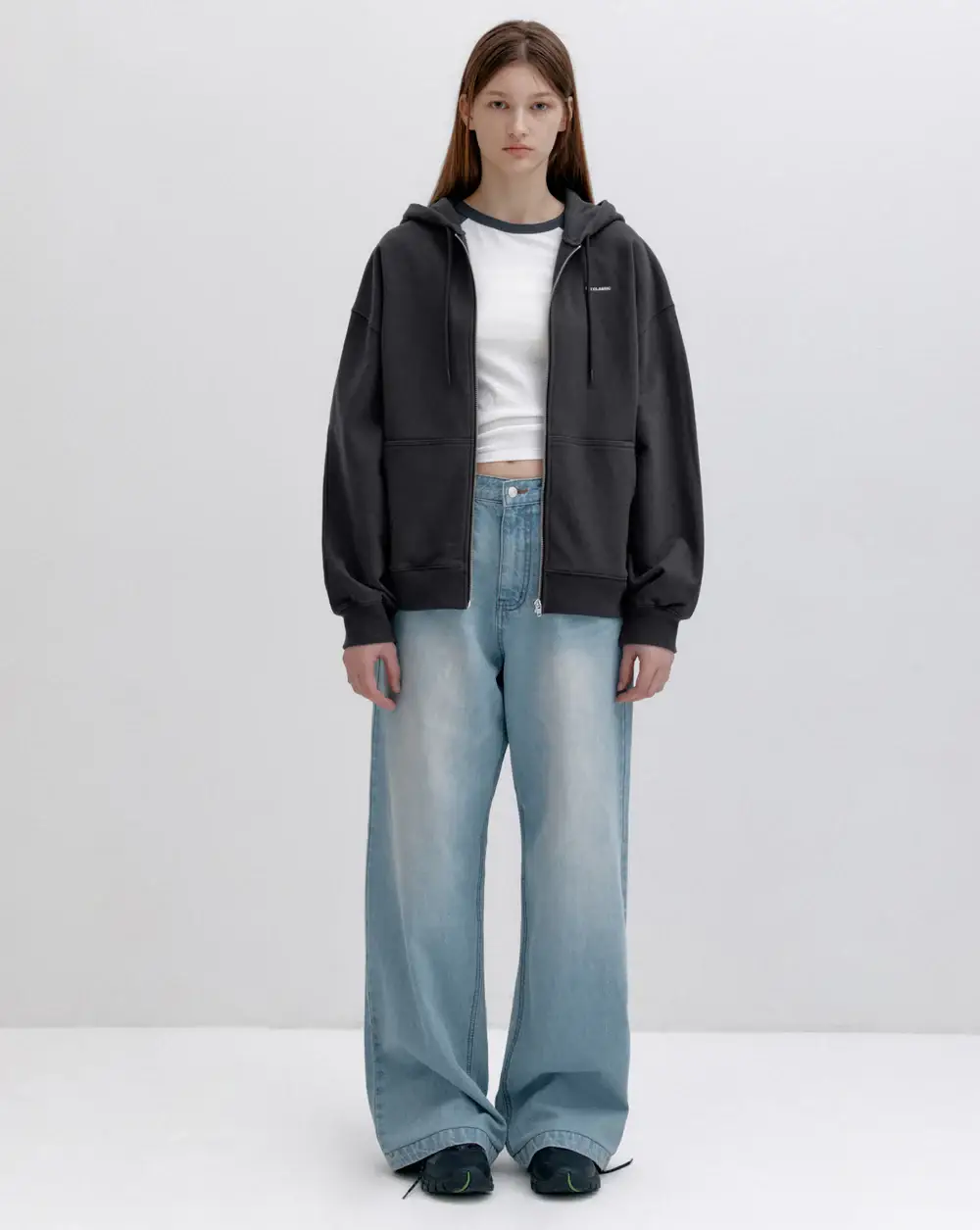
Source: workshop
Embrace maximum comfort with loose fit jeans. Relaxed throughout, they pair well with basic tees or hoodies and sneakers for a cool, street-style look.
10. Mom jeans
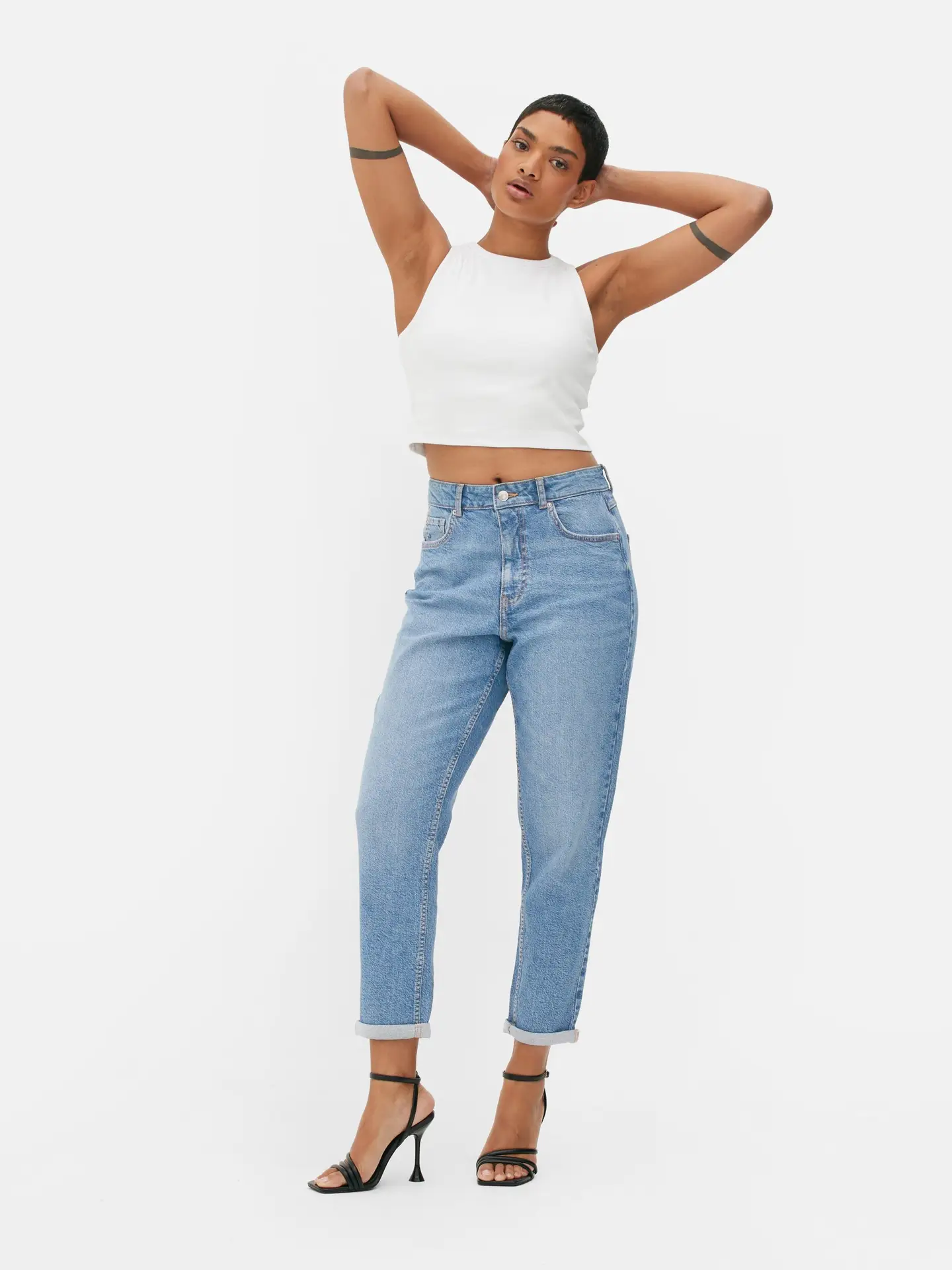
Source: Primark
Channel vintage chic with mom jeans. High-waisted and relaxed through the hips, they mix retro charm with modern style—tuck in a fitted top and add sneakers or flats for effortless elegance.
These styles represent just a snapshot of the diverse options available. With an array of styles available, finding the ideal pair to suit your taste and needs is straightforward.
Anatomy of garment
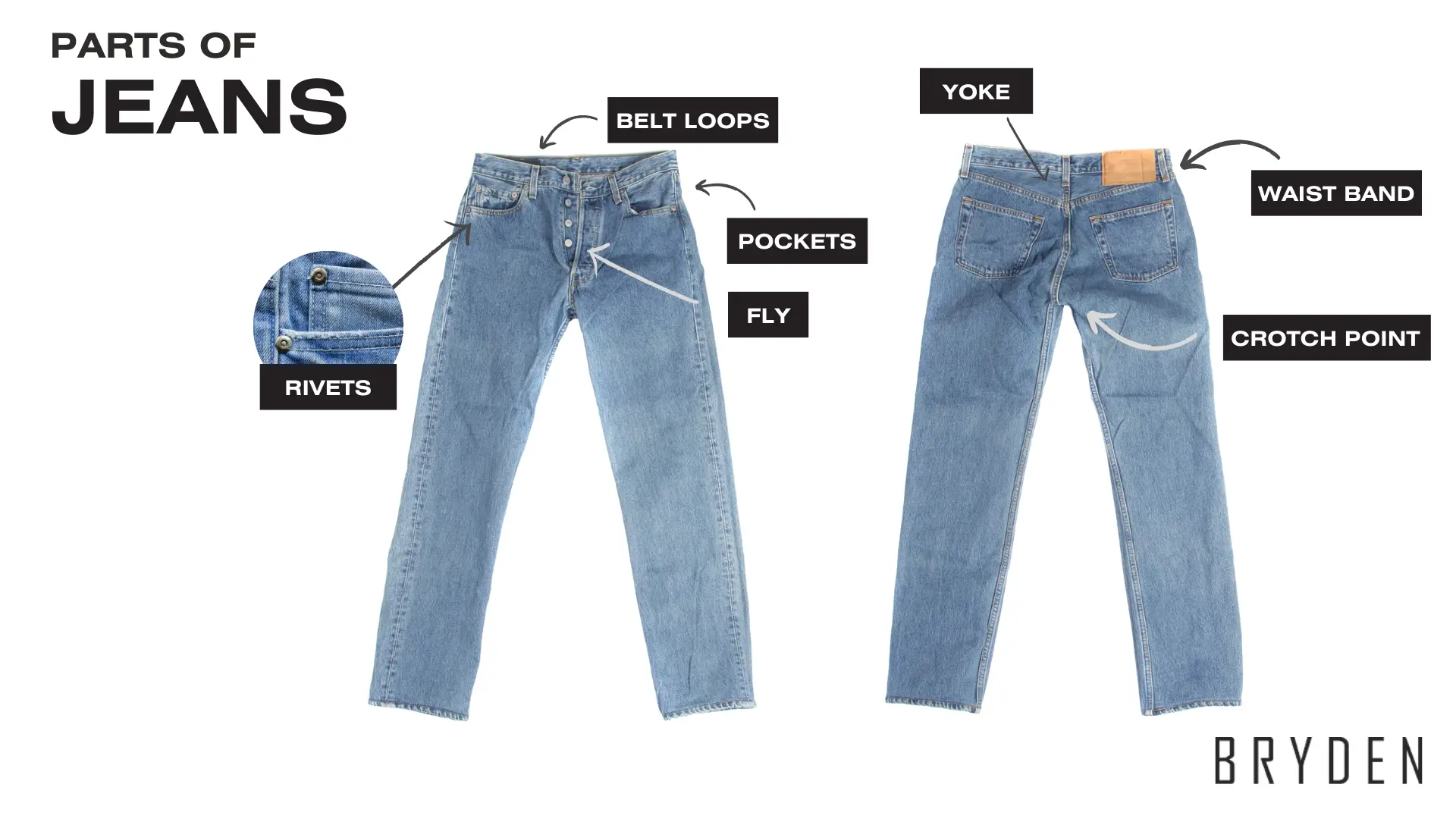
Ever wondered what makes a pair of jeans so distinct? Dive into the essential components that come together to craft those beloved denim staples.
What are the parts of jeans?
Understanding these parts can elevate your appreciation of the craftsmanship behind every pair.
1. Waist band
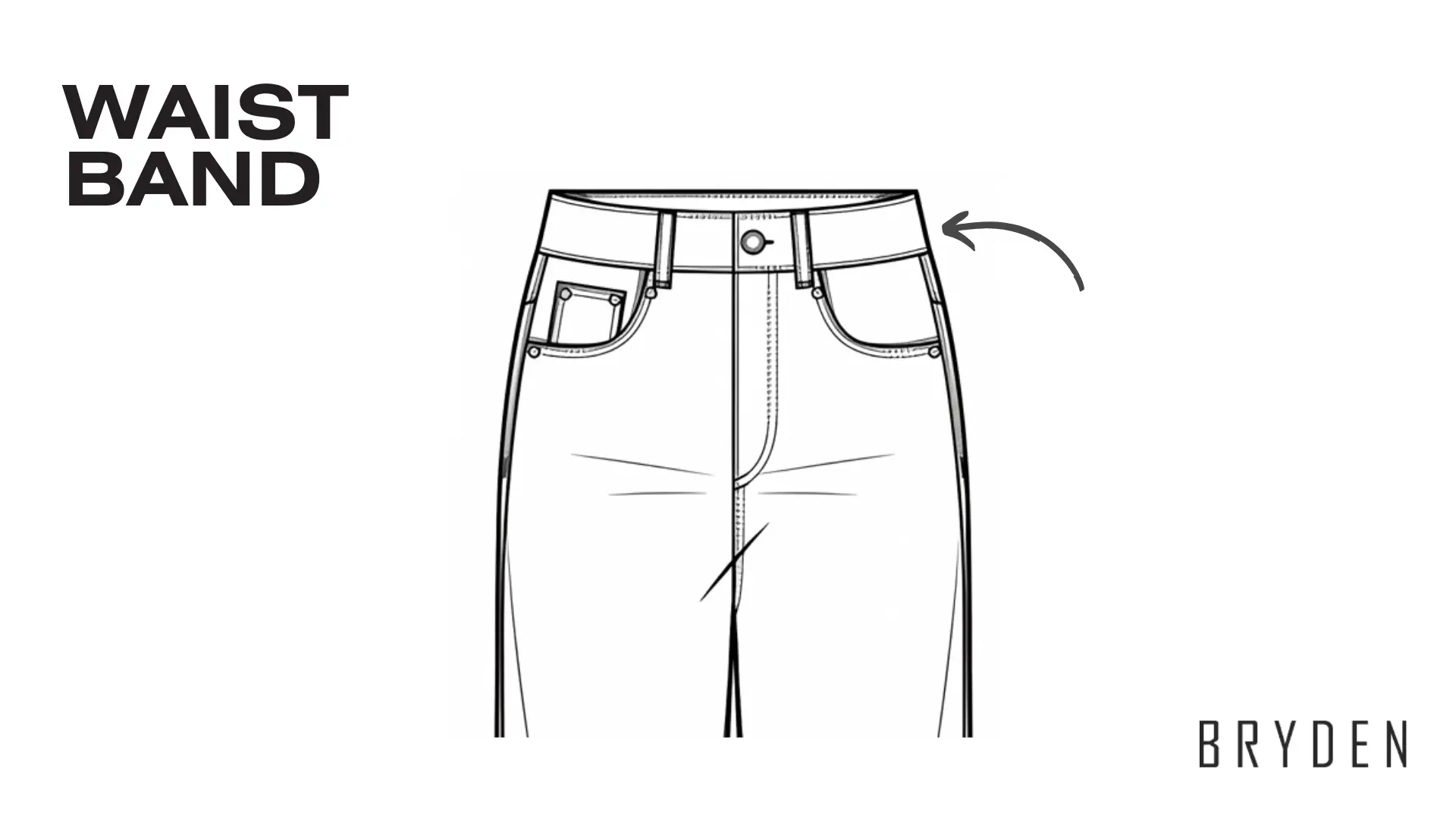
This essential band, crafted from durable denim, encircles the waist, providing structure and support. It’s where you’ll thread your belt to keep your jeans in place, with only one waistband featured per pair.
2. Belt loops
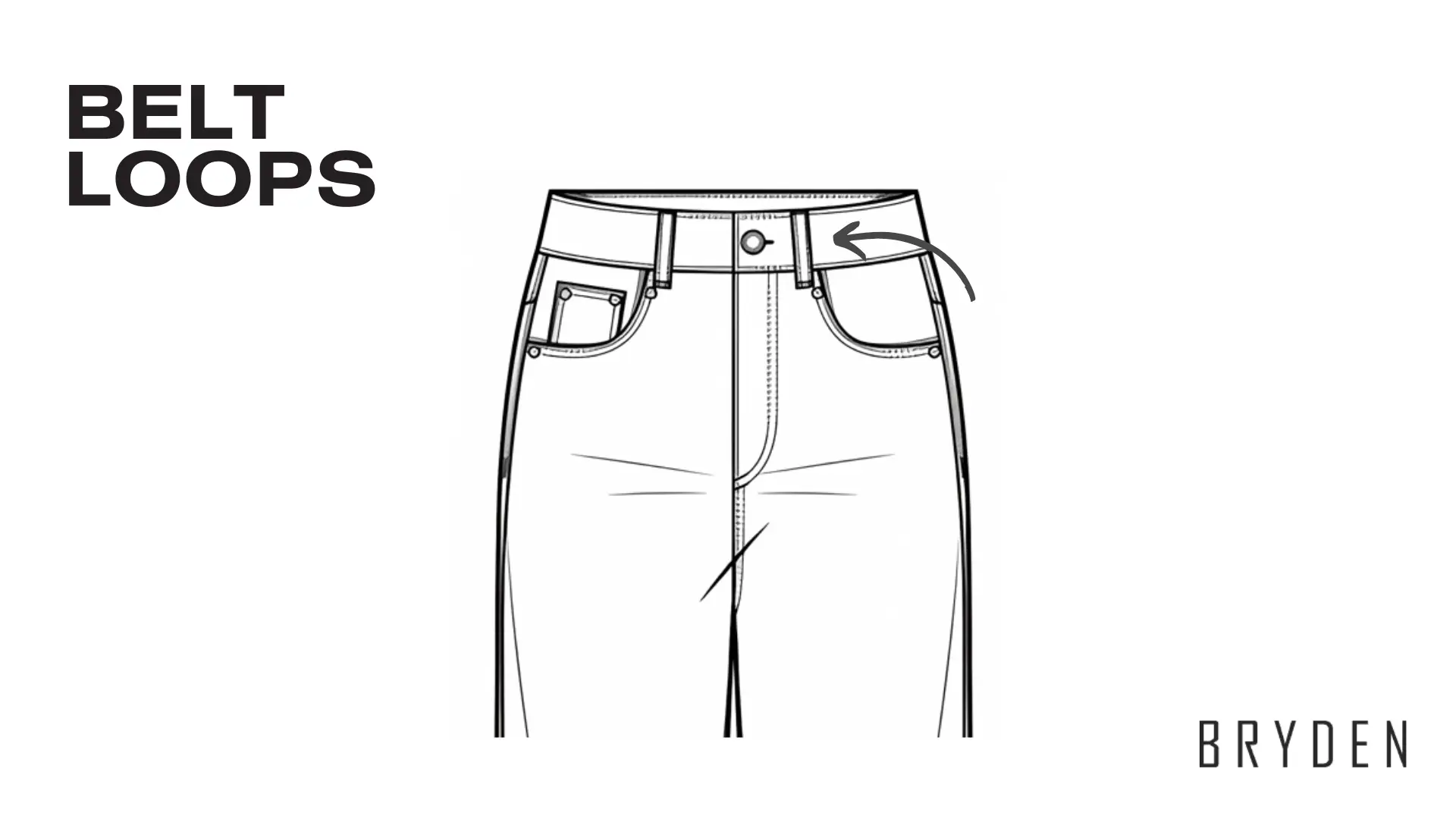
Strategically placed around the waistband, these loops keep your belt firmly in position. Typically, jeans sport five of these loops, though some designs feature up to seven, ensuring a secure fit.
3. Pockets
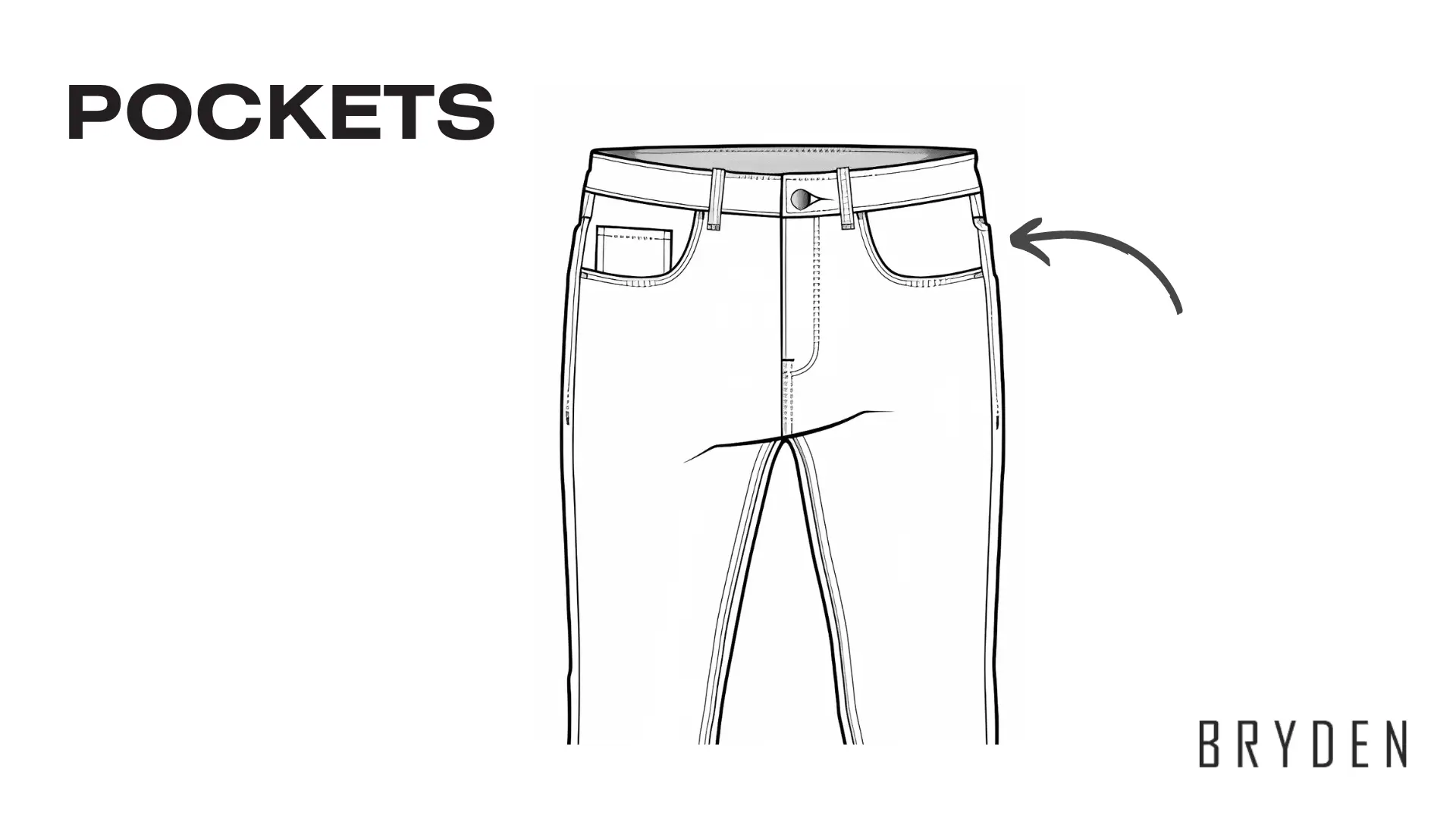
The front pockets, back pockets, and sometimes a small watch or coin pocket, are not just for convenience but add to the jeans’ charm. With four pockets in total, they serve as both functional elements and style statements.
4. Rivets
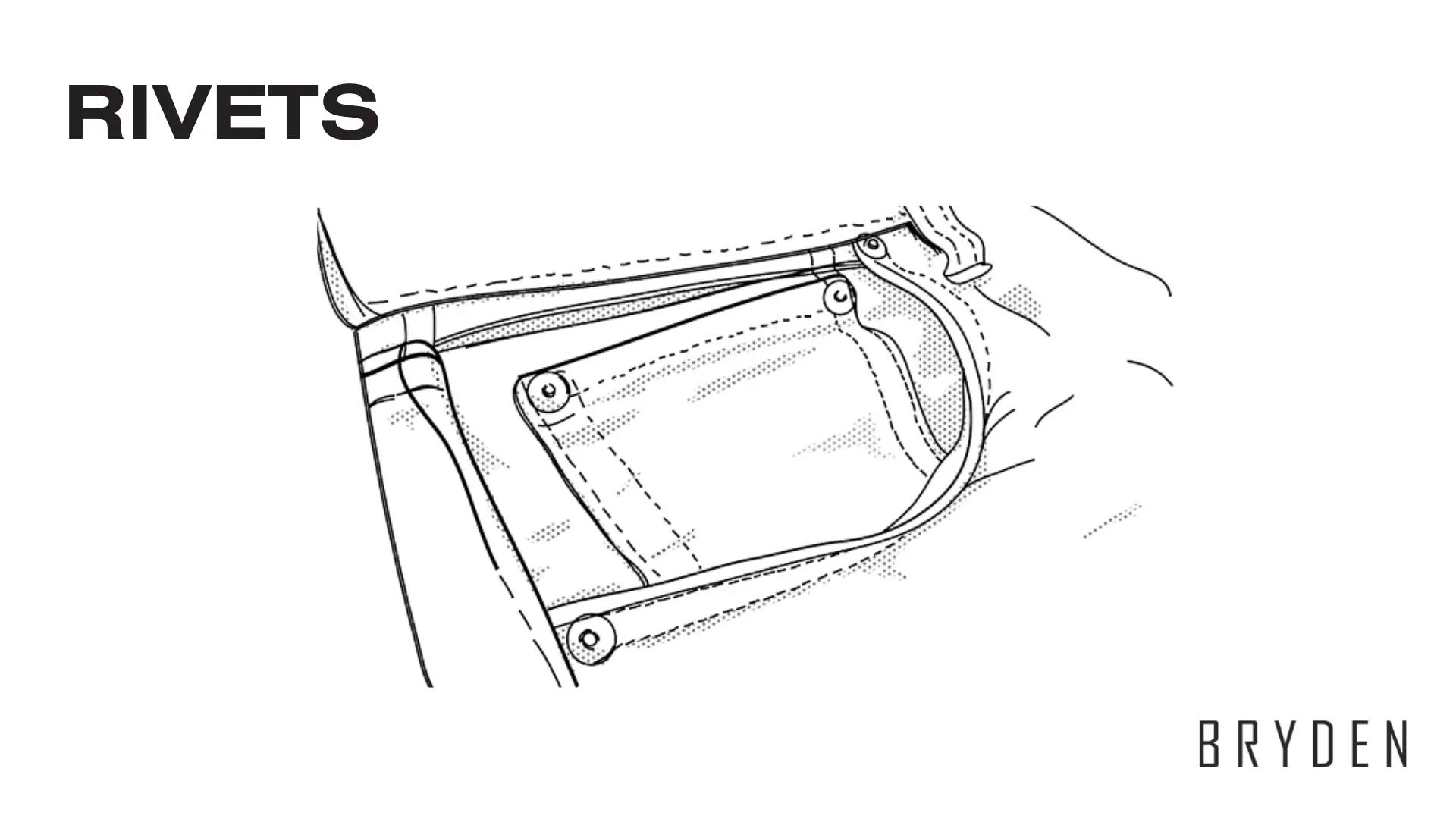
Metal rivets adorn the pocket corners, bolstering these stress points and adding a touch of flair. Hidden rivets, tucked beneath the denim, maintain the sleek look while reinforcing durability.
5. Crotch point
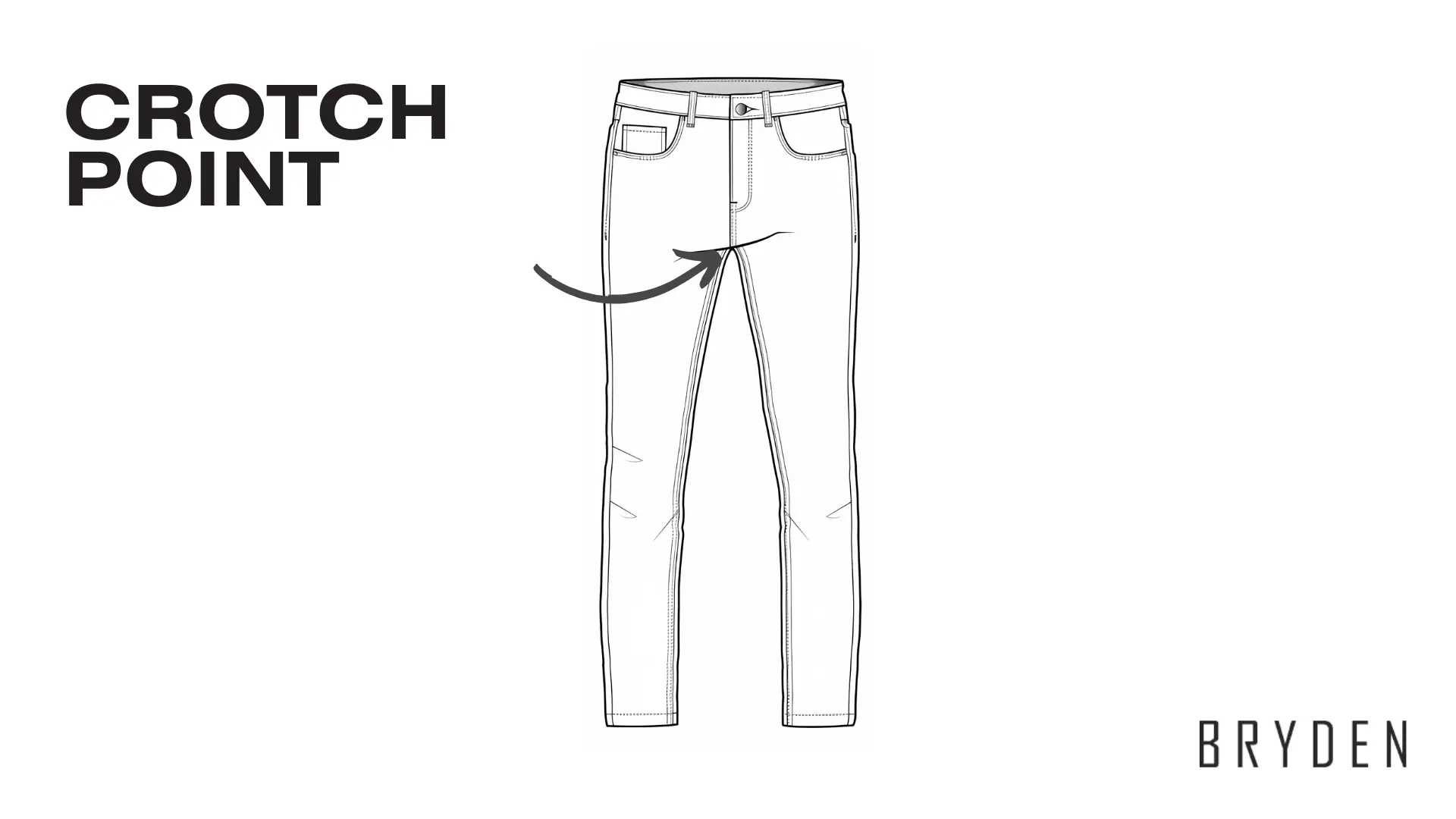
This crucial area connects the front and back sections of the jeans, ensuring a comfortable fit while allowing for mobility. It’s where the fabric comes together just below the fly.
6. Fly
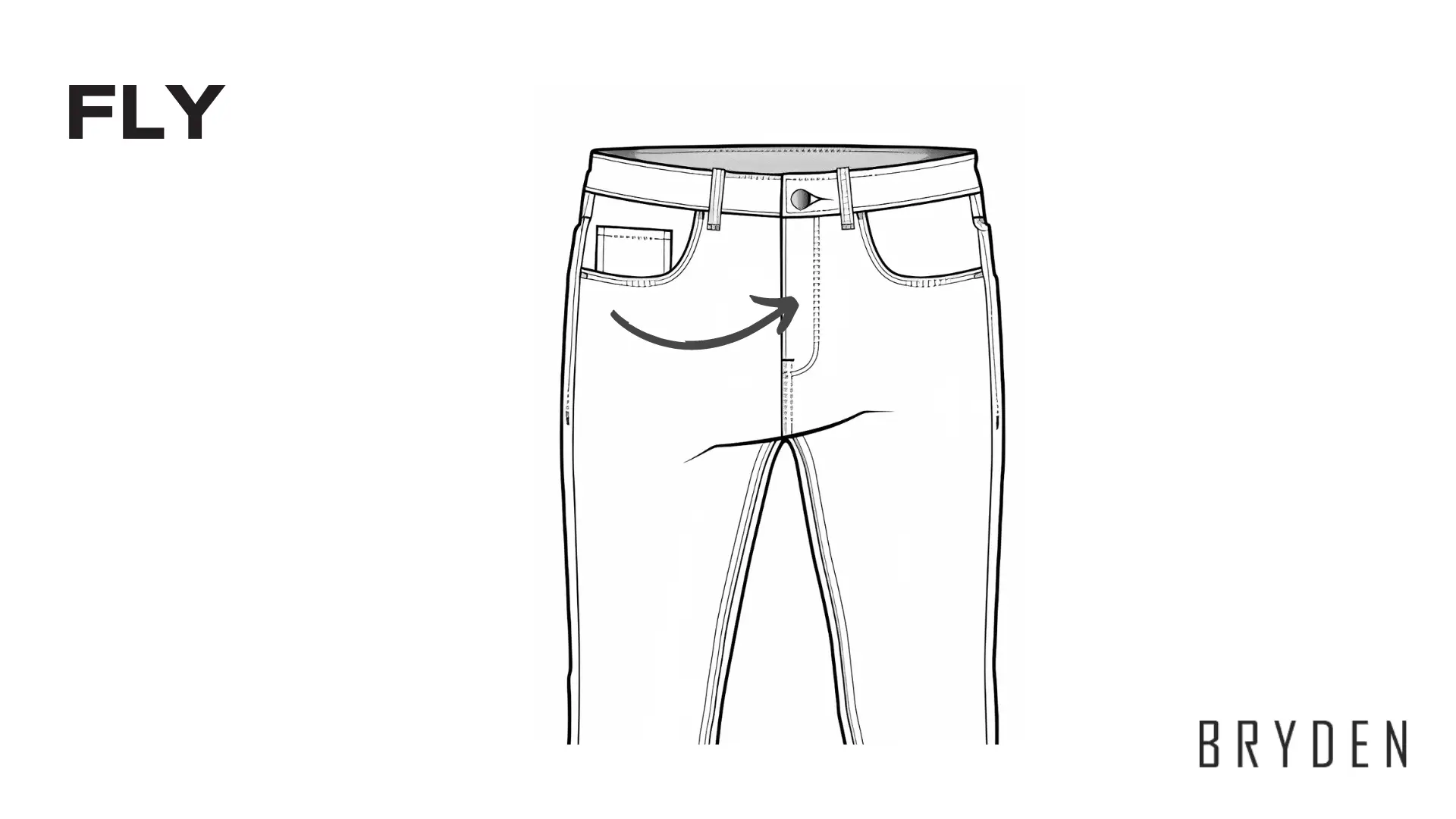
Concealing the zipper or buttons, the fly is the front opening of the jeans. It’s designed to give access while keeping the closure discreet and functional.
7. Button
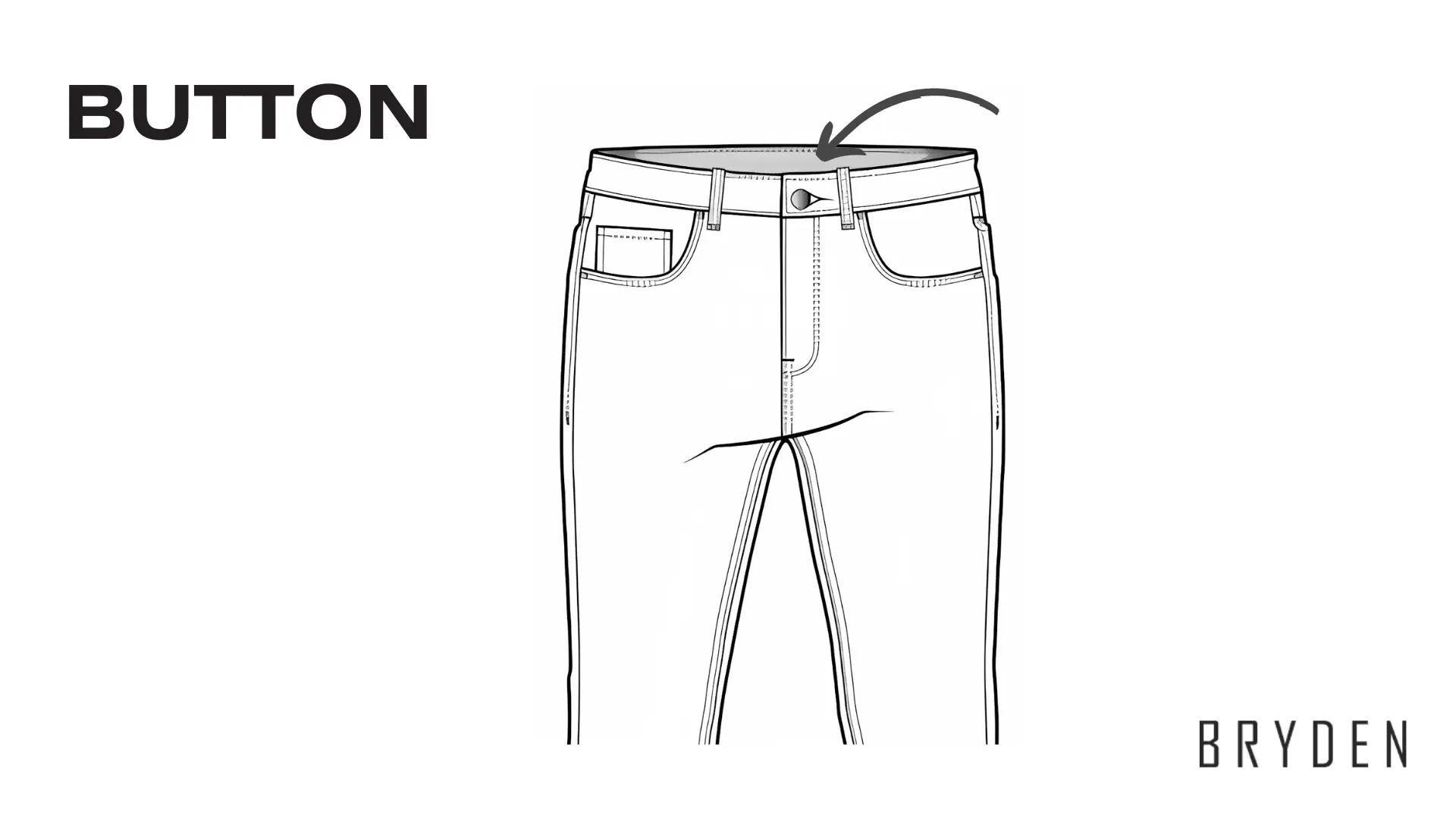
Sitting atop the fly, this button or series of buttons ensures the jeans stay fastened. Depending on the design, jeans might feature a single button or multiple buttons instead of a zipper.
8. Yoke
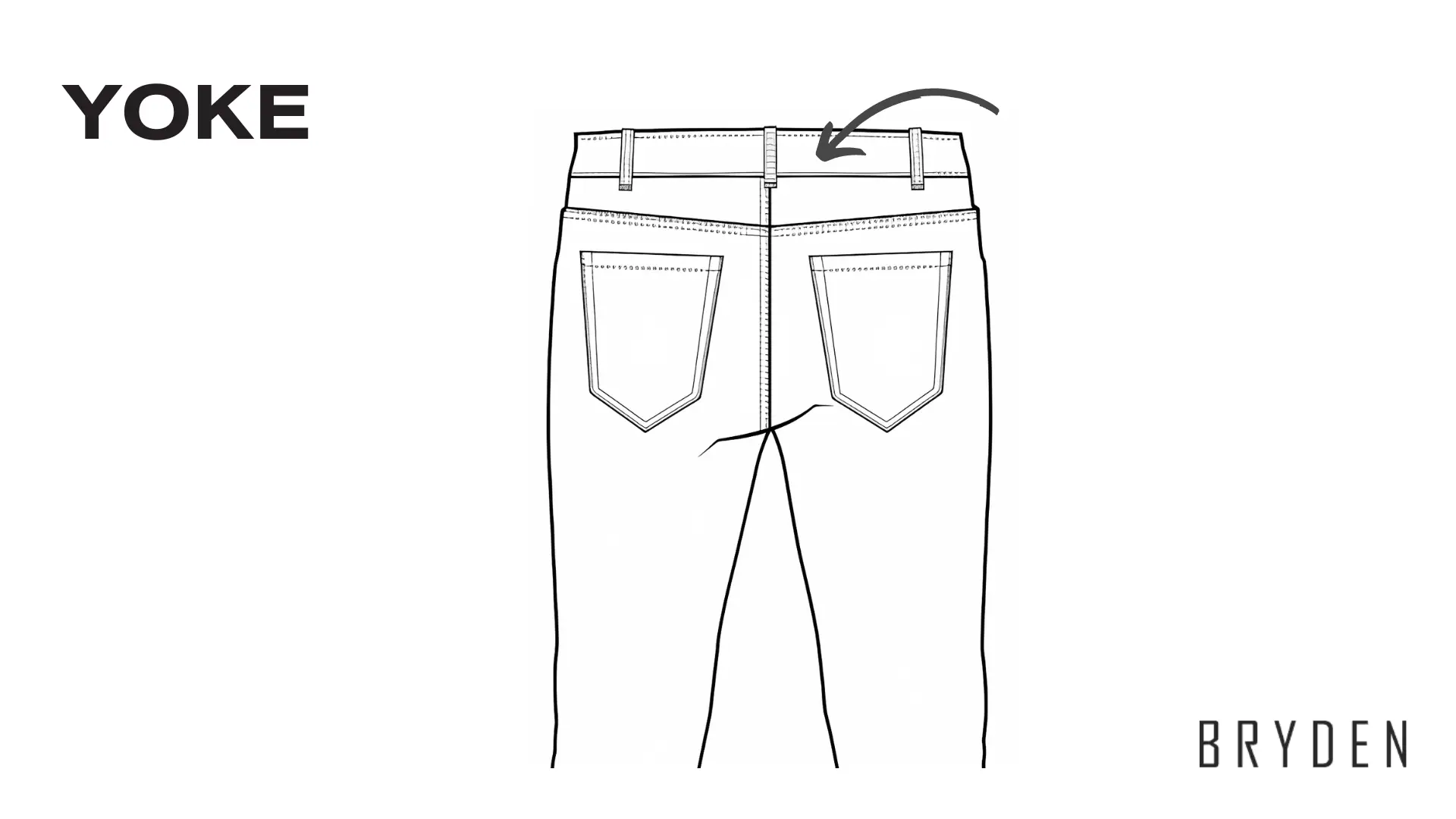
A V-shaped yoke at the back helps shape the jeans to the body, adding both fit and flair. It provides a tailored fit around the seat and adds a visual curve to the back.
9. Arcuates
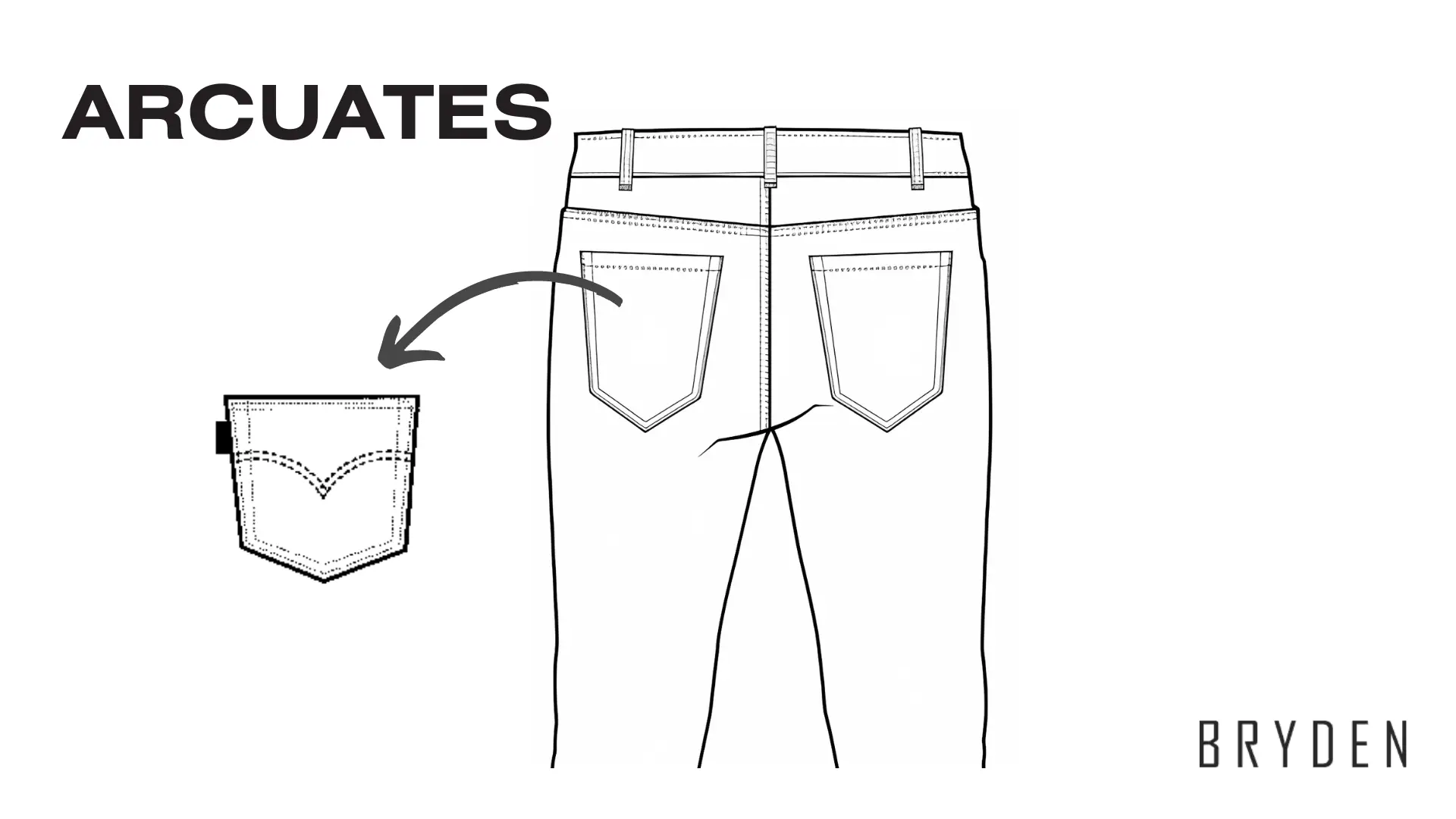
These signature stitching patterns on the back pockets are not just decorative. They serve as a hallmark of quality and attention to detail, adding unique character to each pair.
10. Brand patch
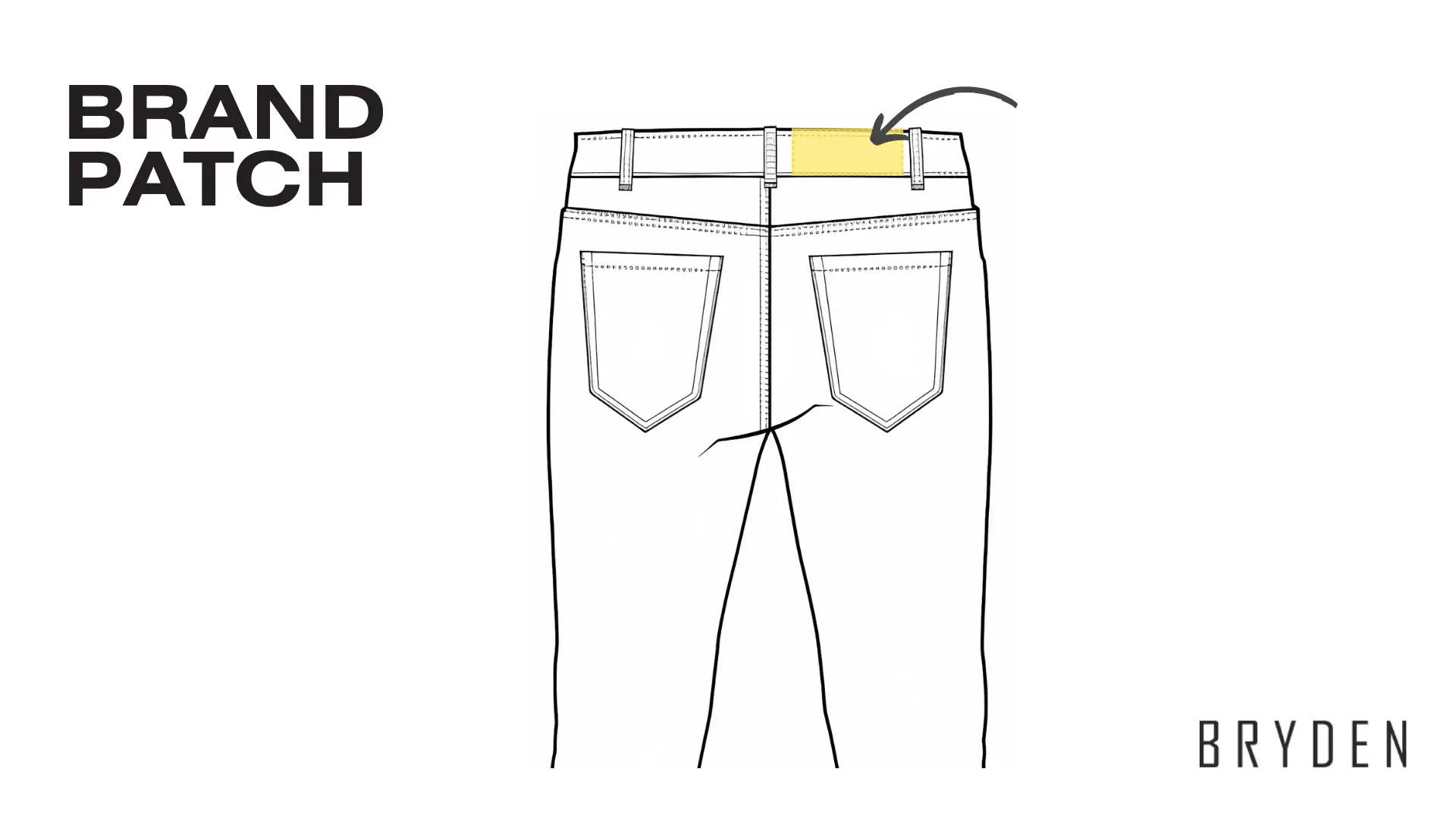
The brand patch, positioned above the right back pocket, signifies more than just a label—it’s a mark of identity and craftsmanship.
Every detail, from waistband to rivets, enhances jeans’ style and functionality, ensuring they stay a versatile staple in any wardrobe.
Choosing quality fabrics
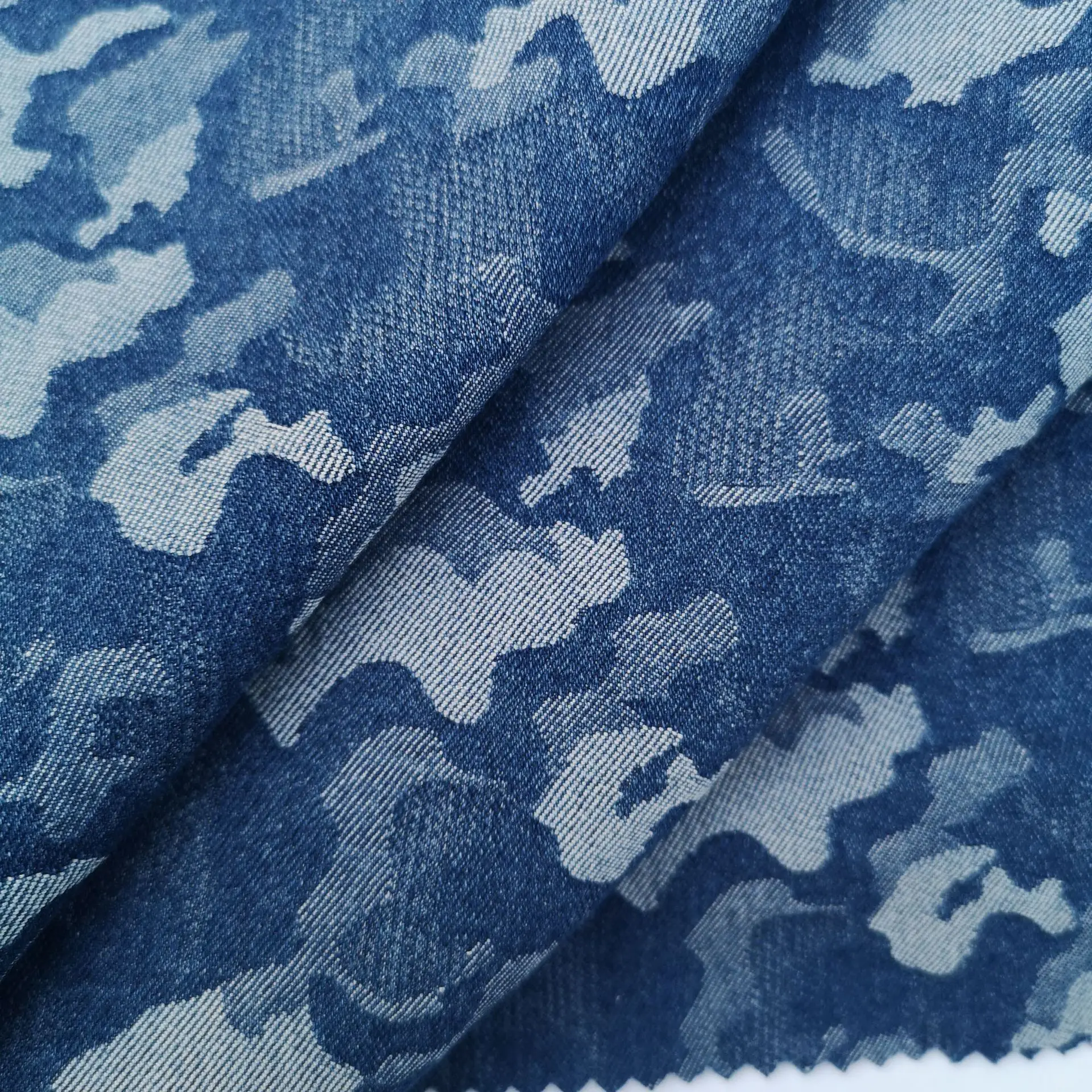
The right fabric defines jeans’ look and durability. Denim seems like a standard fabric—it’s made of cotton and woven in a tough design. However, different types of denim offer distinct characteristics, influencing how jeans look and fit.
Here’s a closer look at various fabrics and how each contributes to the unique character of jeans:
1. 100% cotton
This classic fabric stands as the original denim choice—soft, breathable, and versatile. It provides durability and comfort, though it can shrink slightly with washing. Ideal for traditional denim jeans, its simplicity offers a reliable, robust choice.
2. Bull denim
Need a tough fabric? Bull denim, with its 3×1 weave, stands up to heavy use. Heavier and stronger than standard denim, it’s built to last but might feel a bit stiffer.
3. Raw denim
Imagine deep blue jeans that evolve with every wear. Raw denim arrives stiff and will shrink about 20% after washing. It’s perfect if you want a personalized fit that grows with you.
4. Washed denim
For those who prefer softness and a consistent fit, washed denim is ideal. Treated to prevent shrinkage and color bleed, it offers a variety of finishes—from light to dark—making it ready to wear immediately.
5. Stretch denim
Crave flexibility? Stretch denim, blended with elastane or lycra, offers comfort and a snug fit. It’s great for skinny jeans but may not be as breathable due to its synthetic components.
6. Polycore denim
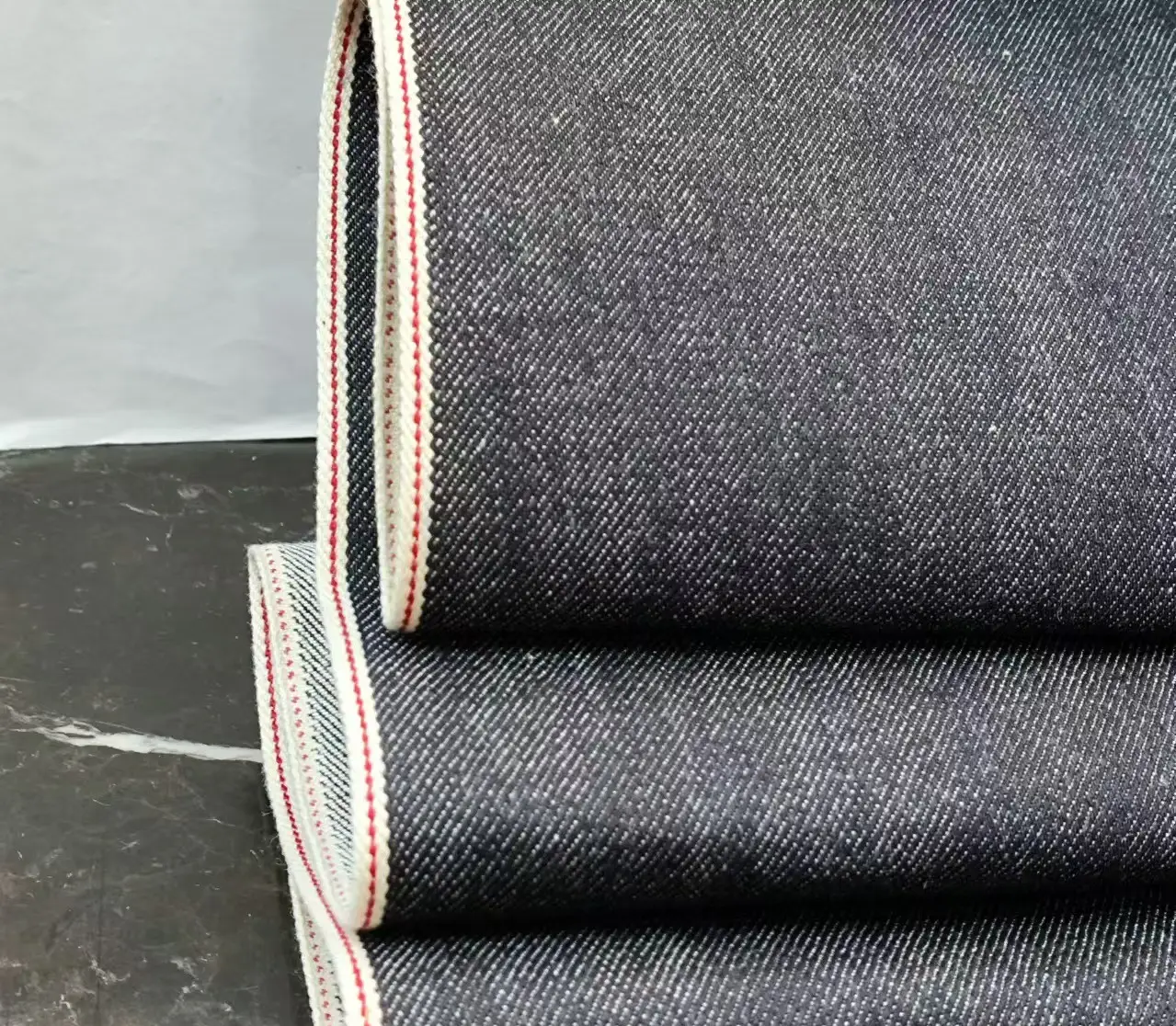
A mix of polyester and cotton, polycore denim combines strength and wrinkle resistance. The polyester enhances durability, while the cotton ensures comfort, making it a practical option for both style and functionality.
7. Selvage denim
Enter the realm of premium with selvage denim, known for its self-edge finish. Originating from Japan, it’s durable and stylish, offering a unique, clean look that prevents fraying.
Those are the main types of denim. Another type that deserves mention is color denim. While traditionally dyed indigo, denim can be colored in various shades, allowing for a broader range of style options. But we’ll discuss dyeing techniques in detail later on.
Beyond denim, other fabrics might better match your style. Each fabric adds unique traits, expanding your options for standout jeans.
1. Chambray
Lighter and more breathable than denim, chambray provides a casual, refined look. Its plain weave makes it perfect for warmer weather, resembling denim but with a lighter touch.
2. Rayon
Rayon mimics various fabrics with a smooth, versatile texture. It’s durable and wrinkle-resistant, though it needs careful care to keep its look.
3. Corduroy
Warm and cozy, corduroy’s thick, ribbed texture stands out. Ideal for cooler seasons, it offers a plush feel and a distinctive look compared to traditional denim.
Understanding fabric characteristics helps craft jeans that fulfill both function and style. Each fabric influences the final fit and look, so choose wisely.
Pattern making and cutting
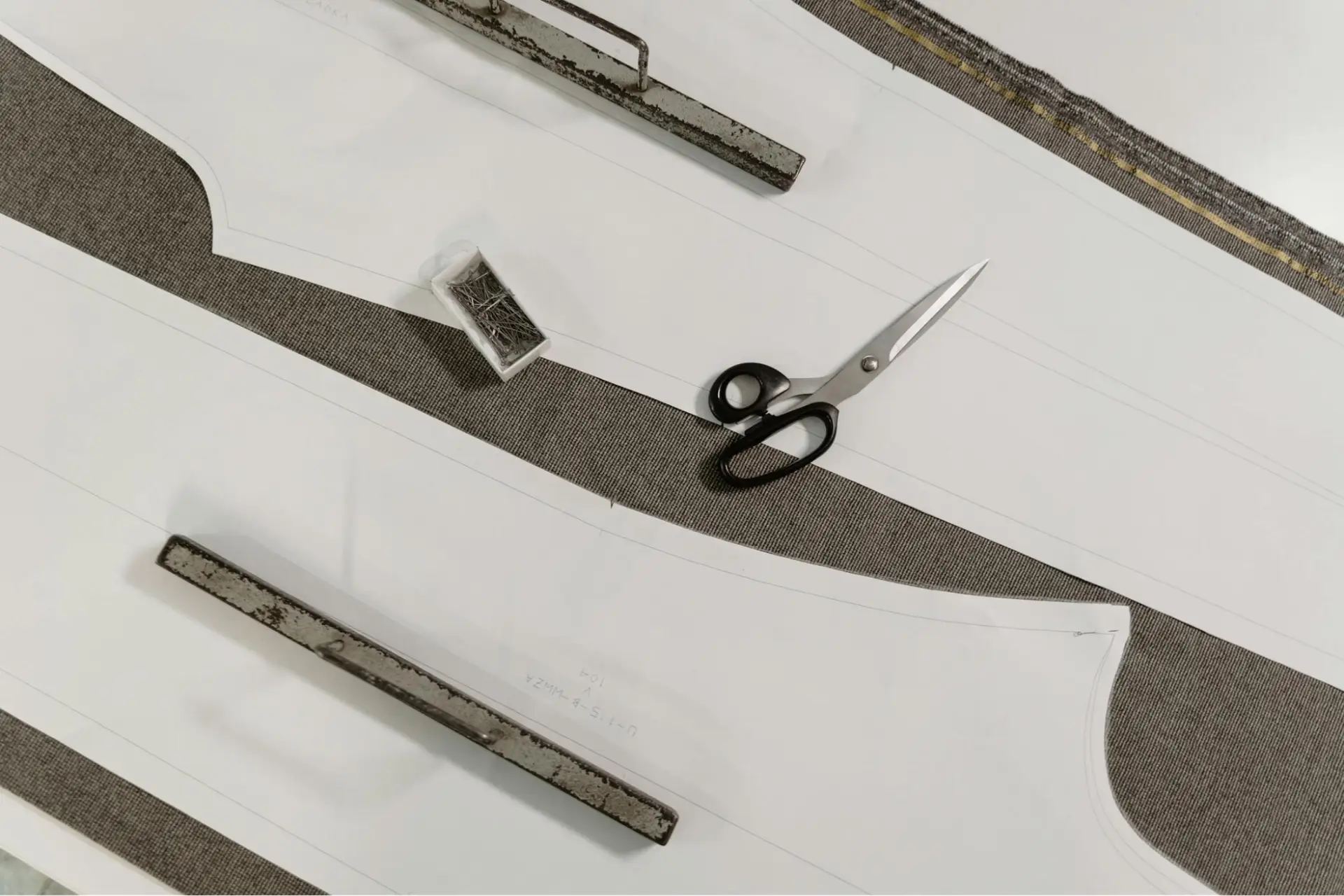
Pattern making is a crucial step that lays the foundation for the final product. It all begins with precise measurements—this data drives the creation of patterns that guide the fabric cutting process. Accurate measurements are vital, as they influence the fit and overall design of the jeans.
Patterns are typically drawn on pattern paper or cardboard. Manufacturers might use specialized software or traditional hand-drawing methods to create these templates. The choice between using a ready-made pattern or crafting a custom one depends on the desired fit and style.
-
Custom patterns
For a tailored fit, custom patterns offer flexibility. Drafting your own design—from panels to pockets—ensures a perfect fit and unique look.
-
Ready-made patterns
Ready-made patterns ensure ease and consistency. Available in various sizes and styles, they come with instructions that simplify cutting and ensure accurate results.
Once the patterns are ready, cutting the fabric comes next. Cutting fabric requires precision. Attention to detail ensures patterns are cut correctly, affecting the final product’s fit and quality.
This phase is crucial, shaping the jeans’ fit and design. Precision in pattern making and cutting ensures a high-quality, well-aligned product.
Pattern making (How to with samples)
Pattern making transforms measurements into perfectly fitting jeans. This precise process ensures both style and fit, laying the groundwork for stylish, well-fitting jeans.
To master pattern making, understanding various sample patterns can be incredibly helpful. Here are some examples that showcase different styles and complexities in pattern making:
1. Men’s five-pocket jeans
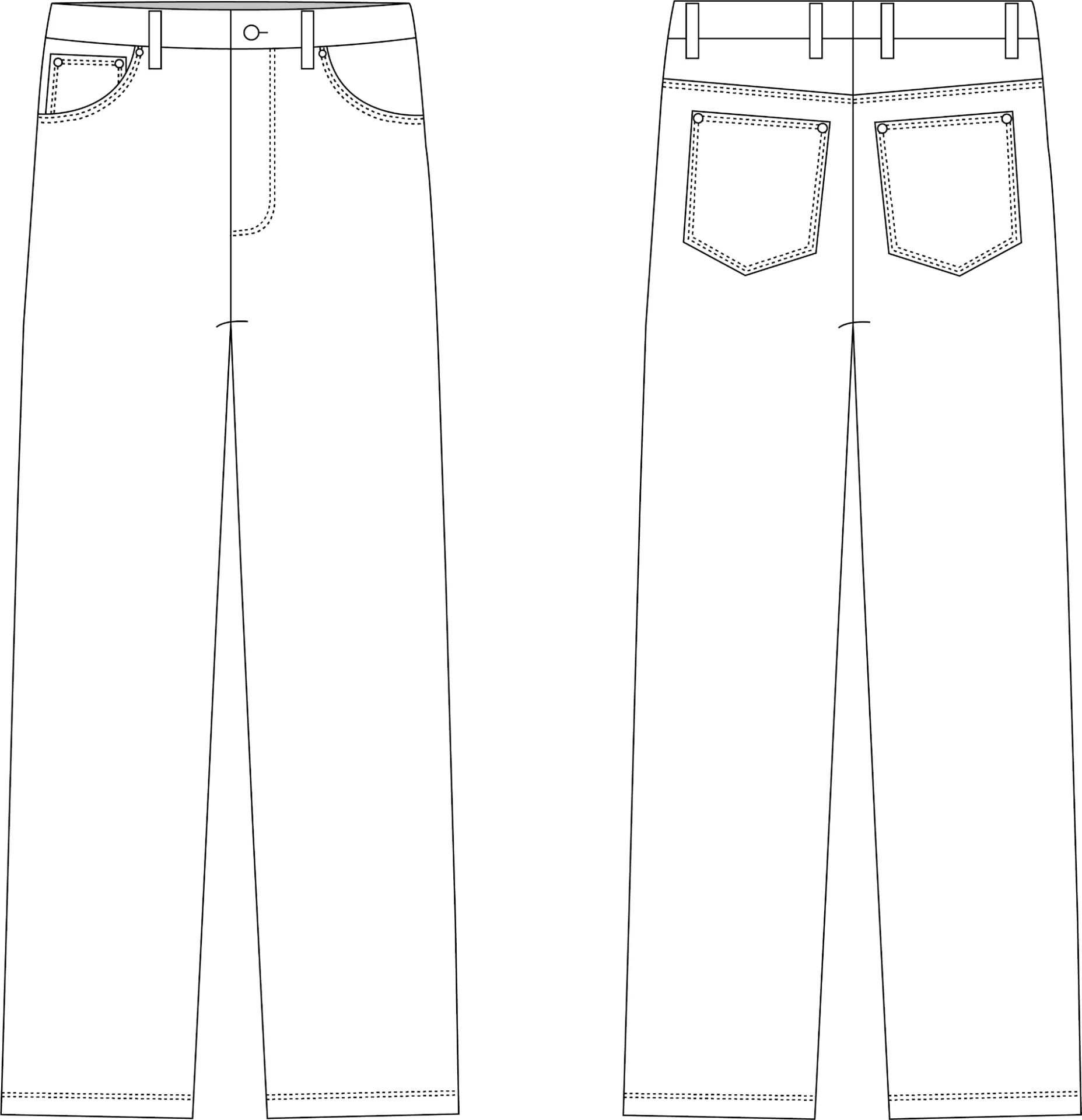
This classic design features a straight waistband, curved front pockets, a coin pocket, and back pockets with a yoke. The pattern incorporates a front fly with a zipper, straight leg, and belt loops. This sample highlights the essentials of traditional jean patterns, including a button fly and heavy topstitching.
Every component, from belt loops to rivets, must be carefully cut and aligned. This simple pattern serves as a foundation for understanding how classic denim components fit together.
2. Women’s jeans with pintuck panels
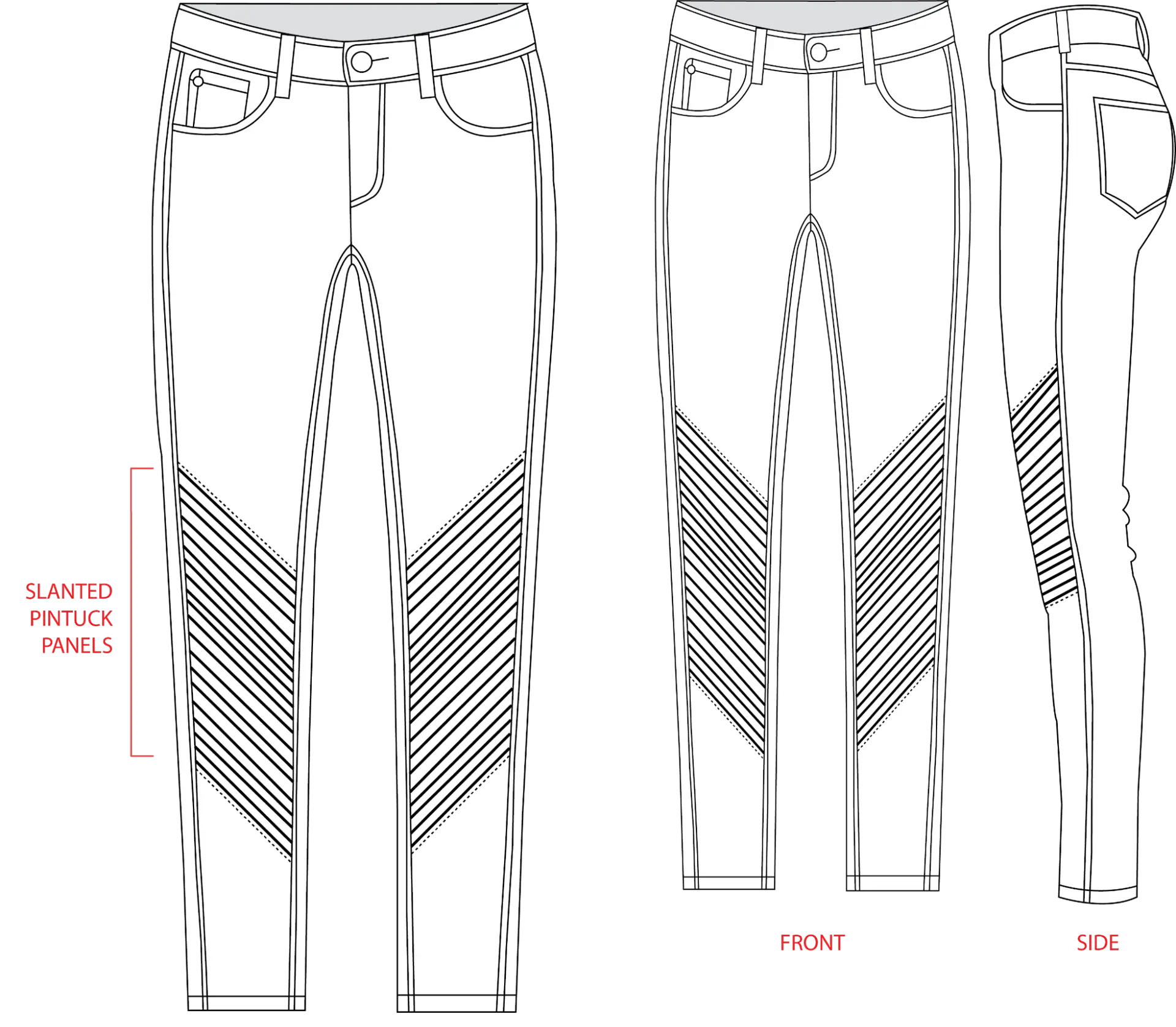
This pattern offers a more intricate design with tight-fitting jeans featuring pintuck panels at the thighs, available in mid-rise or high-rise views. The design includes front and back pockets, belt loops, and a coin pocket. The pintuck details add a unique touch but also present a challenge in pattern making.
Detailed elements like pintuck panels demand meticulous pattern making. The more complex the design, the greater the attention needed to achieve the desired fit and style.
Examining samples reveals how different features are tackled in pattern making. These examples showcase the blend of precision and creativity needed to bring a design vision to life.
Marking tips for cutting patterns on fabric
Accuracy is paramount to ensure that every piece fits perfectly and aligns seamlessly during assembly. Here’s how we ensure effective marking:
-
Align grain lines
Grain lines are meticulously aligned with the fabric’s weave to maintain structural integrity. This step is essential for preventing distortion and ensuring that the final product retains its shape and durability.
-
Use clear marks
Fabric markers or chalk are used to outline pattern pieces clearly. Special attention is given to curves and pockets, where precision ensures a polished finish. Seam allowances are marked to maintain consistent widths, and tailor’s tacks might be used for complex areas, providing temporary guidance without permanent alterations.
-
Consider fabric stretch
The direction of fabric stretch is taken into account, especially with stretch denim. This consideration is crucial for ensuring that the jeans fit comfortably and maintain their shape after wear.
-
Minimize pinning
Fabric weights are employed instead of pins to secure the pattern in place. This method avoids any distortion of the fabric, preserving the pattern’s accuracy.
-
Double-check markings
All markings are reviewed before cutting to ensure that notches, darts, and other critical points are correctly placed. This helps in avoiding any errors during the assembly process.
These meticulous practices guarantee a high-quality finished product that meets the highest standards of craftsmanship.
Cutting and sewing in jeans manufacturing
After the pattern-making stage, cutting and sewing come into play. This phase is crucial in transforming the fabric into a finished pair of jeans.
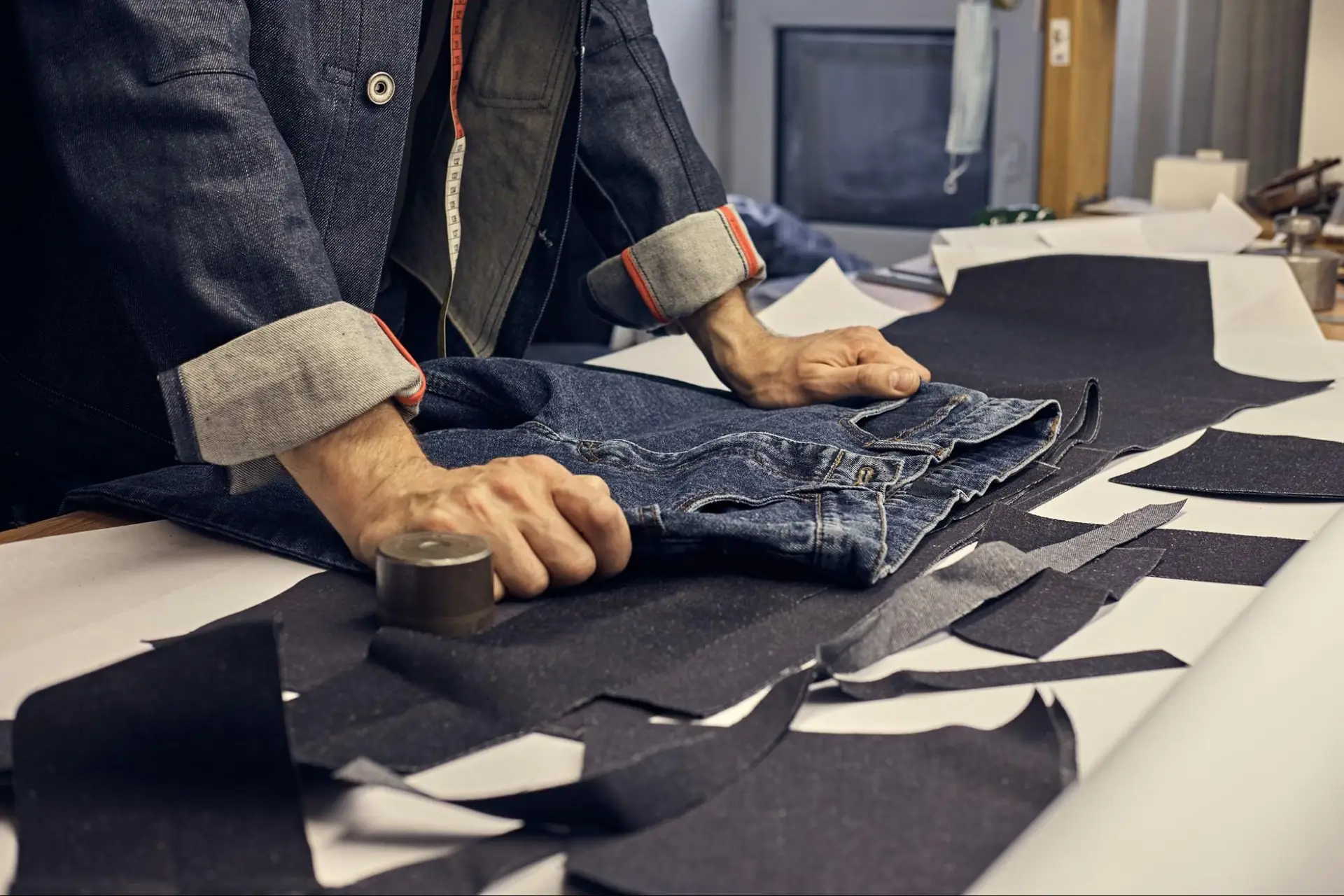
-
Fabric inspection and pattern placement
Before cutting, the fabric is inspected for defects and laid out flat to avoid inconsistencies. Patterns are carefully arranged to optimize fabric use and maintain accurate grain lines.
The cutting process is executed with precision to minimize waste and ensure each piece aligns with the design.
-
Pattern marking and preparation
Each pattern piece is outlined on the fabric with markers or chalk, defining curves, pockets, and other details. Accurate markings are vital for ensuring proper alignment during assembly.
-
Sewing and assembly
Once cut, the fabric pieces are stitched together by skilled machinists. The process begins with smaller components, such as pockets, and progresses to the larger sections of the jeans.
Specialized machines handle various stitches and seams, ensuring durability and a professional finish. Pockets, belt loops, and zippers are carefully sewn on, with extra attention to securing these features for enhanced longevity.
-
Seam integrity and stitch consistency
Strong, high-tensile threads are used to create durable seams that endure wear. Stress-prone areas, like pockets and the crotch, receive double-stitching for extra strength.
Various seam types, such as flat-felled seams, are chosen for their suitability. Consistent stitching and seam allowances ensure a professional finish.
-
Final touches and quality assurance
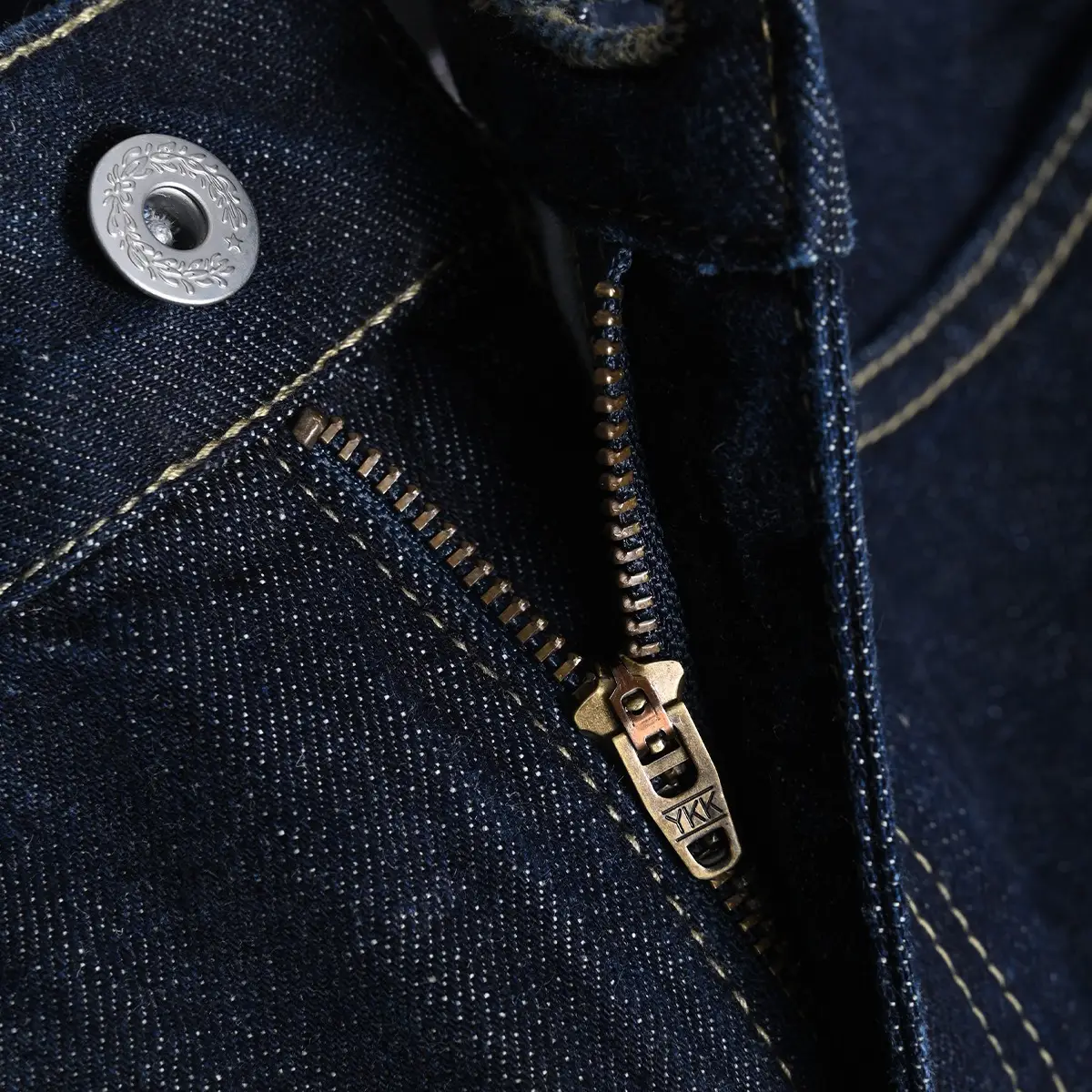
Adding buttons, rivets, zippers and labels finalizes jeans, enhancing both their look and functionality. These elements boost the jeans’ appearance while contributing to their practical use.
Inspecting each piece throughout sewing catches defects or inconsistencies, ensuring top-notch quality is maintained.
How to cut the jeans
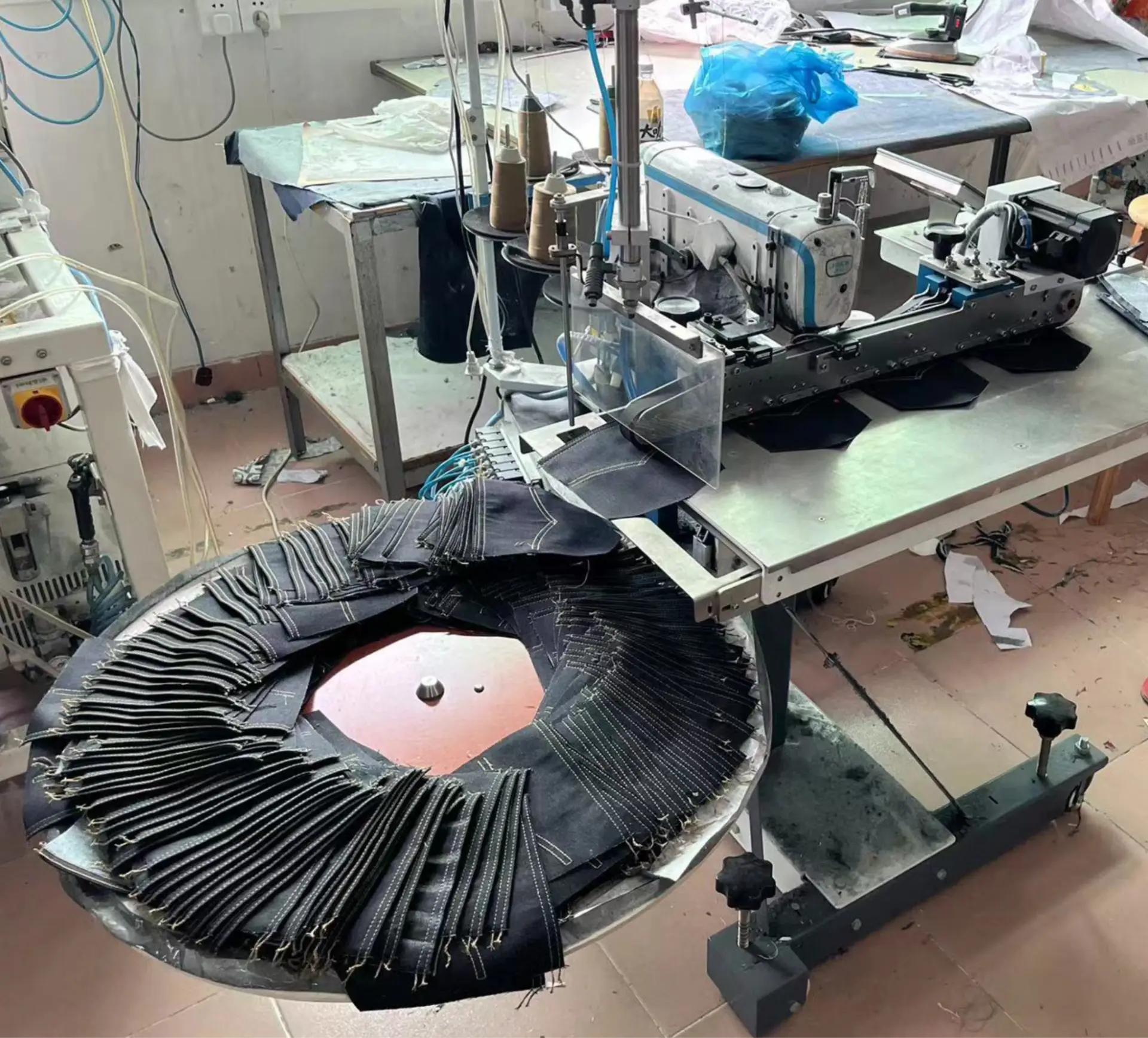
Cutting is key to transforming raw fabric into precise pieces for jeans assembly. This stage ensures that each pair maintains its design and fit. Here’s an inside look at the cutting phase:
-
Creating the marker layout
A marker layout is crafted to optimize fabric use, arranging pattern pieces to minimize waste and align with design specifications and fabric grain.
-
Achieving precision in cutting
Once the denim is laid out and aligned with the grain lines, cutting begins. Sharp tools such as rotary cutters or industrial saws are used for clean, precise cuts. In large-scale production, multiple fabric layers are cut simultaneously with electric or laser cutters, reducing fraying and ensuring uniform dimensions.
-
Streamlining for sewing
After cutting, pieces are sorted and labeled by size and style, paving the way for an efficient and precise sewing process.
Cutting isn’t just a step—it’s the foundation of jeans manufacturing. Proper cutting ensures each piece fits perfectly, contributing to the overall quality of the finished product.
Different types of seams for jeans
Seams play a crucial role in jean construction, each adding its own flair and strength. Here’s a quick dive into the essential seams that build sturdy, stylish jeans:
1. Flat-felled seam
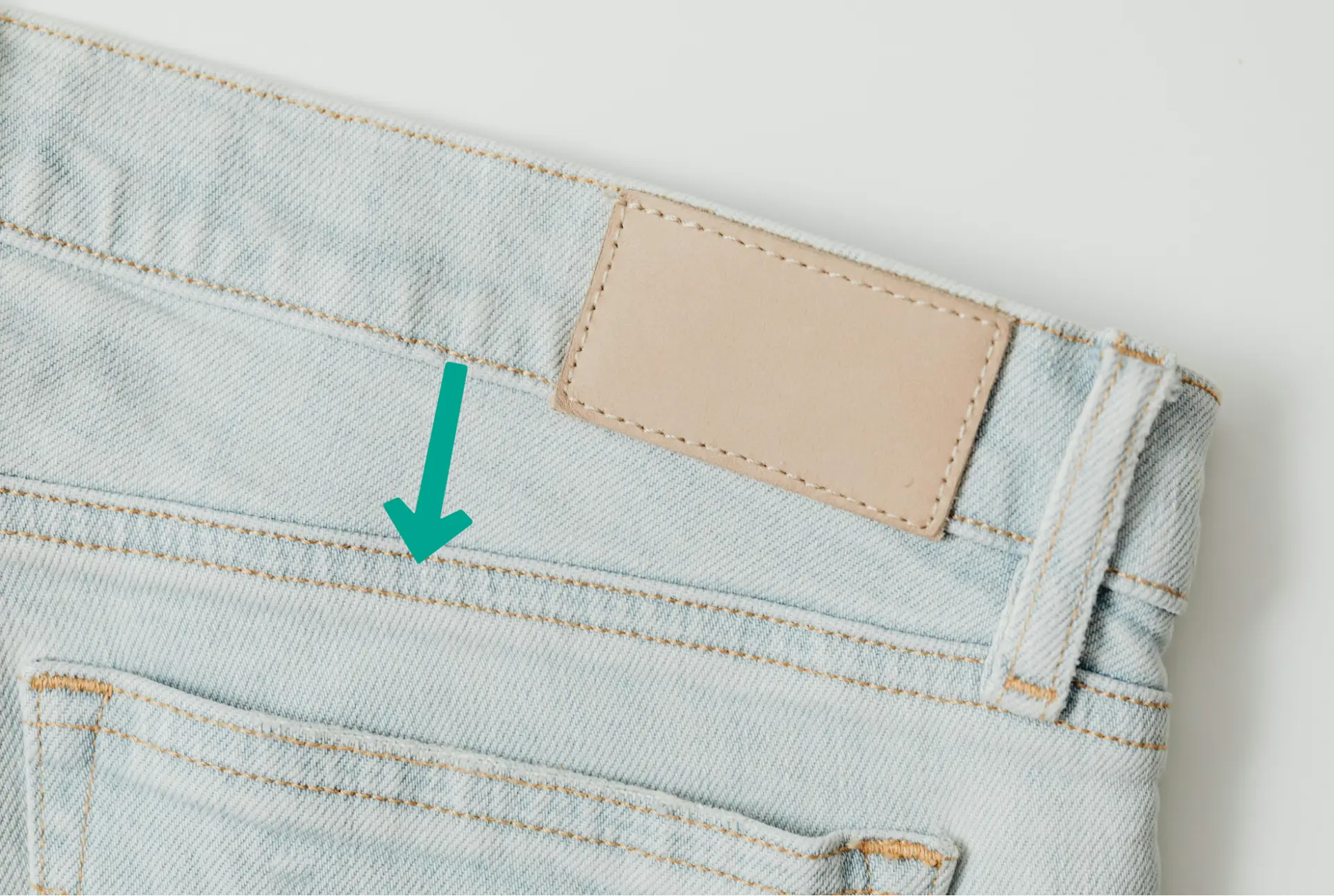
A go-to choice for durability, the flat-felled seam is commonly used on inseams and outseams. By folding and stitching the fabric edges, it ensures a clean, robust finish, perfect for handling high stress with no raw edges in sight.
2. Double-stitched seam
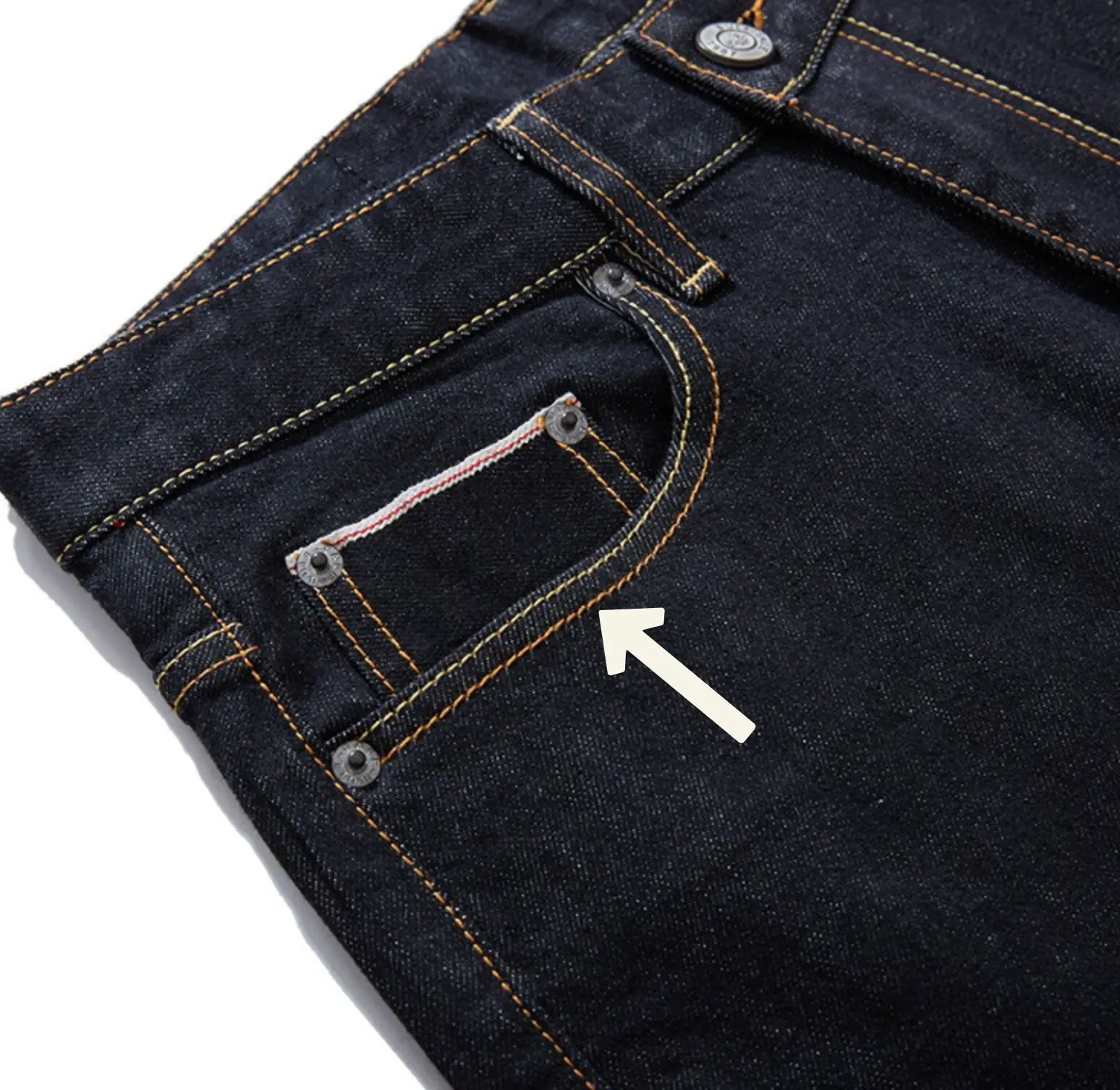
Strength meets precision with the double-stitched seam. This seam adds an extra row of stitching for added durability, especially on side seams and the back yoke. It fortifies the seam line, preventing fraying while maintaining a polished look.
3. Overlock or serger seam
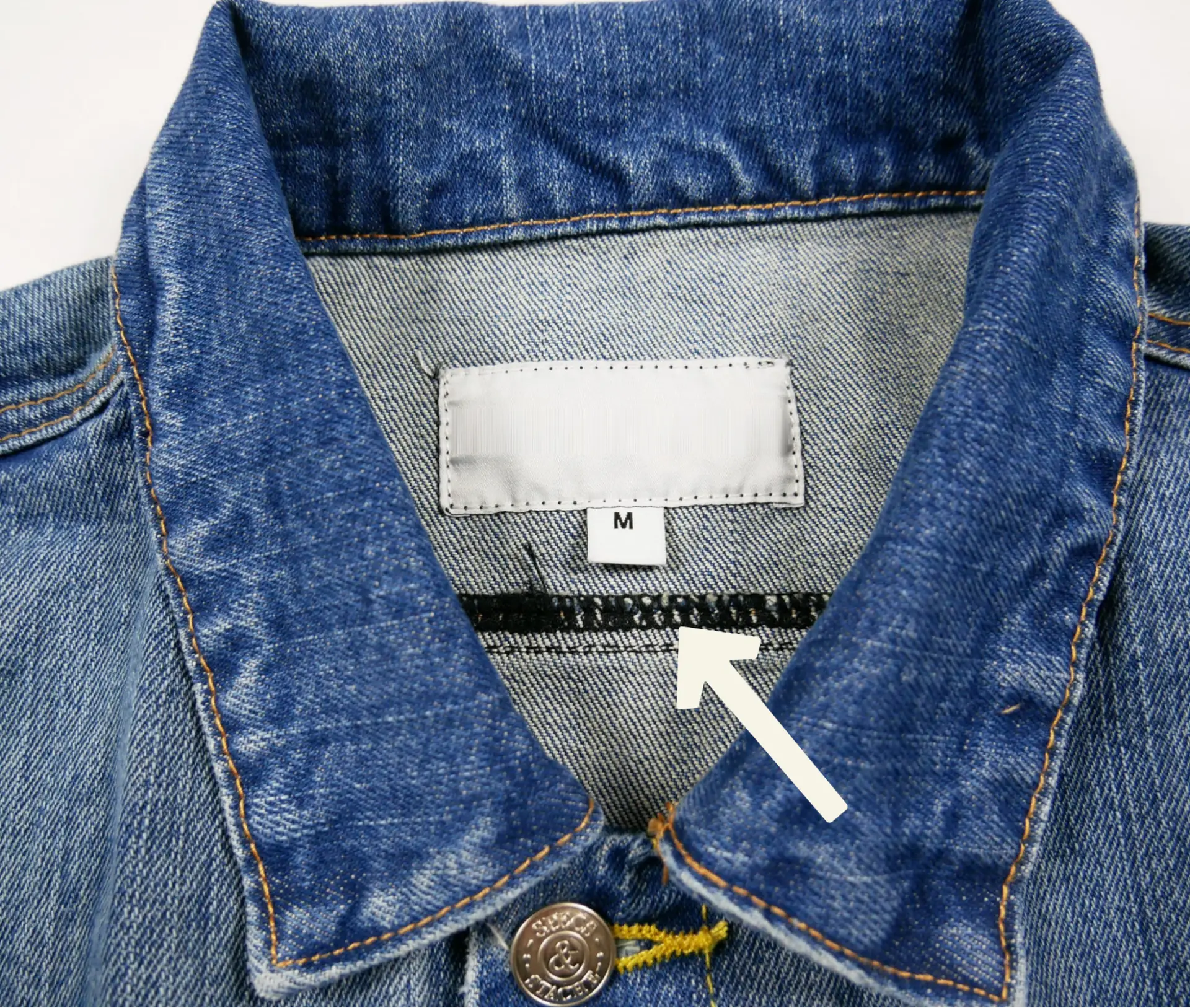
An overlock machine trims the fabric edges while encasing them in thread, offering a clean finish. This seam is a staple for preventing fraying and is often used on inner seams for a neat, durable edge.
4. Chain Stitch
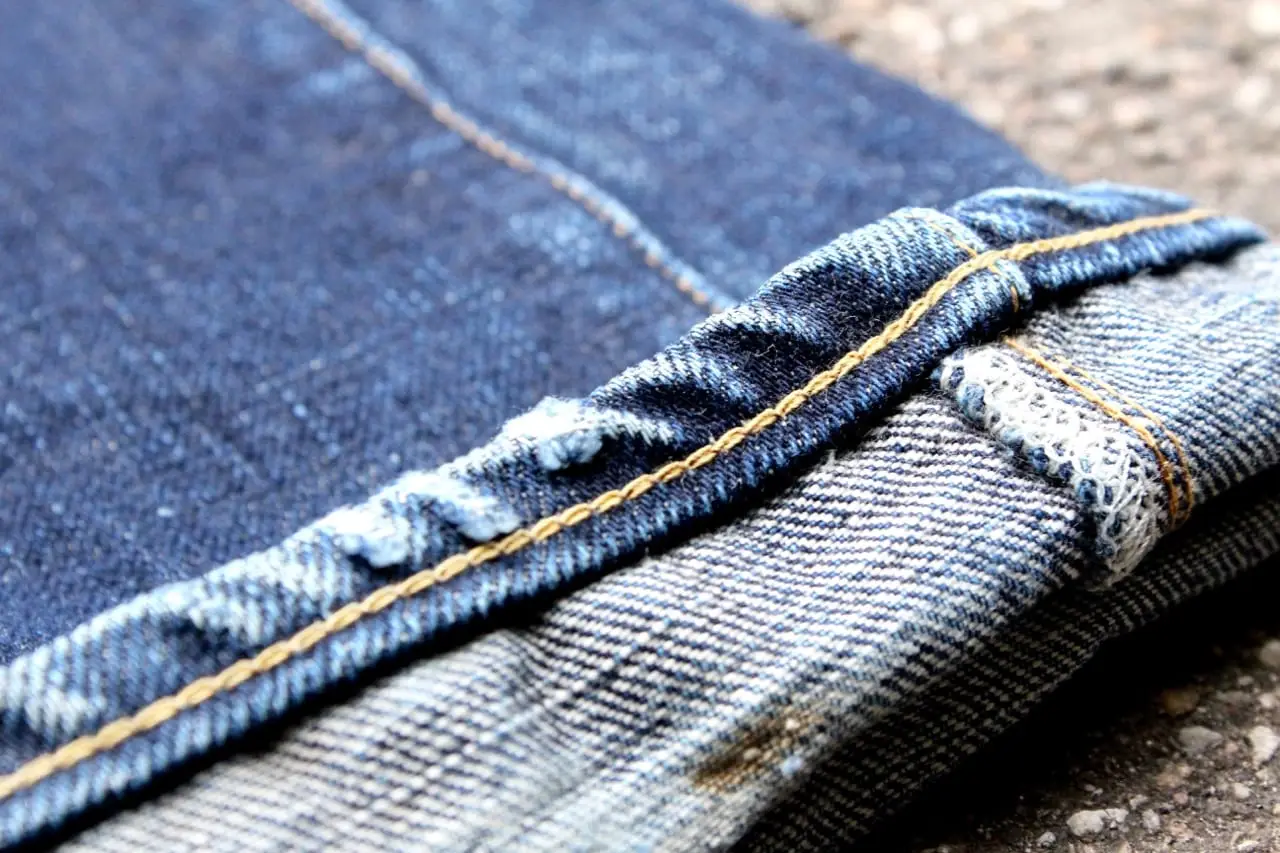
Chain stitches loop one continuous thread back on itself, creating a stretchy, durable seam. Often found in waistbands and hems, these stitches add that signature “roping” effect, making every pair stand out.
5. Single Needle Stitch
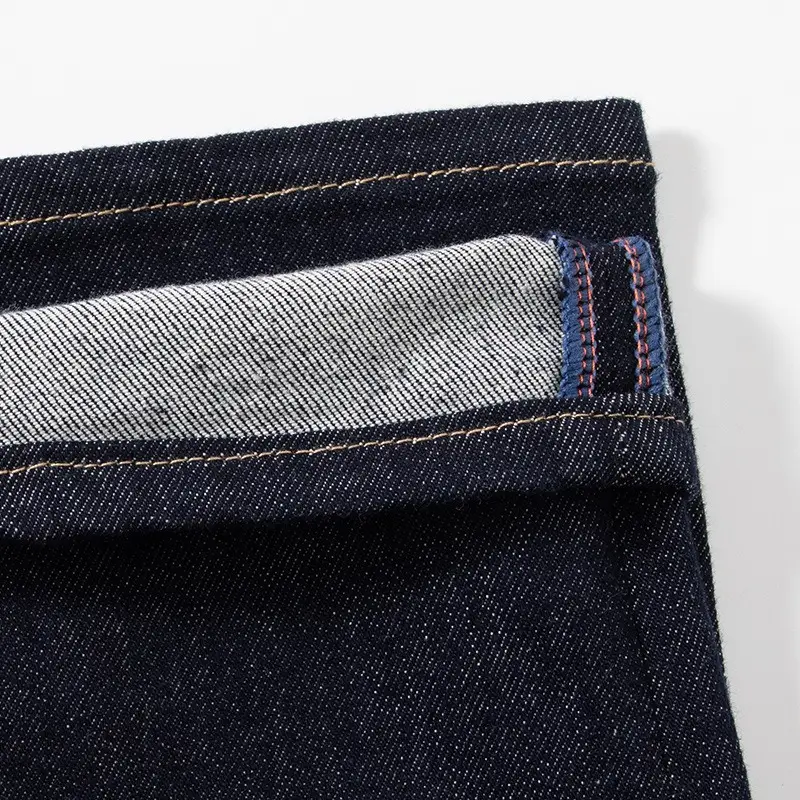
The single needle stitch is the simplest yet effective choice, stitching two fabric pieces together. Often reinforced with topstitching, it provides a straightforward method for joining pieces while ensuring durability.
This stitching type not only fortifies the jeans but also adds a touch of style and functionality, ensuring a perfect blend of durability and design.
Measurement points for jeans
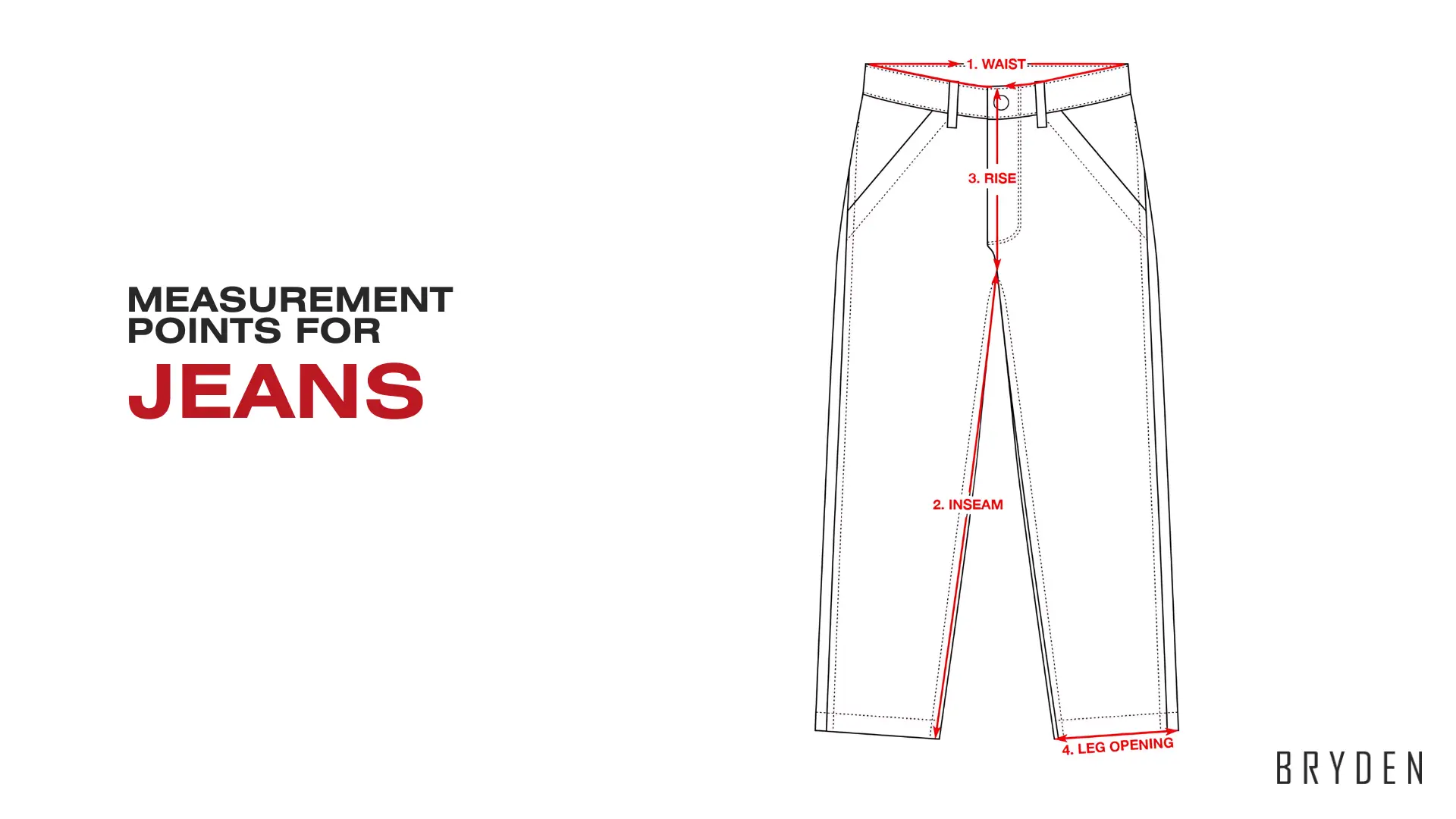
Achieving the perfect fit is crucial in jeans manufacturing. A great design won’t matter if the jeans don’t fit properly. Here’s a quick rundown on key measurement points, essential for ensuring a precise fit:
1. Waist
Waist measurements are taken around the natural waistline, guaranteeing a snug fit. This measurement starts from the top edge of the waistband, ensuring jeans stay secure and resist stretching over time.
2. Hips
Hips are measured at their fullest part, influencing how jeans fit over the hip area for a comfortable fit. On the jeans, this measurement helps ensure a smooth and comfortable fit, accommodating the body’s curves.
3. Front rise
Running from the crotch seam to the top of the waistband, the front rise measurement impacts where the jeans sit on the waist. This measurement is essential for achieving the right rise, allowing for comfortable wear without gaps or tightness.
4. Thigh
Thigh measurements are taken at the thickest part to ensure comfort and mobility. This measurement allows for ease of movement and prevents discomfort.
5. Knee and ankle
Knee measurements, taken around the knee area, affect how jeans drape. Ankle measurements are taken at the bottom hem, ensuring a comfortable fit and allowing for various styles.
6. Length
Length is measured from the waistband to the hem, ensuring jeans aren’t too short or long. Accurate measurements improve the overall fit.
7. Inseam
The inseam, running from the crotch seam to the bottom hem, is crucial for determining the length along the inside of the leg. This measurement helps achieve the perfect fit from the crotch to the hem.
8. Leg opening
Leg openings are measured across to ensure a comfortable fit around the ankles. This measurement helps determine whether the jeans are slim, straight, or wide-legged.
These measurements ensure a well-fitted pair of jeans, balancing comfort, style, and functionality.
The art of printing
Printing is a key factor in creating standout jeans, with various techniques bringing unique effects to denim. From vibrant patterns to textured designs, each technique offers its own magic.
Common printing techniques used for jeans
1. Discharge printing
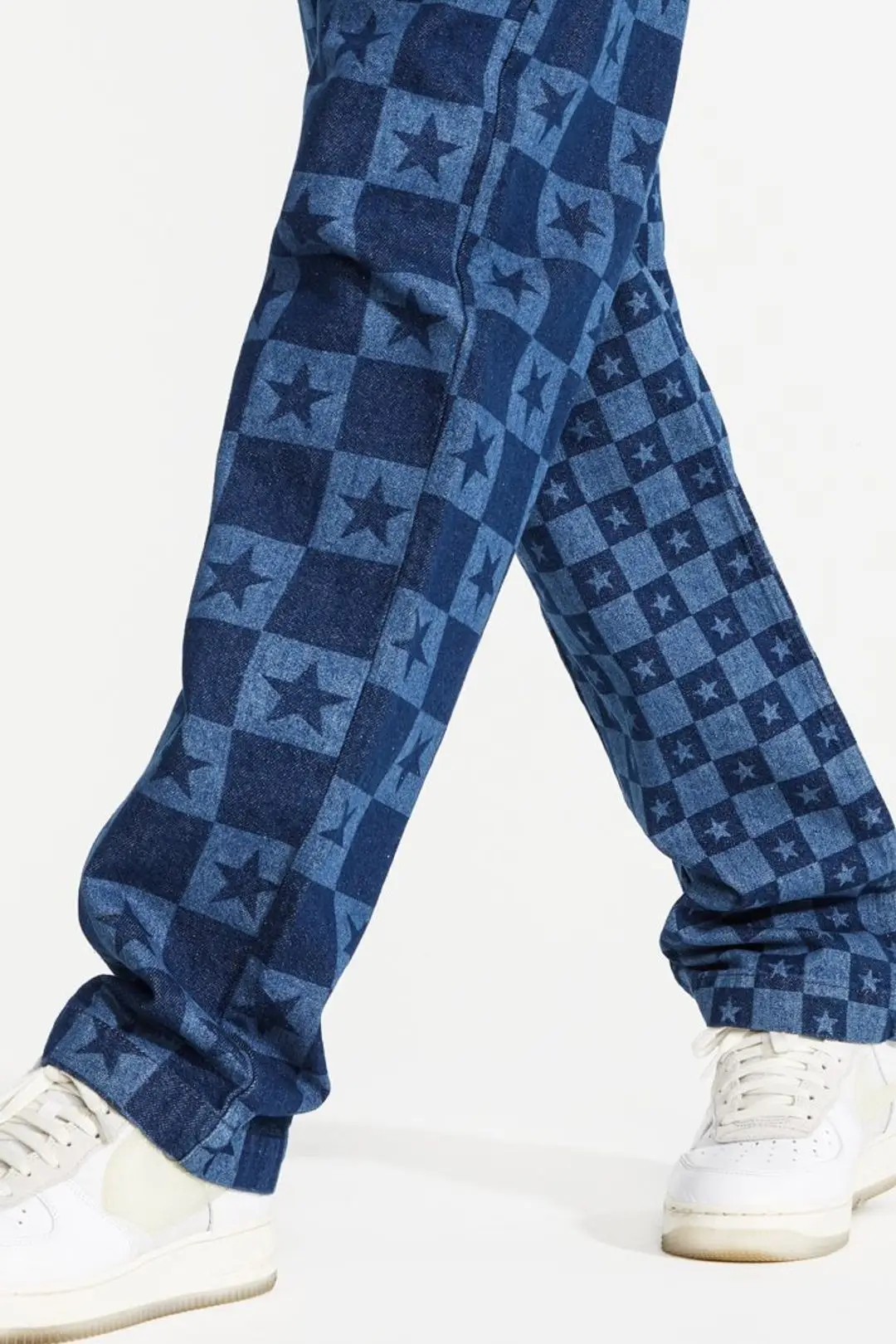
Source: Shopperboard
Imagine creating vivid prints on dark denim by removing the fabric’s original dye. Discharge printing does just that!
It uses special inks to lift the existing color, allowing for striking, soft-touch designs. It’s the go-to method for achieving bright, lasting prints with a luxurious feel.
2. Flock printing
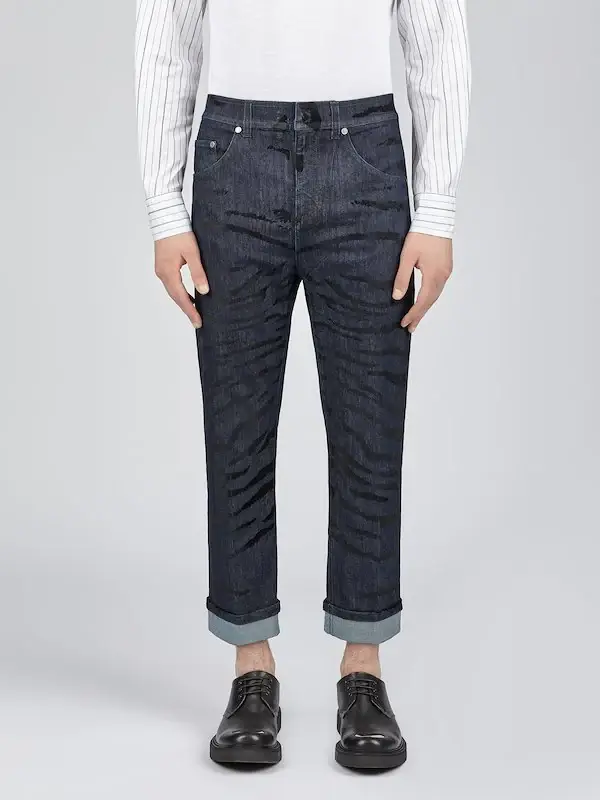
Source: Neil Barrett
Flock printing adds a plush, tactile dimension to jeans. Microfibers on an adhesive base create a velvety texture, giving your design a sophisticated touch with a mix of style and substance.
3. Laser printing
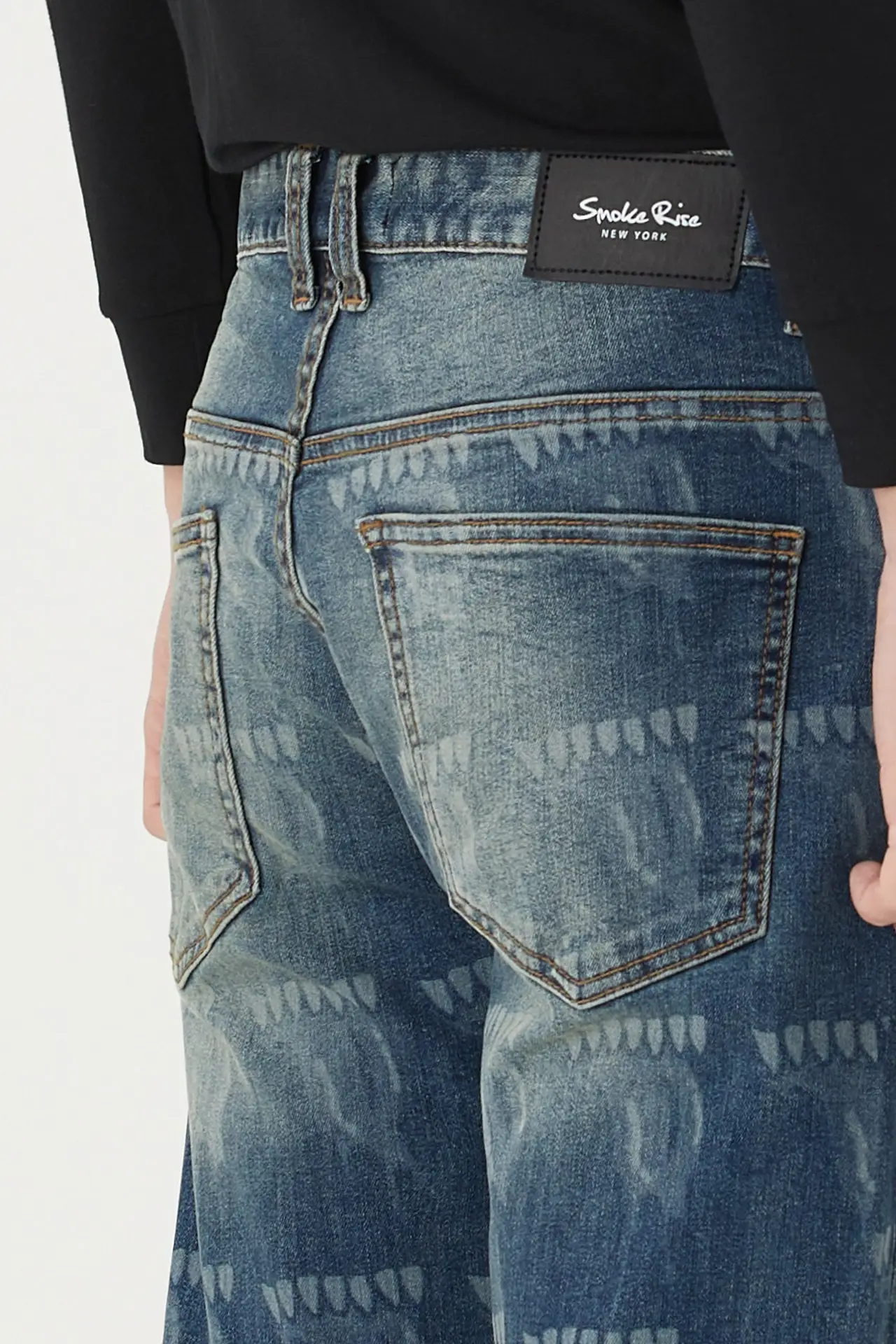
Source: Smoke Rise
Enter the world of laser printing—a high-tech marvel! This method uses lasers to etch intricate designs onto denim, producing clean, detailed patterns while reducing water waste, making it an eco-friendly choice.
4. Digital printing
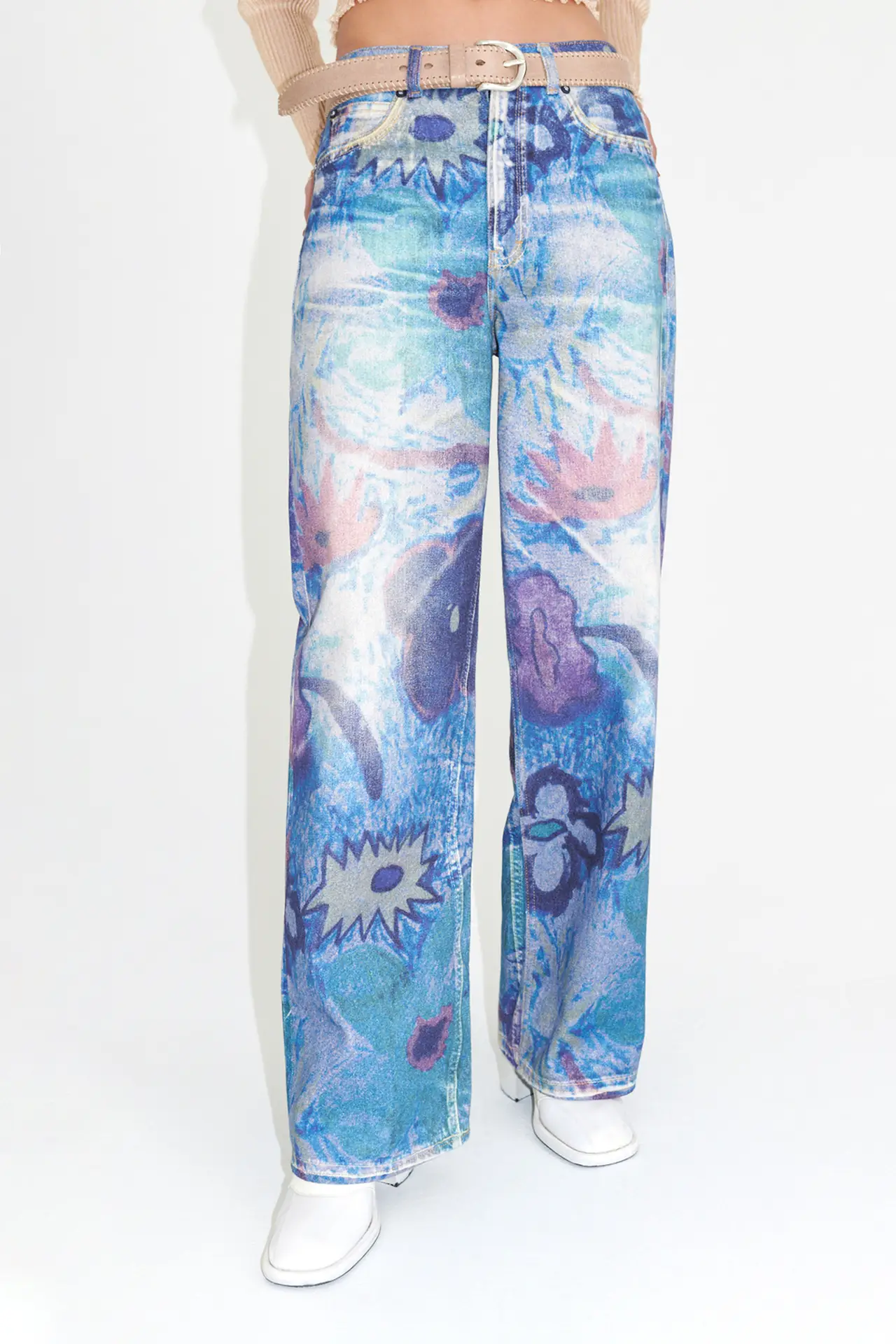
Source: Our Legacy
Digital printing is the artist’s dream come true. Inkjet technology prints vivid patterns directly onto denim, offering endless customization. From bold graphics to subtle designs, it makes each piece unique, ideal for small batches and personal flair.
5. Embossing
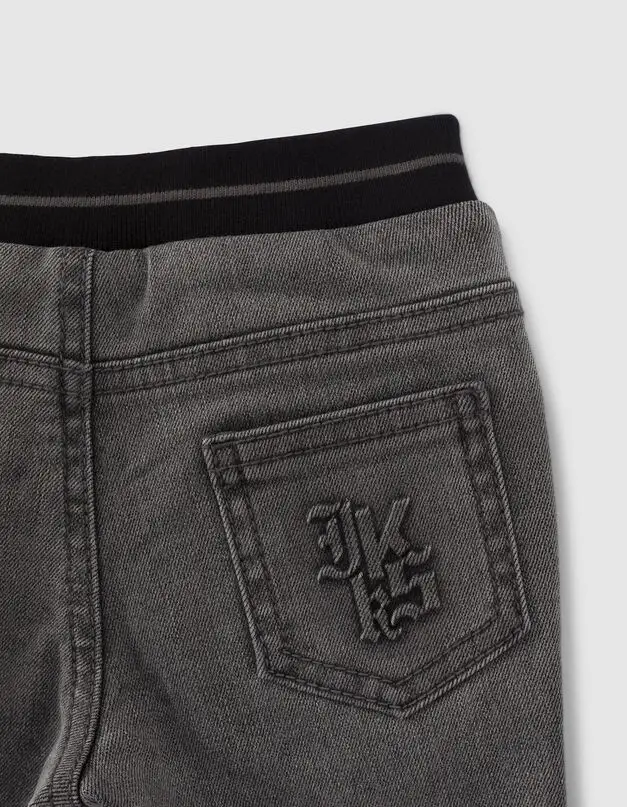
Source: IKKS
Embossing transforms flat fabric into a textural masterpiece. Heat and pressure create raised patterns that add depth and dimension. The result? Textured, eye-catching jeans that stand out from the crowd.
6. Hand painting
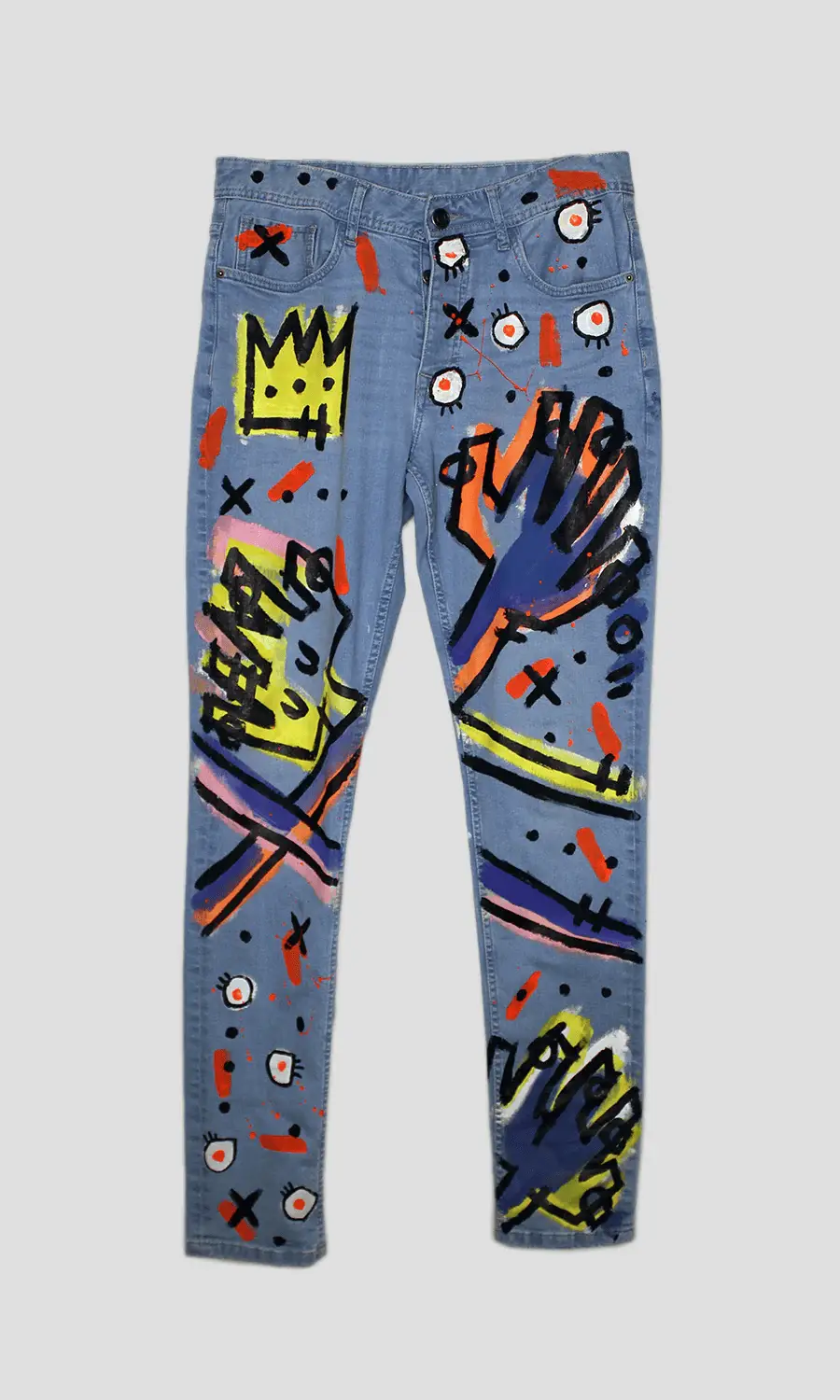
Source: Patricia Field ARTFASHION
Hand painting brings a personal touch to denim. Brushes and dyes come together to craft unique, artistic designs directly on the fabric.
With textile dyes offering vibrant, long-lasting results, hand painting adds character and creativity to every pair of jeans.
Different types of garment washing for jeans
Washing jeans isn’t just a process—it’s an art. Discover how different washing techniques can transform your jeans into unique pieces.
Mechanical washing
Mechanical washing relies on physical methods to modify the jean’s texture and appearance.
1. Normal wash
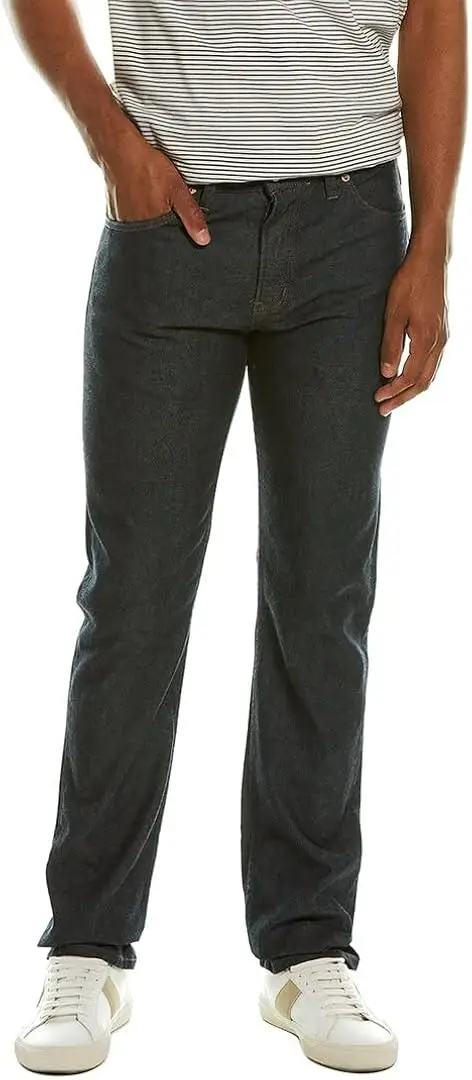
Source: Ubuy
The classic clean-up—jeans are washed with water and detergent, softening the fabric and removing excess dye. This foundational wash is perfect for giving denim a pre-loved feel while avoiding unwanted shrinkage.
2. Stone wash

Source: Zalora
Pumice stones meet denim in this process, creating a rugged, vintage look. The abrasion softens the fabric, making new jeans feel worn-in and comfortable.
3. Whiskering

Source: Styli
Faded lines around the thighs and crotch mimic natural wear patterns. This technique, often achieved with hand-brushing or lasers, adds a stylish, lived-in appearance to your jeans.
4. Sandblasting
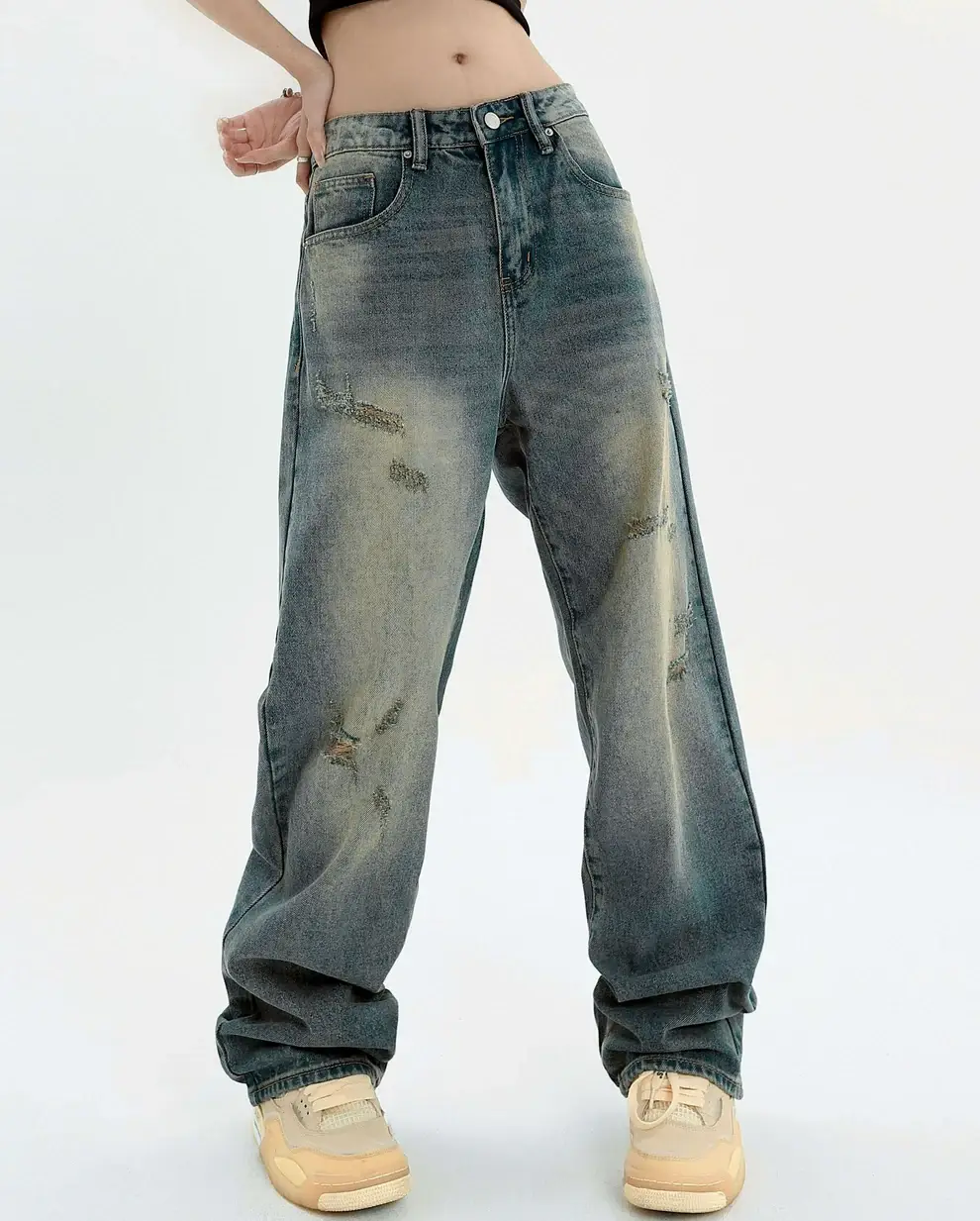
Source: Nightcity Clothing
Blasting sand onto denim gives it a heavy, distressed look. This method wears down the fabric, creating a rugged, old-school vibe that’s both striking and water-free.
5. Destroy wash
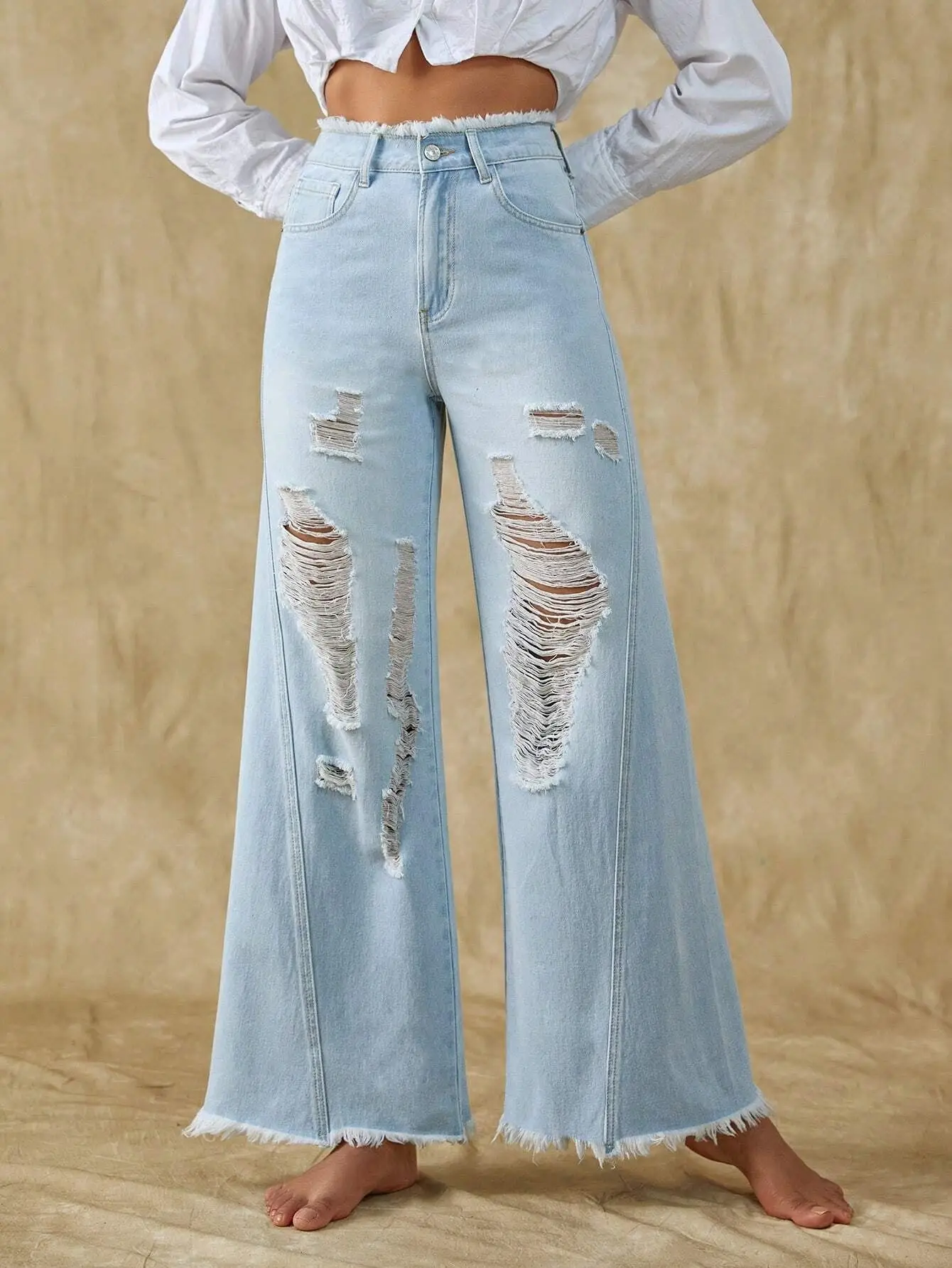
Source: Carry Me PH
Intentional tears and distressing, often combined with other washes, make jeans look authentically worn-out. This technique adds rebellious character and an edgy charm to your denim.
Chemical washing
Chemical washing uses agents to modify the color and feel of jeans, adding unique effects.
1. Acid wash

Source: Prettylittlething
Acid wash creates bold contrasts and marbled effects by mixing pumice stones with acids. It’s ideal for a dramatic, eye-catching style.
2. Snow wash
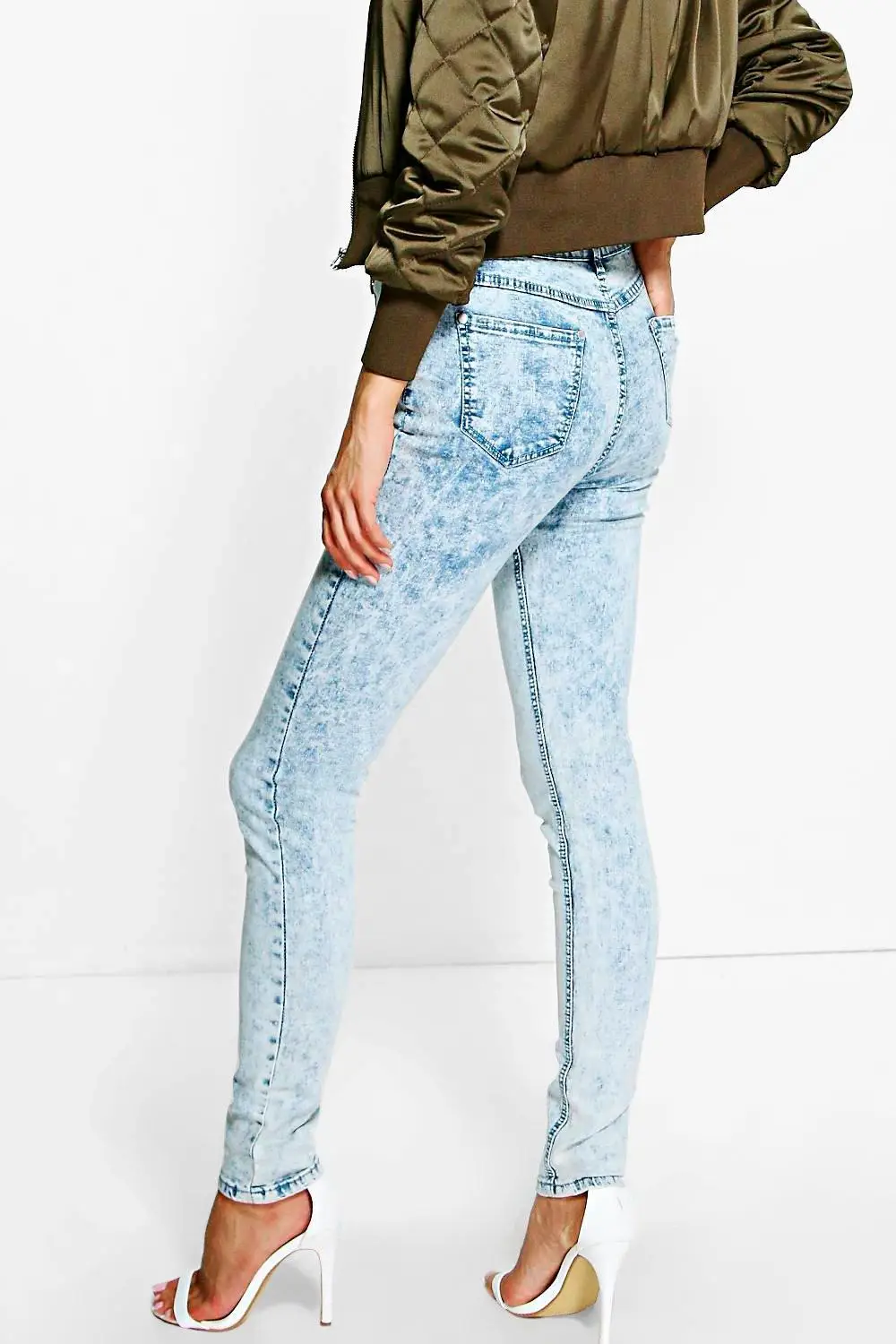
Source: boohoo
For a frosty, subtle fade, snow wash uses special chemicals to achieve a softer, cooler look on denim.
3. Bleach wash
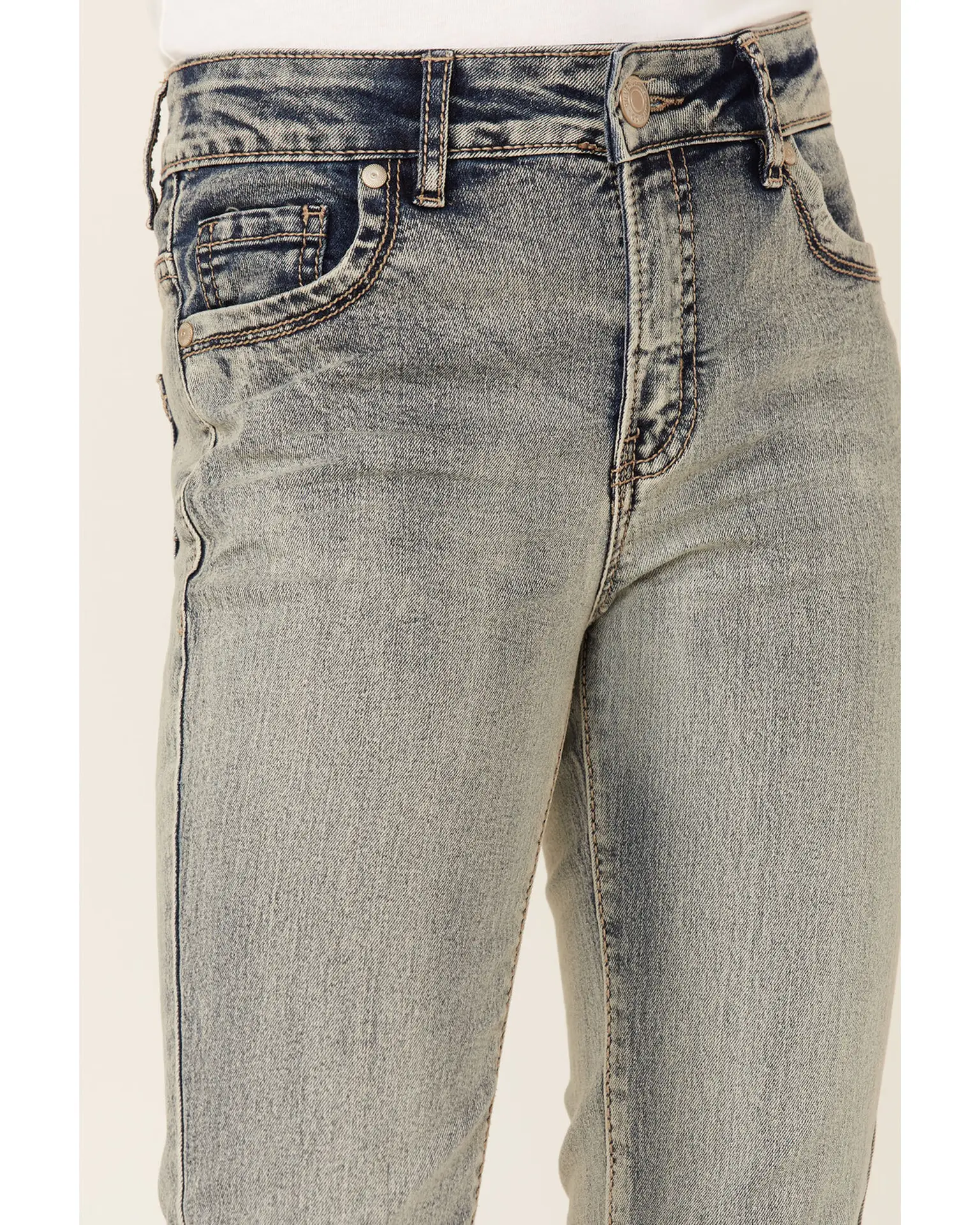
Source: Sheplers
Bleach wash lightens denim to a nearly white hue, perfect for creating patterns or an overall bright look.
4. Enzyme wash
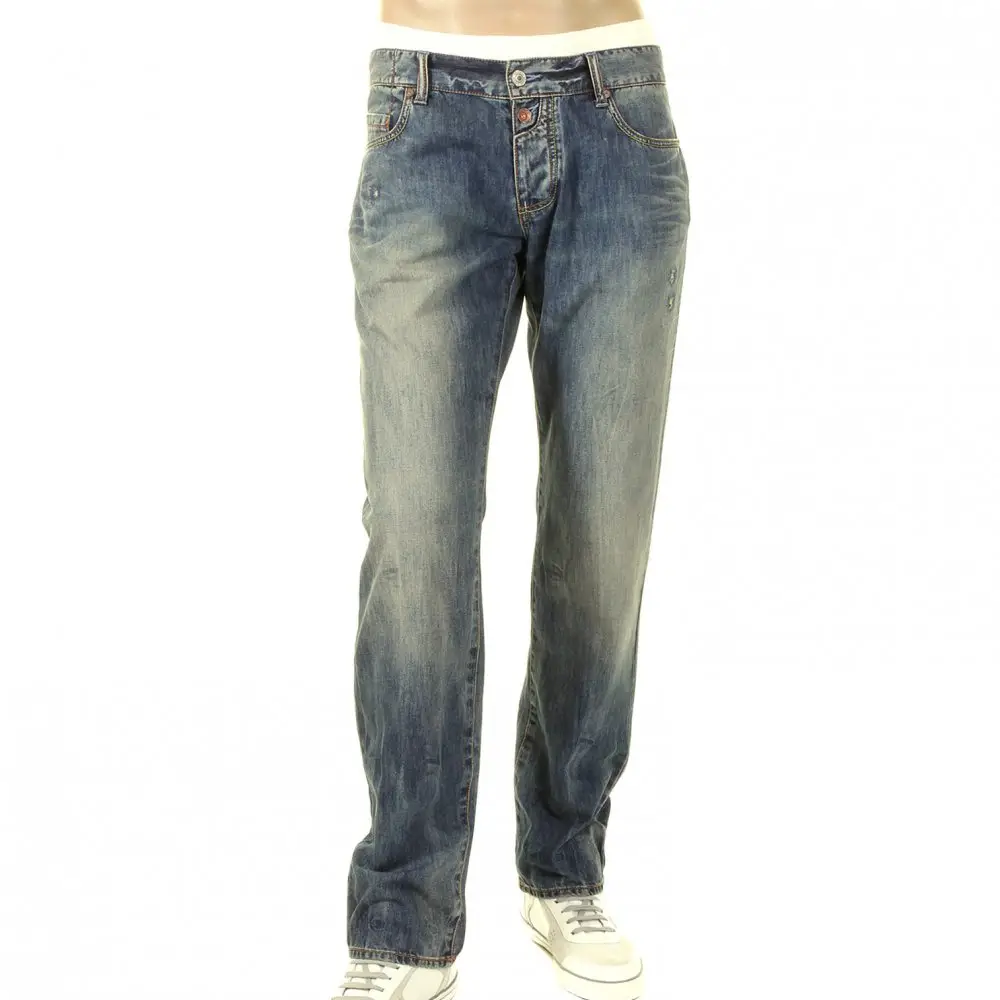
Source: Niro Fashion
Enzyme washing softens denim, giving it a smooth, worn-in look. By using natural enzymes to break down cotton fibers, this eco-friendly method achieves a vintage appearance.
5. Ozone fading
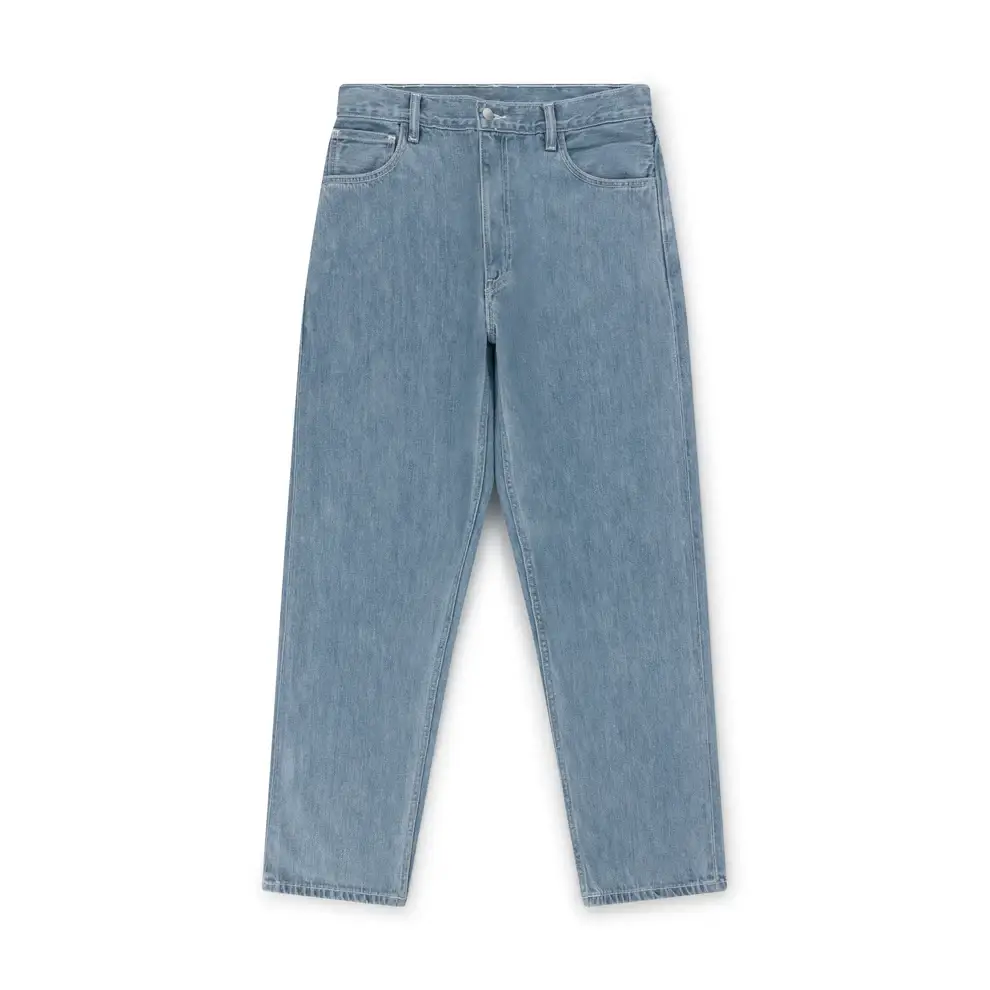
Source: non
Ozone gas fades denim without water or harsh chemicals, offering a sustainable, eco-friendly approach to achieving a faded look.
Fabric dyeing technique for jeans
Dyeing jeans offers endless possibilities, each technique adding a unique touch to elevate denim. Let’s explore some methods that bring color and life to your jeans.
Mechanical dyeing techniques
These techniques rely on physical processes to imbue jeans with color.
1. Indigo dyeing
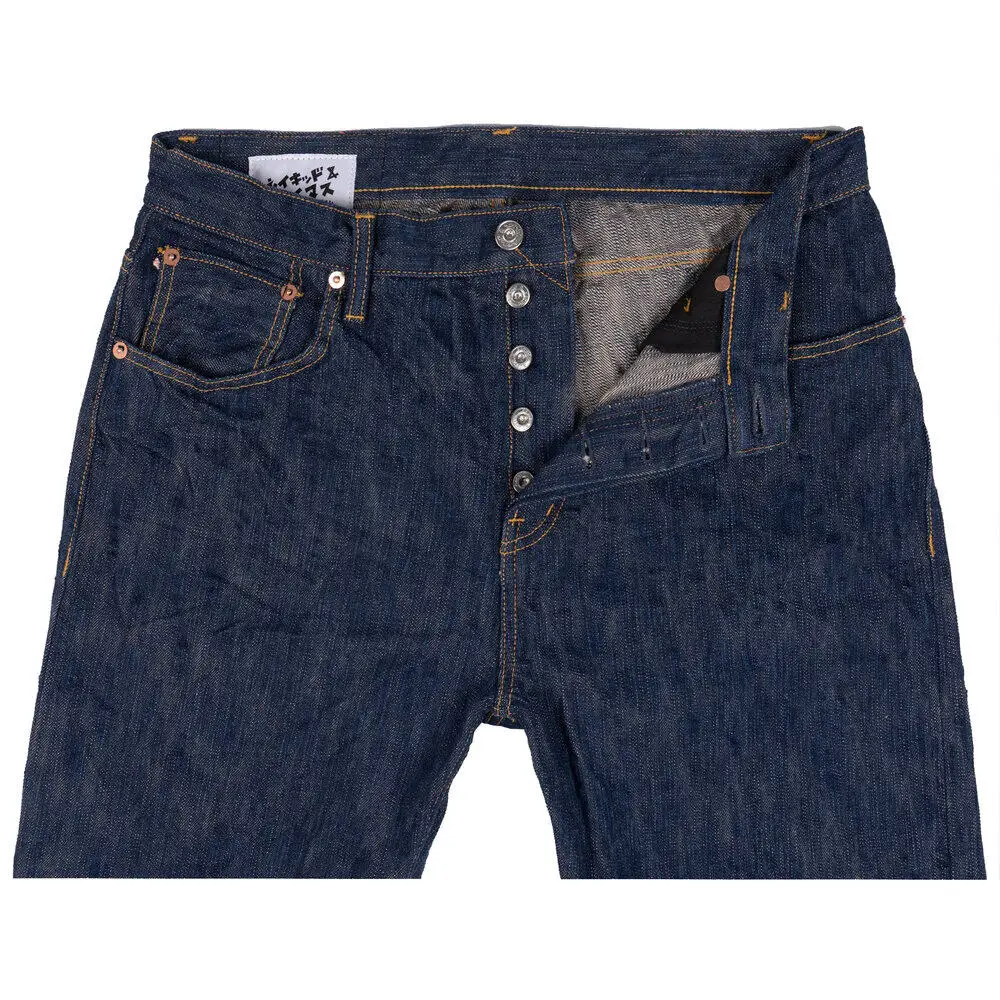
Source: Naked & Famous
The classic blue! Indigo dyeing immerses fabric in indigo dye, repeating the process with periods of oxidation between dips. This method delivers the deep, sought-after blue that denim enthusiasts love.
2. Rope dyeing
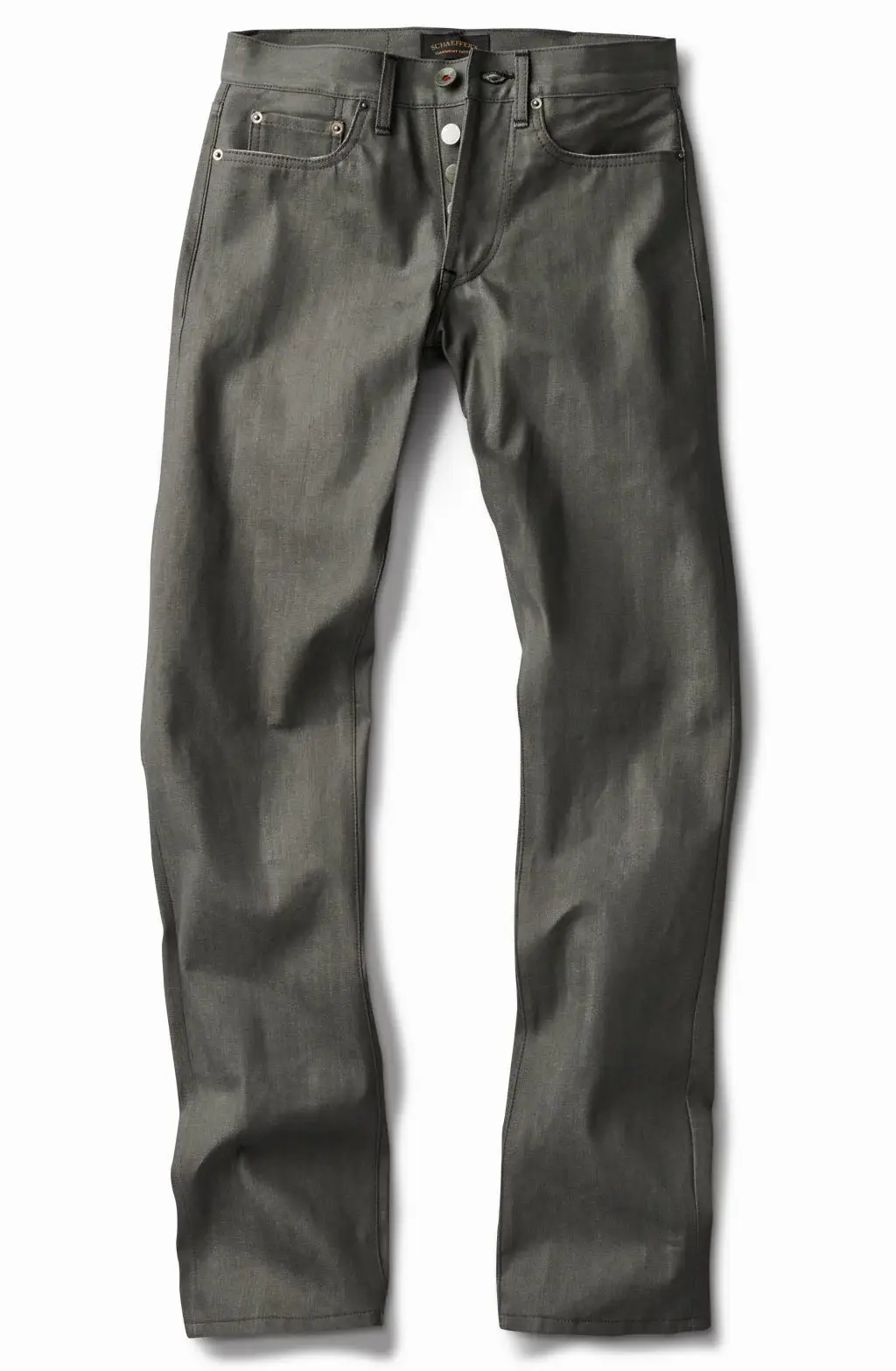
Source: Schaeffers Garment Hotel
Yarn is twisted into ropes before being dyed, ensuring even color penetration. It’s a method prized for producing high-quality denim with vibrant, consistent tones.
Chemical dyeing techniques
Chemical reactions come into play to achieve specific effects.
1. Reactive dyeing

Source: Cycle
A chemical bond forms between the dye and fabric during this technique, ensuring vibrant and durable colors. With a range of hues available, this method excels at creating long-lasting, striking shades.
2. Sulfur dyeing
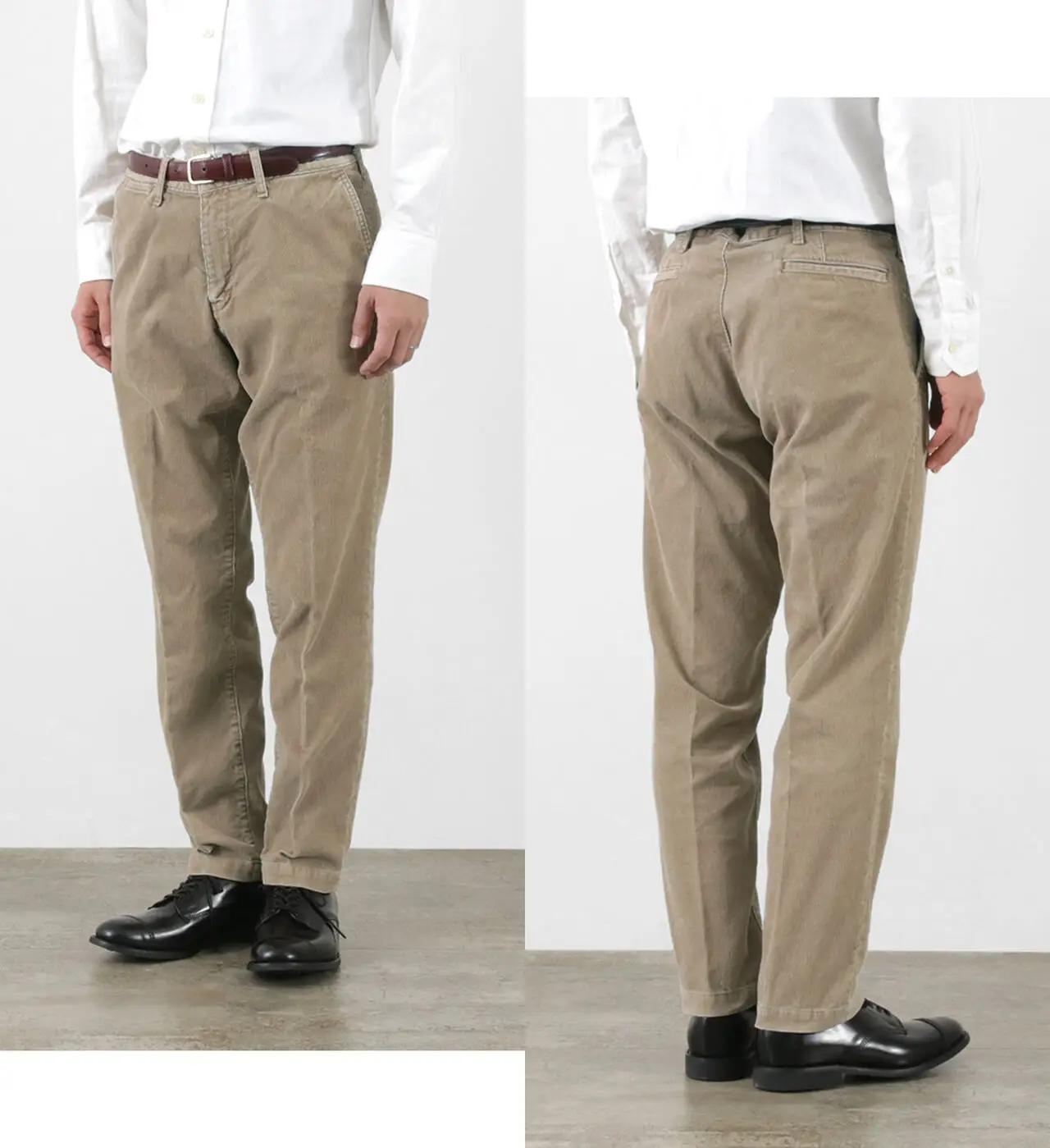
Source: haku clothing
Perfect for those darker shades like blacks and browns, sulfur dyeing is a go-to for creating a vintage or worn look with depth and character.
3. Pigment dyeing
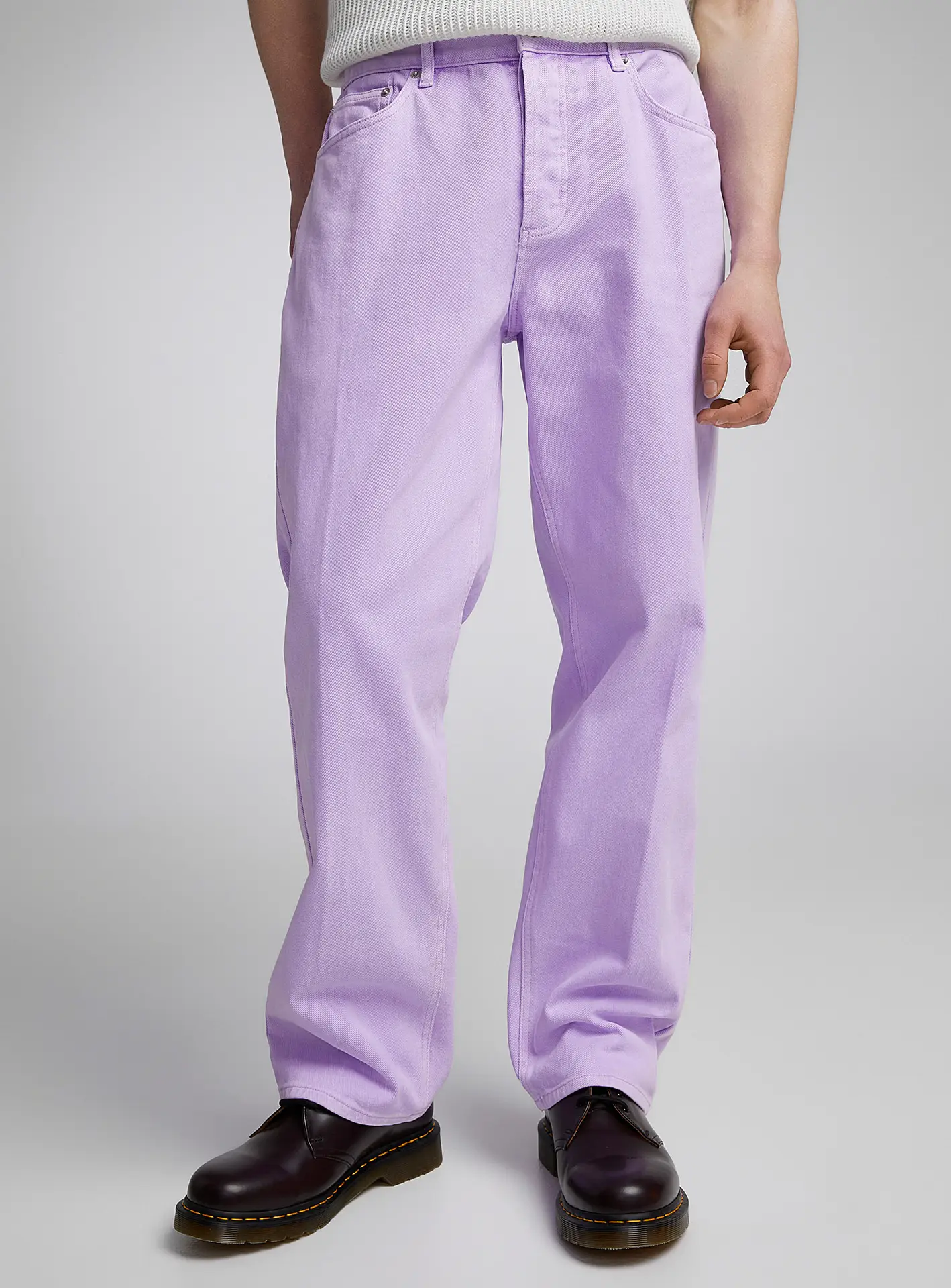
Source: Simons
Pigments are applied to the fabric’s surface, creating unique patterns and effects that stand out. This technique adds a layer of creativity to denim dyeing.
4. Acid dyeing
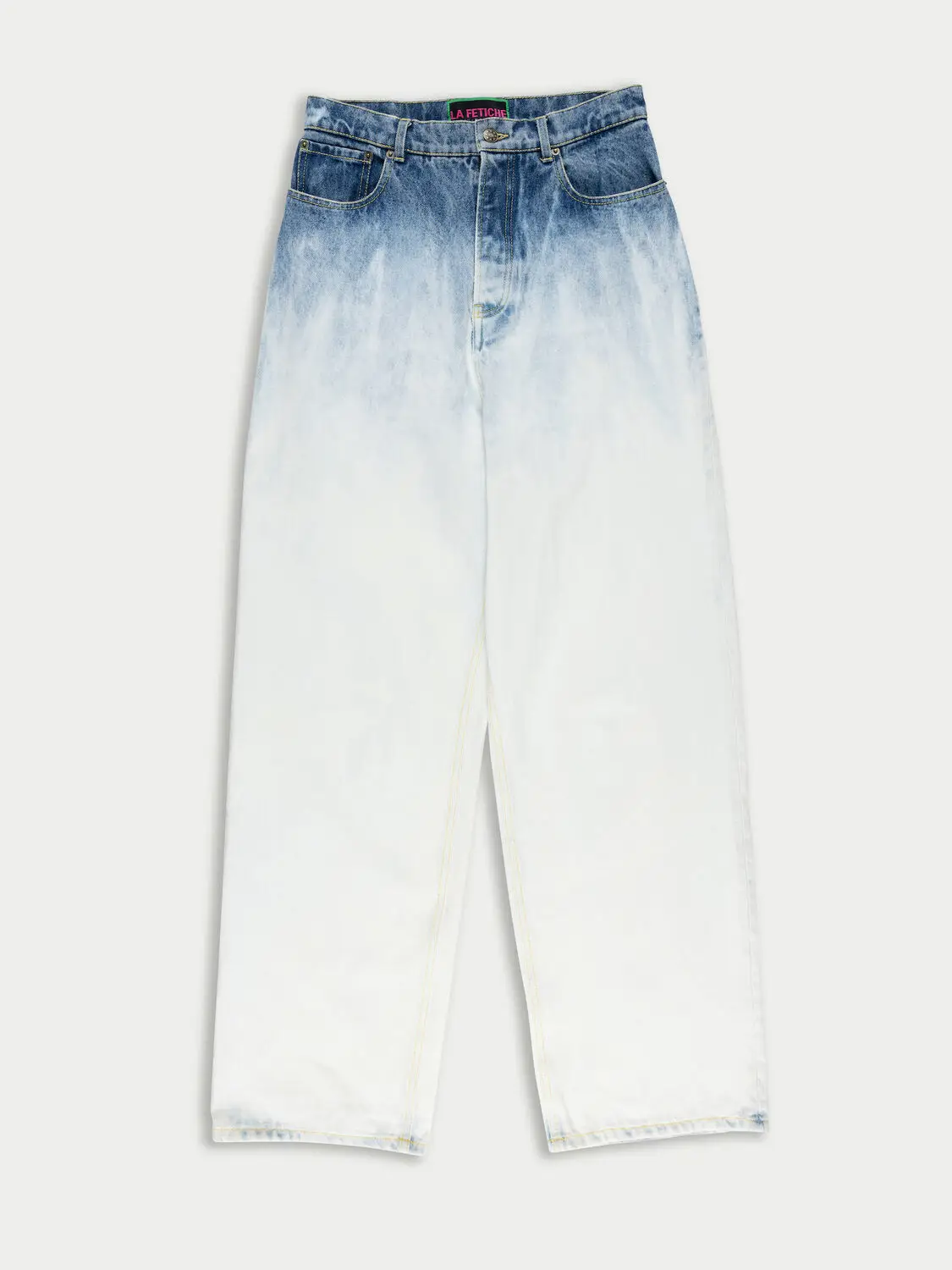
Source: LA FETICHE
Ideal for synthetic blends, acid dyeing produces vibrant, bold colors that pop, making it a favorite for more experimental designs.
Natural dyeing techniques
These methods use natural sources to color jeans, offering a sustainable approach.
1. Vegetable dyeing
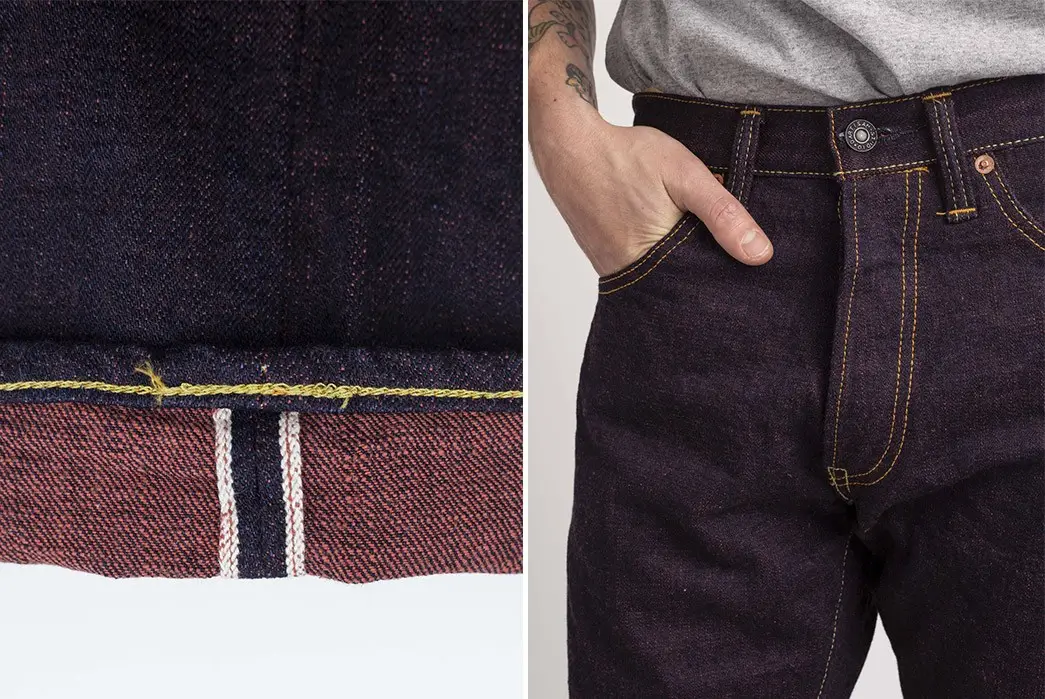
Source: Heddels
Extracted from plants like indigo, madder, or turmeric, vegetable dyes produce earthy tones that connect your jeans to nature.
2. Mineral dyeing
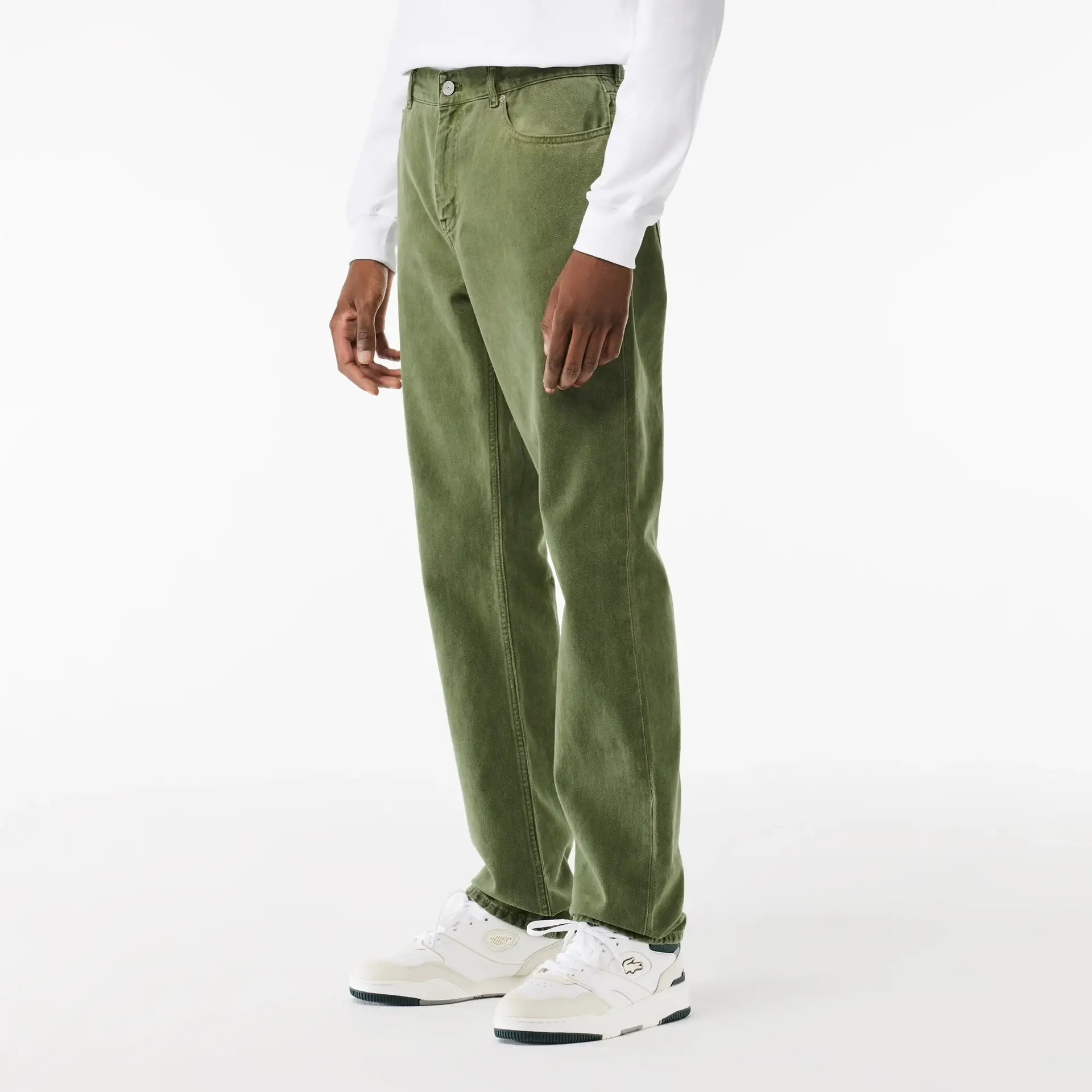
Source: Lacoste
Using minerals like iron or copper, this technique creates unique, natural hues that are as distinct as they are beautiful.
Creative dyeing techniques
These techniques embrace creativity and individuality.
1. Tie-dye
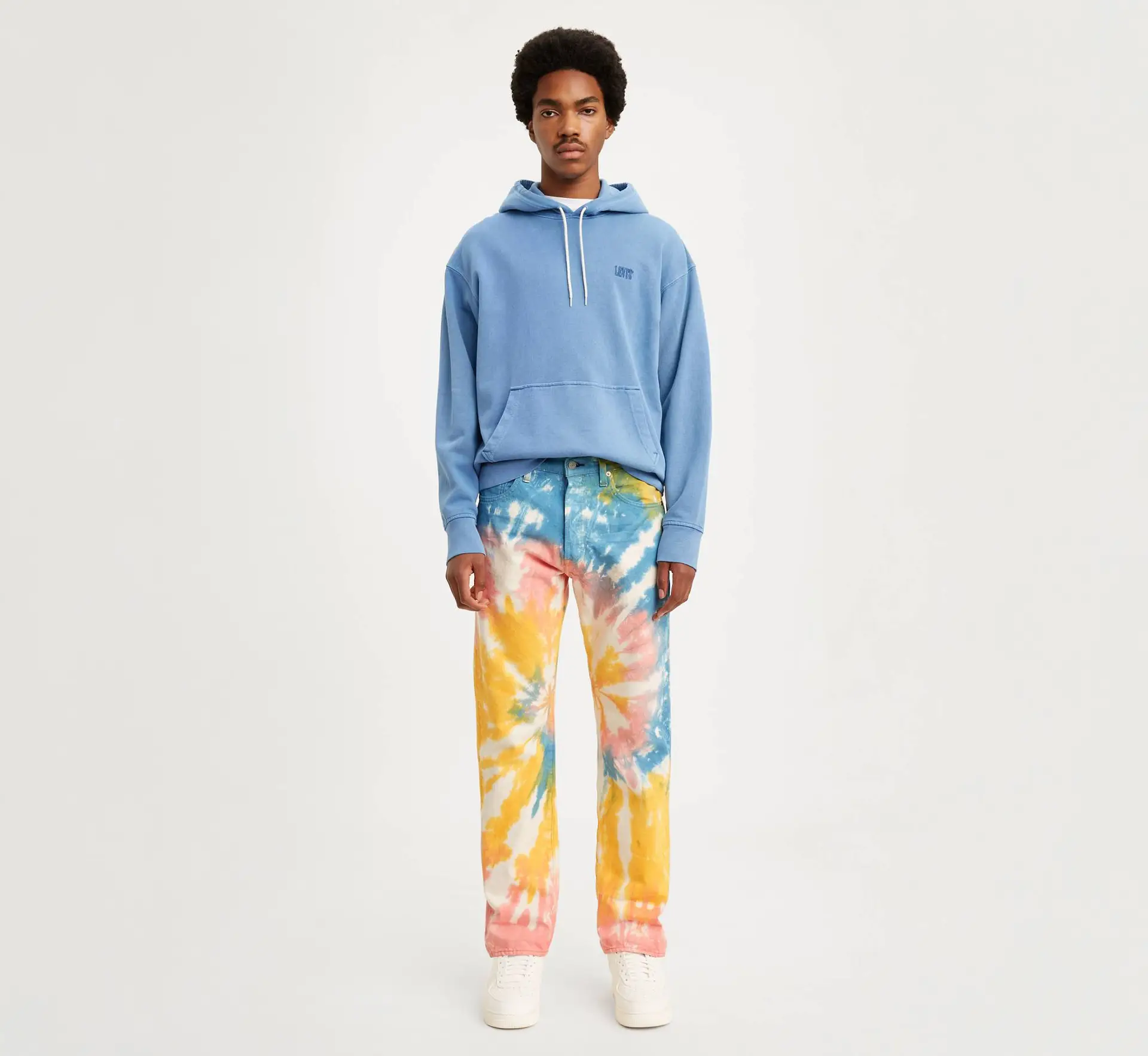
Source: Levi Strauss & Co.
A playful technique where fabric is tied in patterns before dyeing, resulting in vibrant, multi-colored designs that scream personality.
2. Ombre dip dye

Source: ArchiveThreads
The fabric is dipped to create a gradient effect, smoothly transitioning from light to dark or vice versa—a visual treat that adds a modern twist to traditional denim.
These are just a few of the techniques that breathe life into jeans. The right dye for your jeans depends on factors like colorfastness, saturation, and the fabric type. So, embrace the journey—your jeans are waiting to be dyed with imagination!
Quality control measures
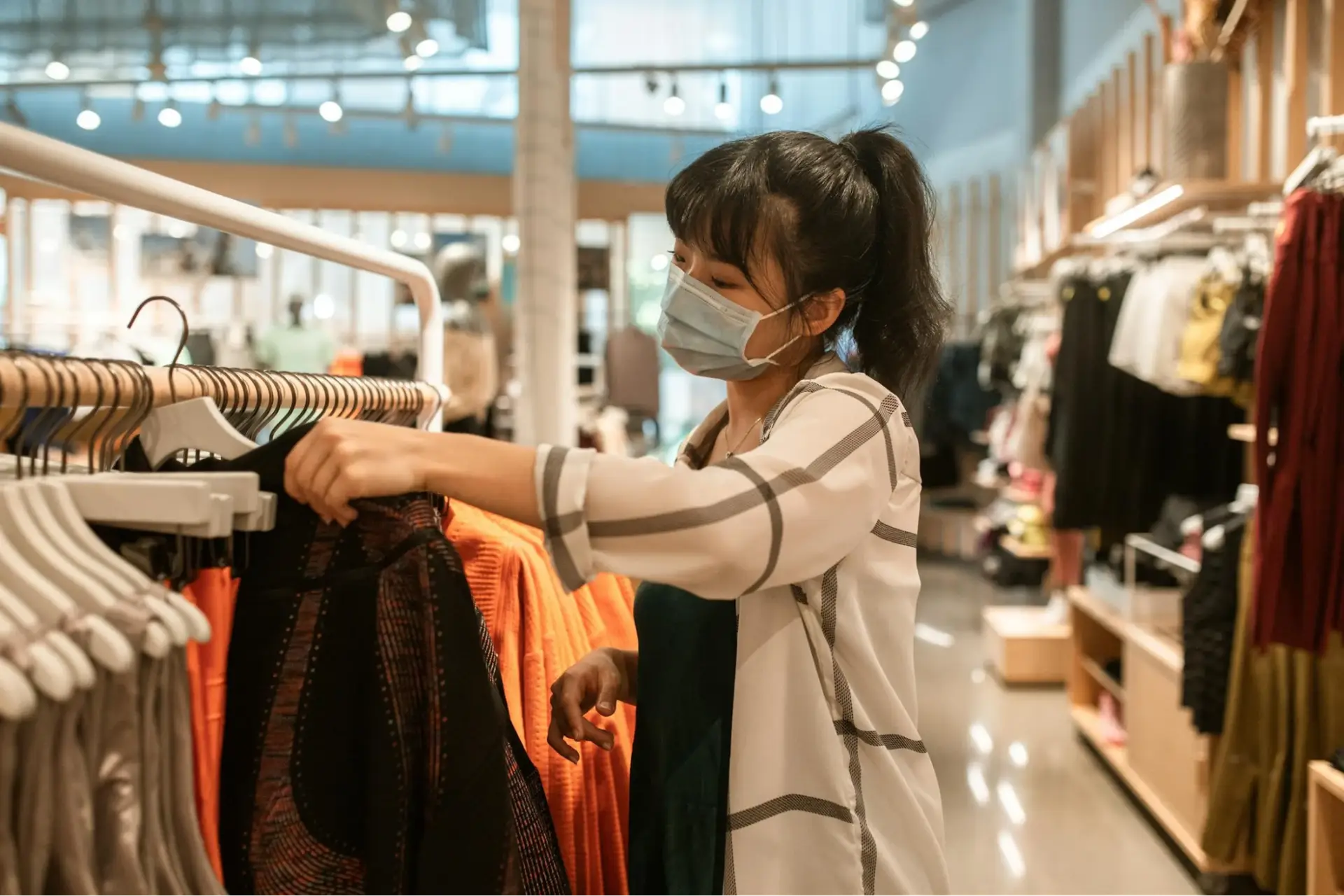
Quality is non-negotiable. Ensuring that every pair meets high standards of fit, durability, and appearance is essential to delivering a product that stands out.
-
Perfecting fit
It all starts with precise pattern making. Patterns are graded for consistent sizing across various sizes, and size set samples ensure a uniform fit before production. Random garments are checked for key measurements, and pre-washing controls shrinkage to maintain accuracy.
-
Maintaining excellence
Quality checks begin with inspecting denim for defects like uneven dyeing or weaving flaws. Seam strength and stitching consistency are tested to ensure durability, while finishing touches like zippers and hems are inspected before packaging.
Packaging and branding

Source: ESKA
Packaging and branding in jeans manufacturing are vital, shaping customer impressions and reinforcing brand identity.
-
Packaging unveiled
Custom boxes elevate jeans with luxury designs. Eco-friendly materials, like recycled cardboard, appeal to conscious consumers. Inside, tissue paper and branded bands add sophistication. Logos and colors on packaging make the brand instantly recognizable.
-
Signature branding
Brand identity shines through every detail—leather patches, woven labels, and branded buttons. Pocket flashers and hangtags offer both information and branding, ensuring the product reflects the brand’s values.
These thoughtful touches in packaging and branding ensure happy customers, strengthen market presence, and contribute to overall success.
Conclusion
Finding the ideal jeans manufacturer for your startup means choosing someone who gets your vision and executes it flawlessly. From selecting premium denim to meticulous quality checks, every detail matters in crafting jeans that truly resonate with customers.
Ready to turn your vision into reality? Whether launching a new brand or refining an existing one, expert assistance is just a message away—contact us today!

